Confronting Risk in Implant Surgery A Compressed Nerve
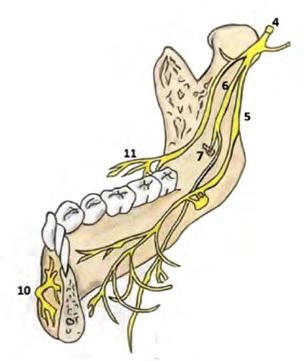
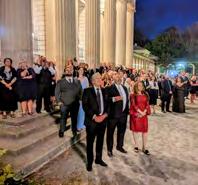
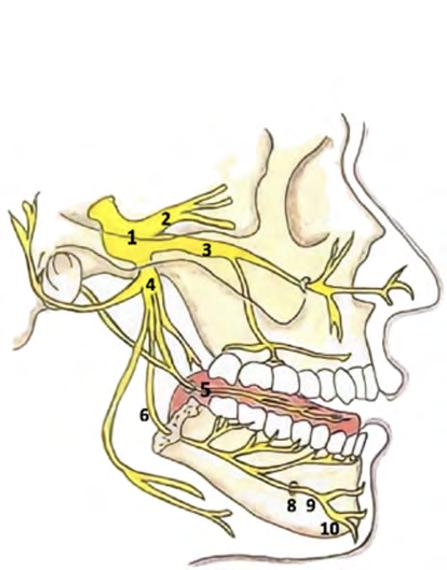
Numbe r5
2023 Some Enchanted Evening the new york state dental journal
Volume89
August/September
Inside: Are Covenants Not to Compete about to Disappear?
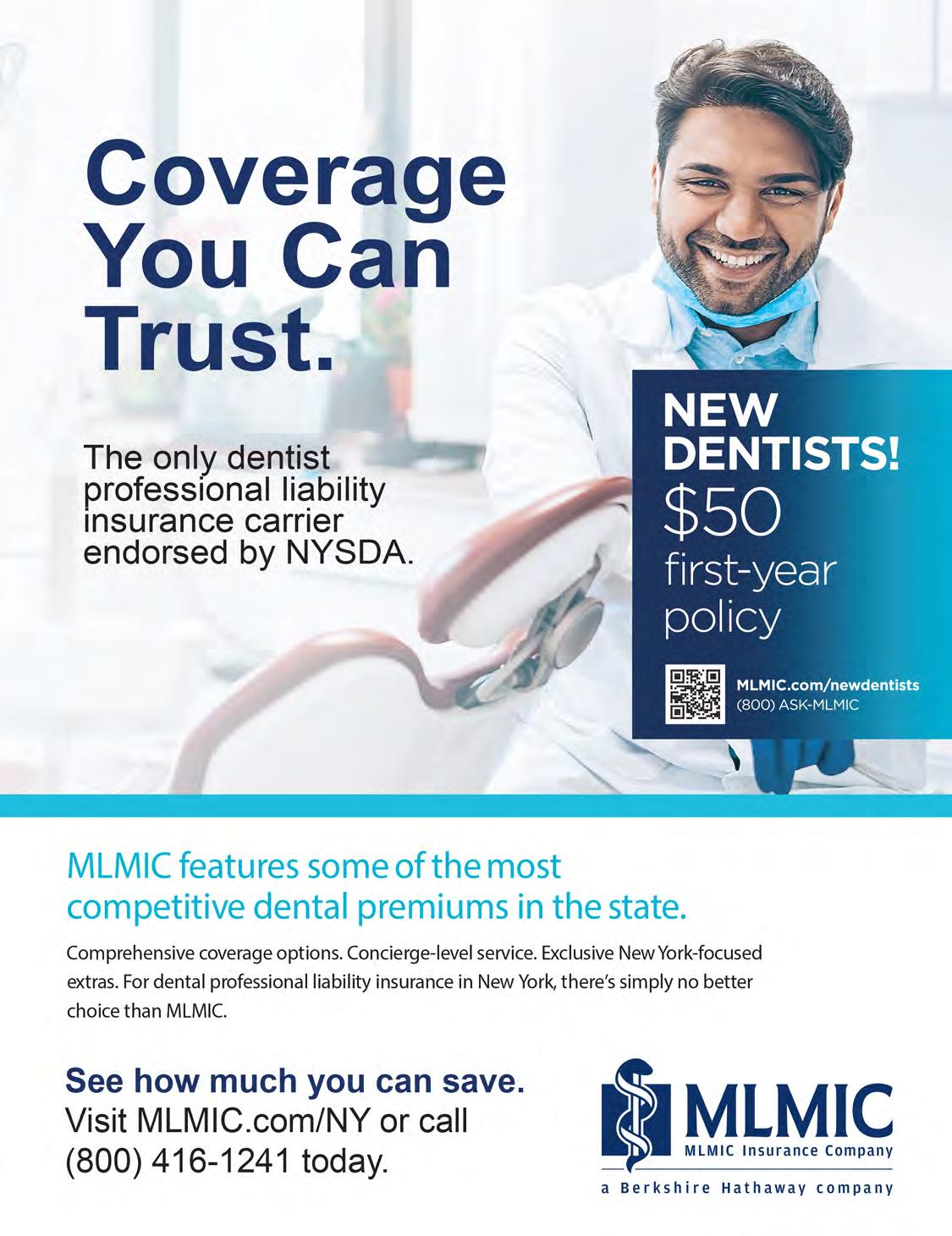
Cover: By all indications, the implant surgery should have been complicationfree. A compressed nerve was an unforeseen development.
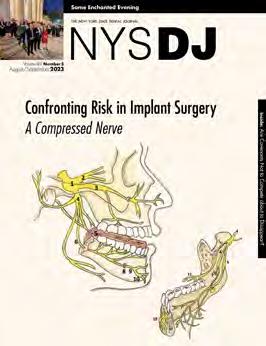
26 Iatrogenic Indirect Compression of the Inferior Alveolar Nerve by a Dental Implant
Wesam Talal Alsalman, D.D.S., M.D.S.; Saad Mulhi Alharbi, B.D.S., S.B. E.; Haifa Alharbi, B.D.S.; Heba Alkhair Allah, B.D.S.; Marwan Abood, B.D.S., J.B.P.; Abeer Hani Albattah, D.D.S., M.D.S.; Khalid Almas, B.D.S., MSc., FDSRCS, FRACDS, DDPH.RCS
Patient who experienced numbness and burning sensation in lip, chin and buccal mucosa following implant placement provided insight into little-reported instance of indirect compression of inferior alveolar nerve. (Case report)
32 Use of Dentoalveolar and Zygomatic Implants in Restoration of Maxillary Defect Following Fibula Free-flap Reconstruction Failure
Paul Canallatos, D.D.S., M.S.; Thom Loree, M.D.; Amanda Colebeck, D.D.S., M.S.; Maureen Sullivan, D.D.S.
Oral cancer resections cause tissue defects which result in functional complications. Elderly male patient diagnosed with squamous cell carcinoma of right alveolar ridge presented such a challenge. Clinicians were, nevertheless, able to achieve successful outcome. (Case report)
38 Flapless Approach to Dental Implant Surgery To Use or Not to Use?
Rebecca Skaf, D.D.S.; Kenneth Parrera, D.D.S.; Abhiram Maddi, D.D.S., M.Sc., Ph.D. Authors discuss benefits and risks of flapless surgery as compared to traditional approach and provide step-by-step approach to flapless implant placement.
The New York State Dental Journal is a peer reviewed publication. Opinions expressed by the authors of material included in The New York State Dental Journal do not necessarily represent the policies of the New York State Dental Association or The New York State Dental Journal. EZ-Flip version of The NYSDJ is available at www.nysdental.org and can be downloaded to mobile devices.
Volume 89 Numbe r 5
the new york state dental journal
Editorial Are you “getting it?”
Attorney on Law Righting an employment wrong 12 Association Activities 46 General News 50 Component News
Read, Learn, Earn
Classifieds
Index to Advertisers
Addendum
Educated
August/September 2 023
2
6
62
63
64
66
Highly
Eyes on the sky photo by Michael Herrmann
Dentistry Must Continue to ‘Get It’ or ‘Lose It’
Participants in all aspects of the dental profession must understand our unique roles to succeed as leaders in our joint mission to meet society’s oral health needs.
He or she “gets it.” As dental practice owners, we often bestow this compliment upon an outstanding team member. “Getting it” connotes that this employee understands why their position exists, their unique role in the bigger picture, to whom and for what they are accountable, and the consequences of their failure to perform. The inability or unwillingness of a staff member to appreciate these realities reduces their effectiveness and could cost them their job.
Practicing dentists, along with clinical and administrative staff, dental educators and school administrators, dental researchers and journalists, and organized dentistry members all face the same expectation to “get it” and keep serving our country’s oral health needs or lose our professional autonomy and leadership authority.
Dental Practice Team
Practicing dentists and staff who “get it” understand that we exist to serve our patients and community. We help human beings manage their own oral health as part of their general health and within the framework of their individual life circumstances. We firmly avoid the self-serving concept that patients exist primarily as profit centers to serve our business plan. Our staff appreciates that although the practice owner signs their paycheck, our patients, through their decisions to continue care with our office, indirectly pay staff salaries. Togeth-
er, we pledge to unequivocally place patients’ best interests above our own.
Dentists stand accountable to deliver standard-of-care treatment to patients regardless of third-party payer cost-control tactics or business overhead financial demands. We fully recognize that the consequences of our failure to meet the standard of care impair not only the oral health but, potentially, the general health and personal lives of those we serve. Hence, we educate our patients as to what dentistry can do for them, make ourselves available to do it and ensure it is done right.
The increased commercialization and corporate control of dental practice often produces practitioners and team members who do not “get it.” Although the business principles that dental service organizations apply can effectively serve patients, too often abuses of this model elevate corporate interests above patients’ best interests. As society observes that many dentists no longer “get it,” government will increasingly regulate dental practice more as a commercial entity and we will gradually lose our privilege to self-regulation and autonomous decision-making authority.
Dental Educators and Administrators
“Getting it” for dental school faculty requires that they focus on teaching students the principles and skills necessary to graduate practicing dentists who “get it.” Educators must prioritize
editorial
2 AUGUST/SEPTEMBER 2023 . The New York State Dental Journal
teaching over research, administrative tasks and career enhancement. Faculty must present unbiased scientific truths free from conflicts of interest with funding sources, manufacturers, suppliers and other faculty or researchers.
School administrators exist primarily to enable faculty to teach and students to learn. They must develop fair admission policies that educate applicants on the challenges of a career in dentistry. Importantly, they must control operating costs, tuition and student debt through decreased spending on nonteaching expenses. Concomitantly, students who “get it” appreciate that it is a privilege, not a right, to prepare and serve as a dentist and, as a result, respect and dedicate themselves to the learning process and patient service.
Dental school tuition increases unrelated to teaching effectiveness, soaring dental student debt, and manufacturers’ and vendors’ biased influence on school curricula expose faculty and administrators who do not “get it.” These destructive conditions impair schools’ ability to graduate students who “get it.” After all, if students discover that their school operates more as a proprietary institution for the benefit of its employees and corporate investors, prioritizing the school over the student and profit over education, graduates will less likely embrace their expected role of placing patients’ interests above their own. Schools that do not “get it” will soon resemble trade schools and lose their professional status.
Dental Researchers and Journalists
Dental researchers and journalists exist to search for and report the truth. Researchers and journalists that “get it” ensure that our dental literature provides evidence-based, unbiased expert information and engages in open scientific debate with dissenting opinions to determine the credibility of oral health information. They remain accountable to educators, practicing dentists and patients to provide the information they need to make informed decisions.
Researchers and journalists who do not “get it” treat scientific research and its reporting as a marketable product sold for profit. They place their own financial interests above their professional and public service duties to search and report the truth. The consequences of this failure include weakened and misleading dental literature with a distorted evidence base.
Dentists’ reliance upon potentially incomplete or incorrect data can lead to clinical errors and substandard care. It can also compromise the information dentists present to patients, placing the practitioner in the position of providing “misinformed consent” or consent based upon misinformation. Dental researchers and journalists will lose their status as the source of oral health information if they fail to “get it.”
EDITOR
Chester J. Gary, D.D.S., J.D.
MANAGING EDITOR
Mary Grates Stoll
ADVERTISING/SPONSORSHIP MANAGER
Jeanne DeGuire
ART DIRECTOR
Ed Stevens
EDITORIAL REVIEW BOARD
Frank C. Barnashuk, DDS. Clinical Assistant Professor, Department of Restorative Dentistry, School of Dental Medicine, University at Buffalo, The State University of New York, Buffalo, NY.
David A. Behrman, DMD. Chief, Division Dentistry/OMS, Associate Professor of Surgery, New York Presbyterian Hospital, Weill Cornell Medicine, New York, NY.
Michael R. Breault, DDS. Periodontic/Implantology Private Practice. Schenectady, NY.
Alexander J. Corsair, DMD. Periodontic/Implantology Private Practice. Rockville Centre, NY.
Joel M. Friedman, DDS. Associate Clinical Professor Dental Medicine. Columbia University College of Dental Medicine, New York, NY.
Jennifer Frustino, DDS, PhD. Director, Oral Cancer Screening and Diagnostics, Division Oral Oncology and Maxillofacial Prosthetics, Department of Dentistry, Erie County Medical Center, Buffalo, NY.
Michael F. Gengo, DDS. Board-certified Endodontist, Clinical Assistant Professor, Department of Endodontics, School of Dental Medicine, University at Buffalo, The State University of New York, Buffalo, NY.
G. Kirk Gleason, DDS. General Dental Practice, Clifton Park, NY.
Kevin Hanley, DDS. Orthodontic Private Practice, Buffalo, NY.

Violet Haraszthy, DMD, DDS, MS, PhD, Professor, Chair, Department of Restorative Dentistry, School of Dental Medicine, University at Buffalo, The State University of New York, Buffalo, NY.
Stanley M. Kerpel, DDS. Diplomate, American Board of Oral and Maxillofacial Pathology, Associate director, Oral Pathology Laboratory, Inc. Attending, section of Oral Pathology, New York Presbyterian, Queens, NY.
Elliott M. Moskowitz, DDS, MSD. Diplomate American Board Orthodontics; Clinical Professor. Department Orthodontics, NYU College Dentistry; Orthodontic Private Practice, New York, NY.
Eugene A. Pantera Jr., DDS. Past Director, Division of Endodontics, Department of Periodontics and Endodontics, School of Dental Medicine, University at Buffalo, The State University of New York, Buffalo, NY.
Robert M. Peskin, DDS. Dental Anesthesiology Private Practice. Garden City, NY.
Robert E. Schifferle, DDS, MMSc, PhD. Professor Periodontics, Endodontics and Oral Biology. School of Dental Medicine, University at Buffalo, The State University of New York, Buffalo, NY.
Jay Skolnick, DMD. Board-certified pediatric dentist. Attending dentist, Rochester General Hospital. Private practice, Webster, NY.
PRINTER
Fort Orange Press, Albany
NYSDJ (ISSN 0028-7571) appears three times a year in print: January, March and June/ July. The April, August/September and November issues are available online only at www.nysdental.org. The Journal is a publication of the New York State Dental Association, 20 Corporate Woods Boulevard, Suite 602, Albany, NY 12211. In February, May, October and December, members have online access to the NYSDA News. Subscription rates $25 per year to the members of the New York State Dental Association; rates for nonmembers: $75 per year or $12 per issue, U.S. and Canada; $135 per year foreign or $22 per issue. Editorial and advertising offices are at Suite 602, 20 Corporate Woods Boulevard, Albany, NY 12211. Telephone (518) 465-0044. Fax (518) 465-3219. Email info@nysdental.org. Website www.nysdental.org. Microform and article copies are available through National Archive Publishing Co., 300 N. Zeebe Rd., Ann Arbor, MI 48106-1346.
THE NEW YORK STATE DENTAL JOURNAL
The New York State Dental Journal AUGUST/SEPTEMBER 2023 3
Organized Dentistry Members
Organized dentistry members “get it” when we embrace our role to elevate the public’s best interests above dentists’ collective interests as a profession. We recognize the dental profession can only continue to enjoy our privileges of selfregulation and professional autonomy if we collectively deliver affordable quality care to all Americans.
Organized dentistry members who do not “get it” view our tripartite association as a mere trade union that acts primarily on our own behalf to provide cost-saving benefits and services, and political advocacy. Nonmember dentists make no formal commitment to any collective professional responsibility or duty to self-regulate and take “not getting it” to the next level.
As a consequence, if our profession fails to meet society’s oral health needs, state governments will expand midlevel providers who can legally perform procedures previously limited to licensed dentists, allow nondentist practice ownership, and aspects of “do-it-yourself dentistry” in an effort to provide the access to care that the dental profession did not provide.
Patients’ and Society’s Role
Dentistry can “get it,” but will only succeed in delivering affordable, quality oral healthcare to all if our patients and our policy and lawmakers also “get it” and strive for the same goal. Patients must accept that no third party can bestow oral health upon them. Individuals must invest the time, money, hard work and the associated discomfort it takes to attain any goal and make oral health a priority. Our government must act to protect its citizens through necessary legislation. However, when lawmakers over-regulate and attempt to micromanage, they stand in the way of the dental experts their laws created to meet our oral health needs in the first place. For now, all components of the dental profession must control what we can and continue to “get it.”
EDITORIAL POSITION
THE NEW YORK STATE DENTAL JOURNAL is inviting applications from members of the New York State Dental Association interested in filling the position of Journal Associate Editor. The position is for one year, commencing January 2024. At the end of the year, the Associate Editor is expected to begin a two-year term as Editor, with the possibility of that term being extended by another three years.
The Associate Editor will be asked to assist the Editor in performing the following duties:
• Contribute relevant and cogent editorials.
• Solicit manuscripts from prospective authors/researchers.
• Find appropriate manuscript reviewers and manage the peer review process.
• Review manuscripts for clarity and accuracy and make final editorial decisions about manuscripts.
• Act as an ambassador for The Journal, with a vision to advance its standing and increase its impact.
Candidates for this position must possess and demonstrate the following skills:
• Strong writer.
• Organized; able to meet deadlines.
• Open to new concepts and methodologies.
• Understand or be willing to learn digital publishing and platforms, such as Digital Commons and Google Scholar.
D.D.S., J.D.
REFERENCES
1. Gary C. The Truth About the Truth. N Y State Dent J. 2022 June/July;88(4):2-4.

2. Gary C. Fake News in Dentistry: Misinformed Consent. N Y State Dent J. 2017 Mar;83(2):2-3.
Interested candidates are asked to email a letter of introduction, CV and writing samples to the Managing Editor by September 30. Address submissions to Ms. Mary Stoll mstoll@nysdental.org.
4 AUGUST/SEPTEMBER 2023 . The New York State Dental Journal
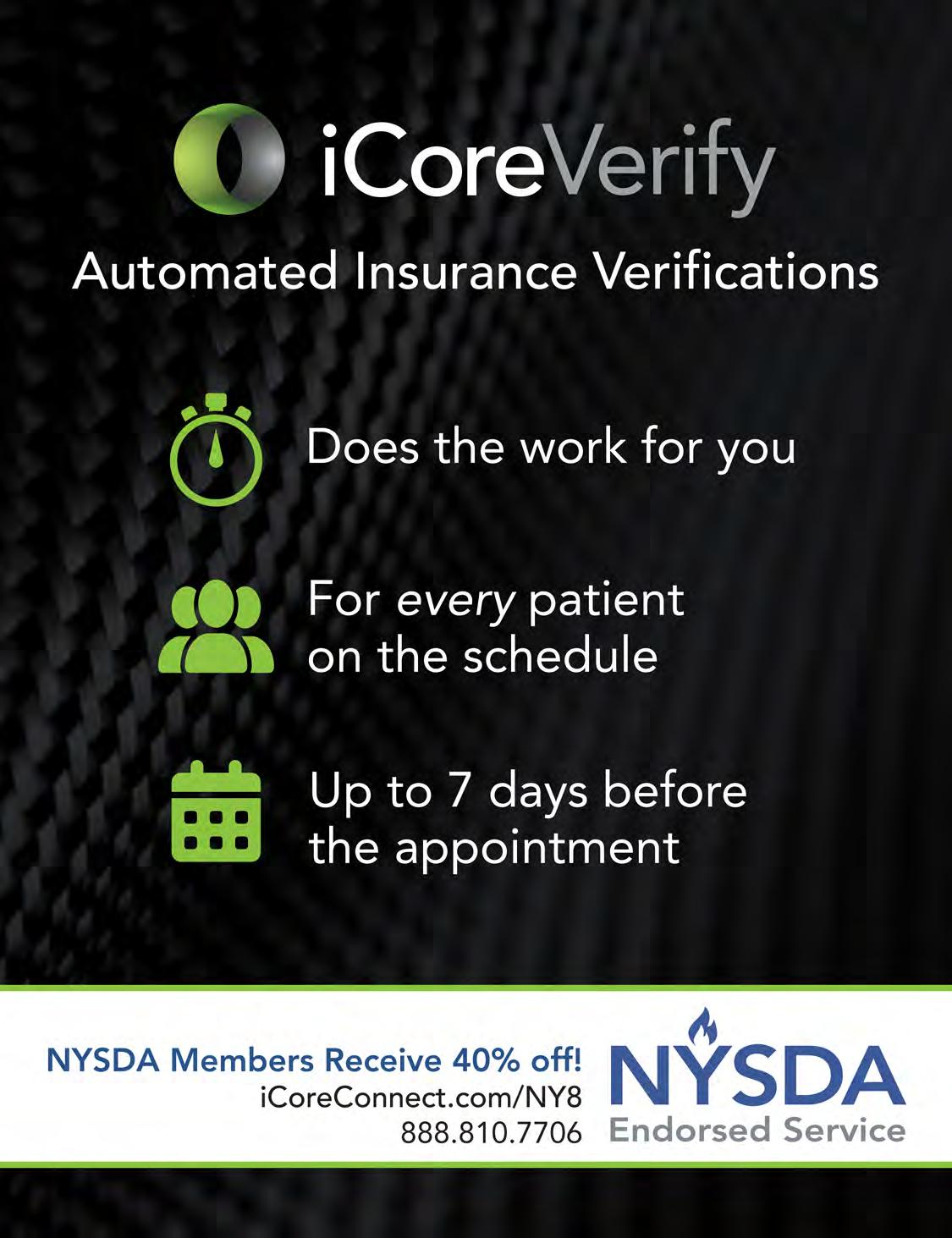
The Future of Covenants Not to Compete
Three-pronged attack may bring an end to longstanding legal tradition in New York State.
Lance Plunkett, J.D., LL.M.
Times have changed. In December 1994, I devoted my column to the value of covenants not to compete (“Value of Covenants Not to Compete”). Now, almost 30 years later, covenants not to compete (also called “noncompete agreements”) seem likely to expire as a legal tool. Why and how?
The how part is three-pronged. Prong one is New York State. While some states had already restricted or banned the use of noncompete agreements, many had not. New York was a strong supporter of noncompete agreements. Dentistry originated the first New York State Court of Appeals decision upholding noncompete agreements in Karpinski v. Ingrasci in 1971. The facts of the case are worth noting.
The plaintiff, Dr. Karpinski, an oral surgeon, opened an office in the city of Ithaca and executed a contract for three years with the defendant, Dr. Ingrasci, also an oral surgeon, which recited that the defendant would live in Ithaca and work there as an employee of the plaintiff. The defendant promised that, “while this agreement is in
effect and forever thereafter, he will never practice dentistry and/or Oral Surgery in Cayuga, Cortland, Seneca, Tompkins or Ontario counties except: (a) In association with the [plaintiff] or (b) If the [plaintiff] terminates the agreement and employs Another oral surgeon.”
In addition, the defendant agreed to execute a $40,000 promissory note to the plaintiff, to become payable if the defendant left the plaintiff and practiced “dentistry and/or Oral Surgery” in the five enumerated counties. When, after the contract expired, the defendant left the plaintiff’s employ and opened his own office for the practice of oral surgery in Ithaca, he violated the terms of the covenant.
The Court concluded that: 1) the area restriction imposed was reasonable; 2) the covenant was not invalid because it was unlimited as to time; 3) the restriction against the practice of “dentistry and/or Oral Surgery” in competition with the plaintiff was too broad where the plaintiff practiced only “oral surgery”; 4) that the plaintiff gained all the injunctive protection to which he was
ATTORNEY ON LAW
6 AUGUST/SEPTEMBER 2023 . The New York State Dental Journal
entitled if effect was given only to that part of the covenant which prohibited the defendant from practicing oral surgery; 5) the injunctive relief was not precluded by the fact that the defendant’s promissory note for $40,000 was to become payable if he breached the agreement not to compete; and 6) instead of awarding the amount of liquidated damages specified, the matter should be remitted for determination of the actual damages suffered during the period of the breach.
Undoing 50-year Tradition
This seminal, baseline case for noncompete agreements in New York has defined how New York courts have looked at noncompete agreements for 52 years. It illustrated all the factors that New York weighed when assessing the validity and enforceability of such noncompete agreements. Interestingly, the New York State Legislature never ventured into this area to change any of the analysis set forth in the Karpinski v. Ingrasci case. Until now. On June 20, the New York State Legislature passed A.1278-B (Joyner)/S.3100-A (Ryan), a bill that adds a new Section 191-d to the New York State Labor Law that would ban all noncompete agreements in New York, but would do so prospectively, not retroactively.
The bill has not yet been sent to Gov. Hochul for action, and it may be one of those bills that does not get sent to her until much later in the year because it is subject to much behind-the-scenes lobbying over vetoing it, passing it with agreed-on amendments next year, or just passing it as is. For her part, the governor is also probably waiting anxiously to see what will happen with prongs two and three, discussed below. Federal action could preempt New York law and make a mess of figuring those interactions out. The New York law would take effect on the 30th day after it becomes a law.
What does the New York law passed by the Legislature accomplish? The bill covers every type of noncompete agreement and has no exception for noncompete agreements entered into as part of business sale transactions. There is no salary cap, so the New York bill would apply equally to low-wage workers and highly compensated professionals or executives, banning noncompete agreements for all of them. The bill will only apply to agreements entered into after the effective date of the bill if it becomes law, but will also apply if a pre-existing noncompete agreement is modified after the date the law takes effect.
NYSDA Directory
OFFICERS
Anthony M. Cuomo, President 667 Stoneleigh Ave., Ste 301, Carmel, NY 10512
Prabha Krishnan, President- Elect 11045 Queens Blvd., Ste 108, Forest Hills, NY 11375
Maurice Edwards, Vice President 30 E. 60th ST, #1401, New York, NY 10022
Paul Leary, Secretary-Treasurer 80 Maple Ave., Ste 206, Smithtown, NY 11787
William Karp, Speaker of the House 4500 Pewter Ln., Bldg 6, Manlius, NY 13104
BOARD OF TRUSTEES
James E. Galati, Immediate Past President 1758 Route 9, Halfmoon, NY 12065
Brendan Dowd, ADA Trustee 3435 Main St., Squire Hall, Room 235G, Buffalo, NY 14214 NY – Lois Jackson 505 Laguardia Pl., Apt L4, New York, NY 10012
2 – John P. Demas 8814 Fort Hamilton Pkwy, Brooklyn, NY 11209
3 – Steven L. Essig Emblem Health, 1873 Western Ave., Albany, NY 12203
4 – Adrienne L. Korkosz 1309 Union St., Schenectady, NY 12308
5 – Lynn A. Stacy 7504 E State St., Lowville, NY 13367
6 – Luis T. Mauleon 501 N. Cayuga St., Ithaca, NY 14850
7 – Theresa A. Casper-Klock 33 William St., Ste 1, Auburn, NY 13021
8 – Raymond G. Miller 1965 Como Park Blvd., Lancaster, NY 14086
9 – Gary M. Scharoff 1255 North Ave., Ste A1H, New Rochelle, NY 10804
N – Donald R. Hills 136 Woodbury Rd., Ste L3, Woodbury, NY 11797
Q – Mitchell S. Greenberg 11966 80th Rd., #1A, Kew Gardens, NY 11415
S – Guenter J. Jonke 2500 Nesconset Hwy., Bldg 24A, Stony Brook, NY 11790
B – Amarilis Jacobo 824 E. 181st St., Bronx, NY 10460 New Dentist—Megan Cloidt 1400 Pelham Pkwy. S., Ste. 3NE1, Bronx, NY 10461
COUNCIL CHAIRPERSONS
Council on Awards
Dental Benefit Programs
Dental Education & Licensure
Lawrence J. Busino
2 Executive Park Dr., Albany, NY 12203-3700
Patricia M. Hanlon
4 Lyme St., Wading River, NY 11792
Joseph Gambacor ta 4911 Anfield RD., Williamsville, NY 14221
Dental Health Planning & Raquel Rozdolski
Hospital Dentistr y 52 Shingle House Rd., Millwood, NY 10546
Dental Practice
Ethics
Governmental Affairs
Membership & Communications
Nominations
Peer Review & Quality Assurance
Professional Liability Insurance
OFFICE
Mario Silverstri 501 Plaza Dr., Vestal, NY 13850
Paul W. Teplitsky
1 Hanson Pl., # 705, Brooklyn, NY 11243
Rober t F. Schaefer
110A W. Utica St., Oswego, NY 13126
Kendra J. Zappia
1 Pine West Plaza, #106, Albany, NY 12205
James E. Galati
1758 Route 9, Halfmoon, NY 12065
Barr y Sporer 80 Park Ave., Ste 1C, New York, NY 10016
Roland Emmanuele
4 Hinchcliffe Dr., Newburgh, NY 12550
Suite 602, 20 Corporate Woods Blvd., Albany, NY 12211
(518) 465-0044 | (800) 255-2100
Gregory D. Hill
Lance R. Plunkett
Michael J. Herrmann
Grazia A. Yaeger
Mar y Grates Stoll
Jenna Bell
Betsy Bray
Briana McNamee
Stacy McIlduff
Executive Director
General Counsel
Assistant Executive Director Finance and Administration
Assistant Executive Director Marketing and Communications
Managing Editor
Director of Meeting Planning
Director of Health Affairs
Director of Governmental Affairs
Executive Director NYS Dental Foundation
The New York State Dental Journal AUGUST/SEPTEMBER 2023 7
If you are in the midst of negotiating any such agreement now, it is a good idea to use a knowledgeable attorney because you will end up stuck with that version if this legislation is signed by the governor into law. The legislation gives workers a private right of action to sue an employer who seeks, requires, demands or accepts a noncompete agreement from any worker. The civil lawsuit must be brought within two years of the later of the date that: 1) the prohibited noncompete agreement was signed; 2) the worker learned of the prohibited noncompete agreement; 3)the employment or the contractual relationship with the worker is terminated; or 4) the employer takes any step to enforce the noncompete agreement. When all is taken into account, the New York legislation converts New York from a state that was highly supportive of noncompete agreements to a distinctly unfriendly state towards such agreements.
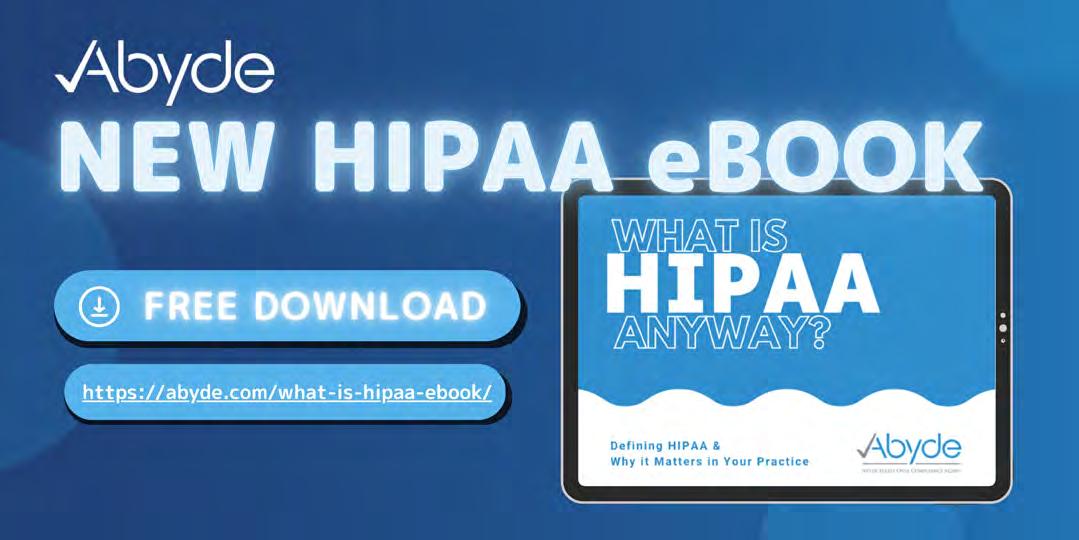
Prongs Two and Three
Prong two we covered in the March Journal (“Caring for Your Employees: The End of Non-Compete Agreements?”).
In that column, I reported on Federal Trade Commission (FTC) proposed regulations which would impose sweeping changes that would ban all noncompete agreements, including rescinding agreements already in existence. The theory was that noncompete agreements were always antitrust law violations and that they should never be tolerated except in the limited context of sales of business transactions.
After inviting public comment on the proposed regulations, the FTC has extended its deadlines for making a final decision and still has not done so. The comments have been extensive and varied, and it is not clear what the FTC will do. If the FTC went ahead with its originally proposed regulations, it would moot New York efforts to be any less restrictive. However, the FTC has not taken final action yet.
Prong three we covered in the June/July Journal (“Three New Actions Enter Legal Landscape: NLRB Not Waiting Around”) It derives from the sudden action of the Office of Counsel of the National Labor Relations Board (NLRB) to issue an opinion holding that noncompete agreements violated the National Labor Relations Act. The NLRB has not yet taken any enforcement action based on that Office of Counsel opinion.
8 AUGUST/SEPTEMBER 2023 . The New York State Dental Journal

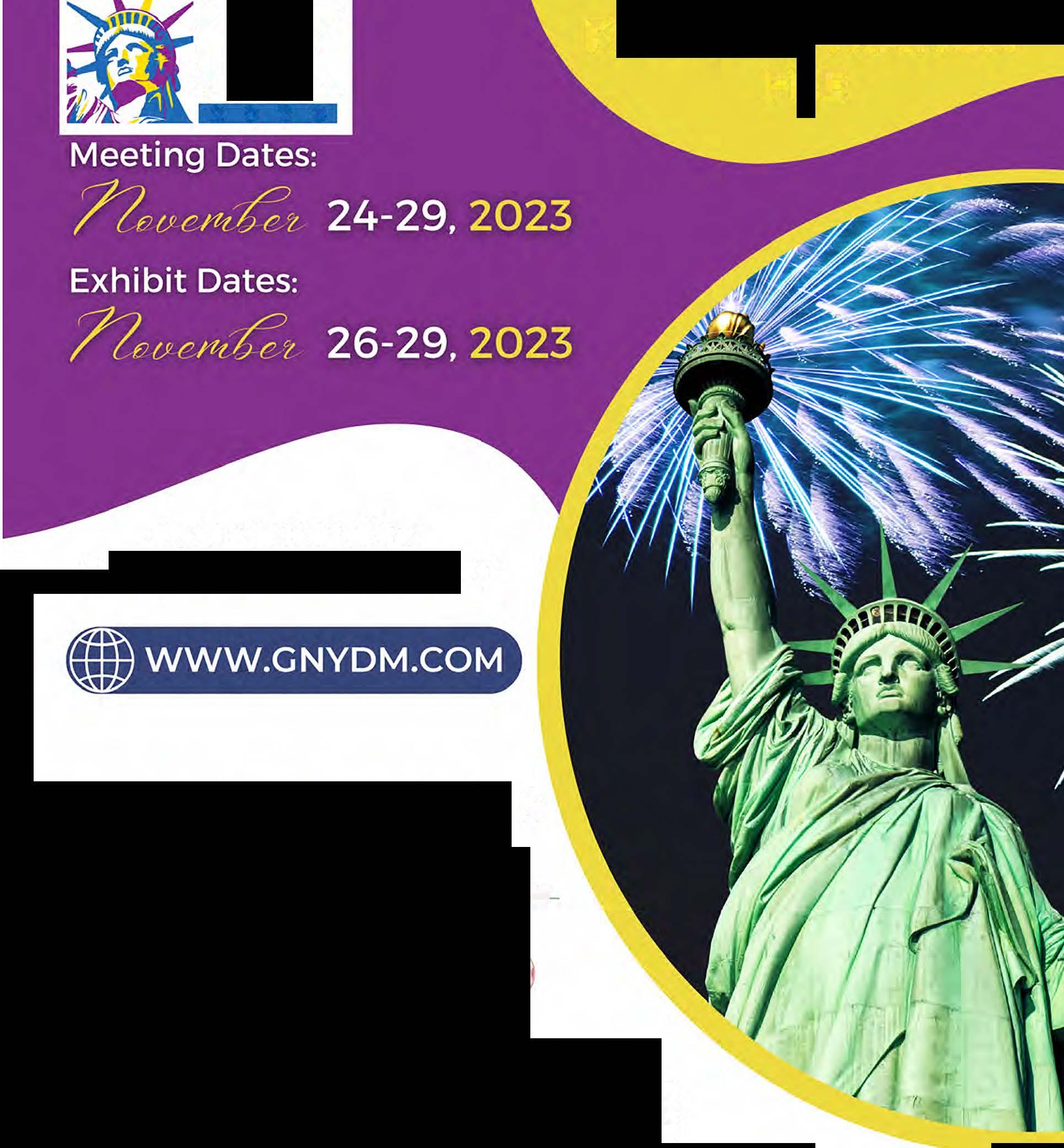
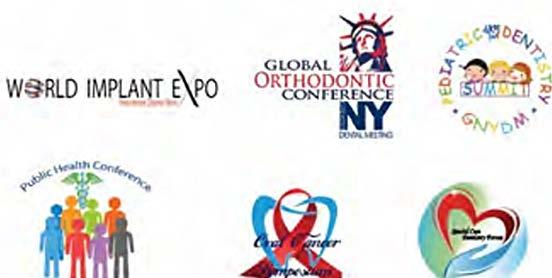
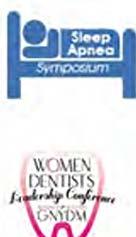
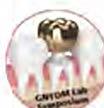




NY DENTAL MEETING. 2 0 2 3
TEN SPECIALTY PROGRAMS 30 Pl\nNng& Dloltol be.-ishuConlefence NO PRE-REGISTRATION FEE Follow Us 11fffl C+J a El The Largest Dental Meeting inthe United States
Meeting is Held at the Jacob K. Javits Convention Center
Why Now?
Why all this sudden hatred towards noncompete agreements? That “why” is an even more difficult question than the three-pronged “how” of the methodologies for undoing them. The why for the FTC is a long-abiding suspicion that noncompete agreements are antithetical to the antitrust laws and nowadays, the business reasons for allowing them are receding into insignificance in comparison to the negative effects for employees. The FTC has mainly looked at low-wage earners and it has to be acknowledged that the abuses of employers trying to trap low-wage earners into sticking with low-wage jobs through noncompete agreements has poisoned the atmosphere for even formerly legitimate uses of noncompete agreements.
The why for the NLRB we explored in depth in my June/July column, but it goes beyond even the FTC’s antitrust concerns. The NLRB finds that noncompete agreements impair the right of workers in the labor market. The board’s concern is broader and more generic than that of the FTC. The NLRB believes that noncompete agreements inhibit the rights of employees to act on their own behalf vis-à-vis employers, implicating basic fairness on the job.
This is not the province of antitrust laws, but of basic employment and labor laws. In some ways, this is even harder to deflect than the more scientific economic arguments that underlie the antitrust laws. The NLRB was also definitely focusing on low-wage earners, but its rationale has no true relationship to salary level; it is a broader concern with the ability of anyone to earn any wage. The NLRB is a latecomer to this entire issue and may be an illustration of everyone hopping onto a bandwagon while the hopping on is attractive.
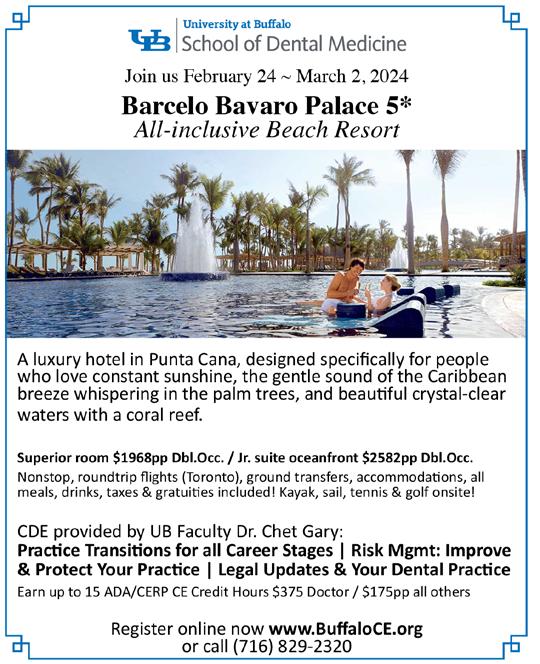
The why for New York is less clear. It certainly is a major departure from previous New York law on the topic. It was also certainly prompted by the FTC’s proposed action. The Legislature noted that noncompete agreements have a negative effect on the labor market and economy of New York State because they prevent workers from seeking employment at entities that may be a better fit, and they disincentivize employers from providing more competitive benefits and wages because their workforce cannot seek employment elsewhere.
The Legislature also noted that, in certain industries, noncompete agreements can have a detrimental impact on consumers. In particular, the Legislature cited the prevalence of noncompete agreements in the medical field as disrupting continuity of care. We will not know until later this year where New York will come down on this, and it may well be moot if the FTC comes down with its regulations sooner and if the NLRB acts quickly on its own enforcement actions.
The points made way back in 1971 in Karpinski v. Ingrasci and in my 1994 Journal article are still valid, but times have changed. The allure and utility of noncompete agreements is now under fire as serving more nefarious goals. To quote the old Cole Porter song: “Times have changed, And we’ve often rewound the clock, Since the Puritans got a shock, When they landed on Plymouth Rock. If today, Any shock they should try to stem, ‘Stead of landing on Plymouth Rock, Plymouth Rock would land on them.” p
10 AUGUST/SEPTEMBER 2023 . The New York State Dental Journal
The material contained in this column is informational only and does not constitute legal advice. For specific questions, dentists should contact their own attorney.
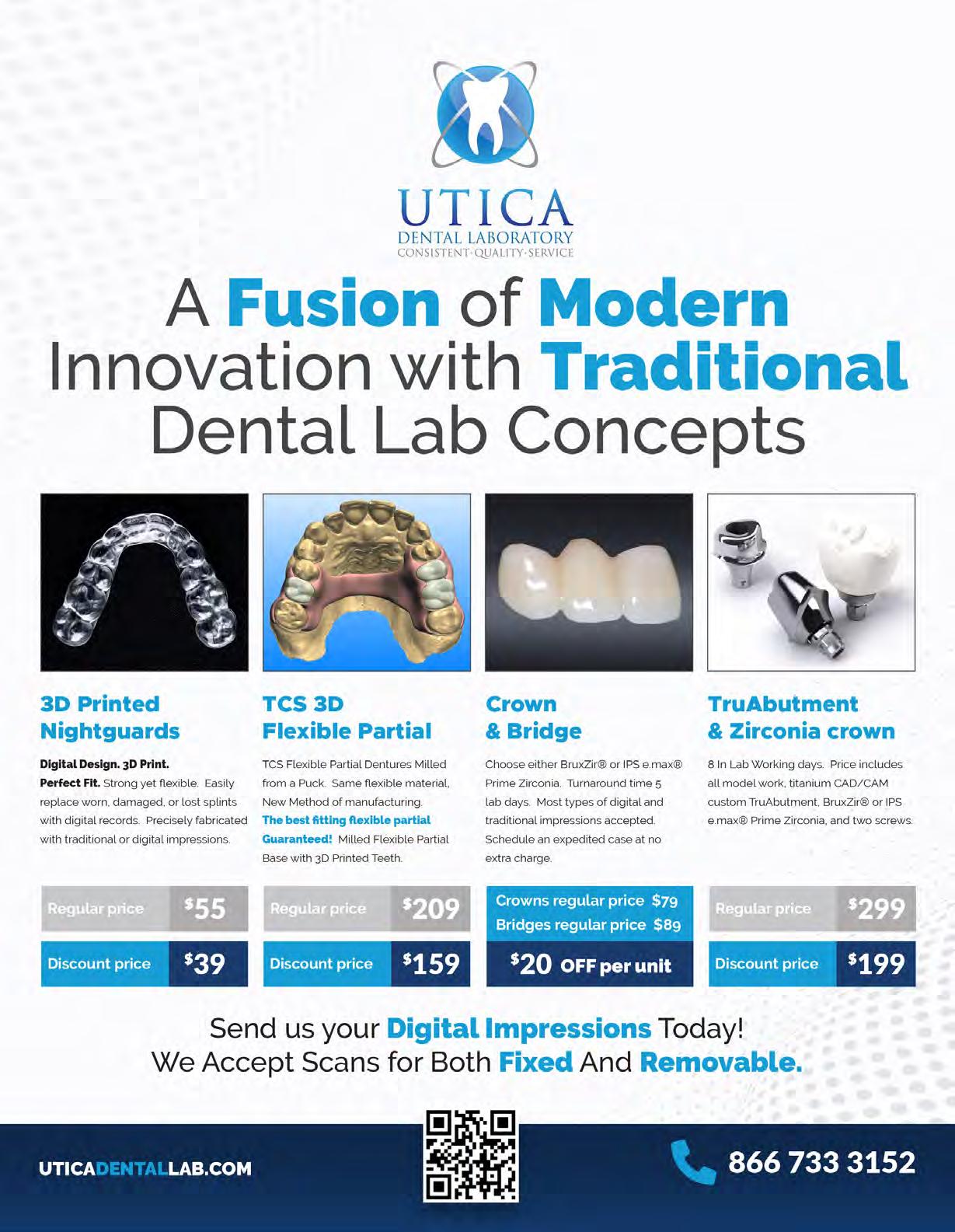
Association Activities
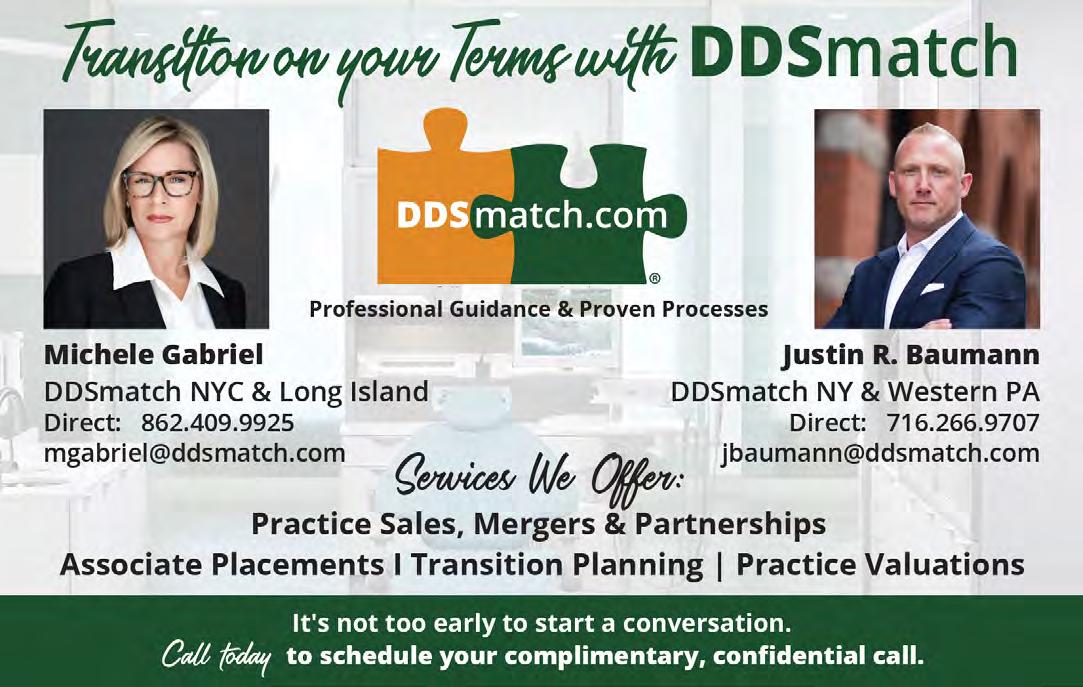
OFFICERS INSTALLED
The 2023-2024 officers of the New York State Dental Association were formally sworn into office on June 3 at the conclusion of NYSDA’s annual House of Delegates meeting in Saratoga Springs. They are:
President Anthony Cuomo, D.D.S., oral and maxillofacial surgeon, Carmel; President-Elect Prabha Krishnan, D.D.S., periodontist, Queens; Vice President Maurice Edwards, D.M.D., oral and maxillofacial surgeon, New York, NY; Secretary-Treasurer Paul Leary, D.M.D., general dentist, Smithtown; and Speaker of the House William Karp, D.D.S., Manlius.
They are pictured here, from left, Dr. Leary, Dr. Edwards, Dr. Cuomo, Dr. Krishnan, Immediate Past President Dr. James Galati, Dr. Karp.
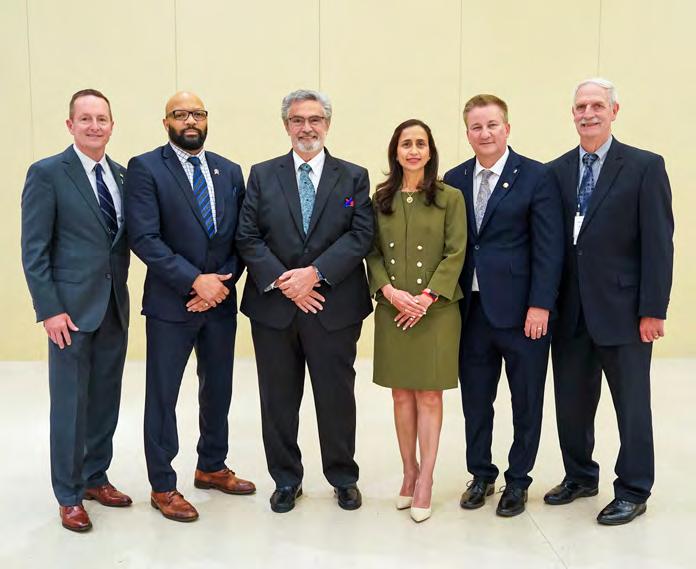
12 AUGUST/SEPTEMBER 2023 The New York State Dental Journal
Annual Meeting photos by Cindy Schultz Photography.
Association Activities
MEMBERS HONORED
James Orcutt, left, and William Calnon with Distinguished Service awards presented to them at annual meeting of NYSDA House. The duo was recognized for their individual service and commitment to NYSDA. Both men are past presidents of the Association. Dr. Calnon also served as president of the American Dental Association.
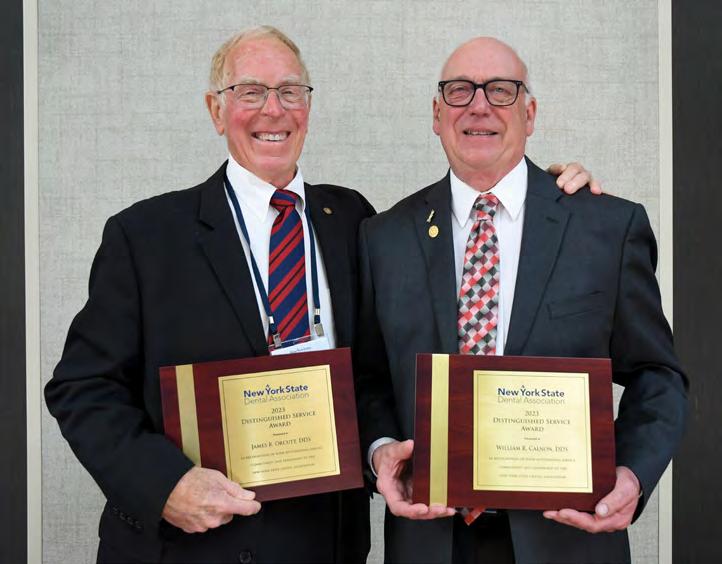
Above and Beyond
The Council on Membership and Communications chose two winners for its 2023 Hallmarks of Excellence Award. Dr. Steven Feigelson, Suffolk County, was cited for Enhancing the Membership Experience for his role in developing a mentorship program involving SCDS and Stony Brook Dental students. Dr. Keri Logan, also from SCDS, was honored for her Education/ Community Service in organizing Give Veterans a Smile Day to provide free treatment to former members of the military. Dr. Logan, center, and Dr. Feigelson are seen with their awards. They are joined by Dr. Claudia Mahon-Vazquez, SCDS Membership Chair.
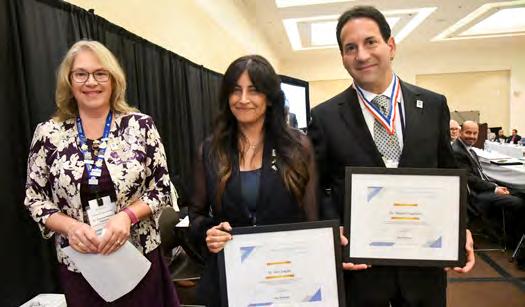
A Fond Farewell
NYSDA staff gathered at the end of July to bid farewell to colleague Sherri Lenz, who was calling it quits after nearly 30 years with the Association. Sherri, administrative assistant in Finance and Administration Department, was the go-to person for NYSDA members seeking reimbursement for expenses incurred.
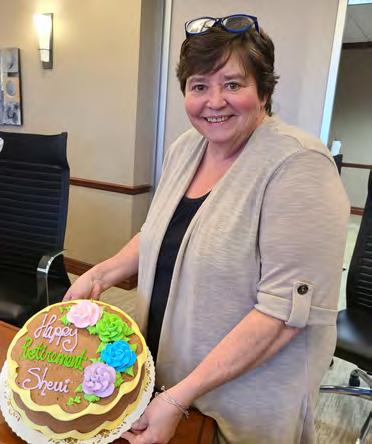
The New York State Dental Journal AUGUST/SEPTEMBER 2023 13
Association Activities
Foundation Luncheon Builds Awareness
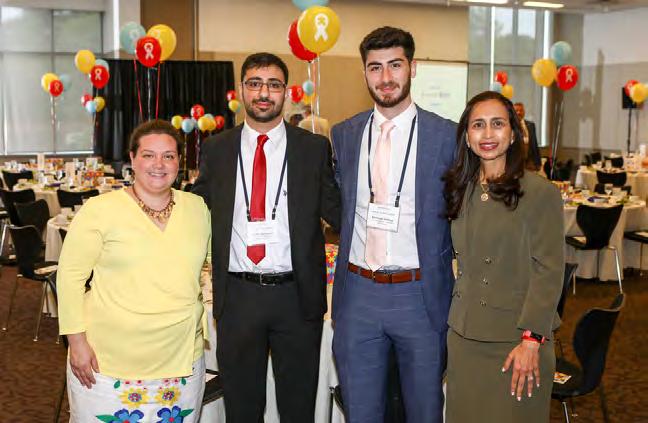

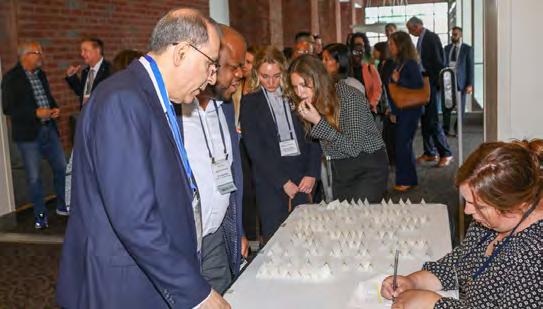
THE NEW YORK STATE DENTAL FOUNDATION
Annual Luncheon, held alongside the Annual Meeting of the NYSDA House in June, was dedicated to raising “Autism Awareness in Dentistry.” Dr. Tana Fagan, Albany dentist, who treats patients at Center for Disability Services, described protocol for treating autistic patients. Photos from the luncheon are presented here.
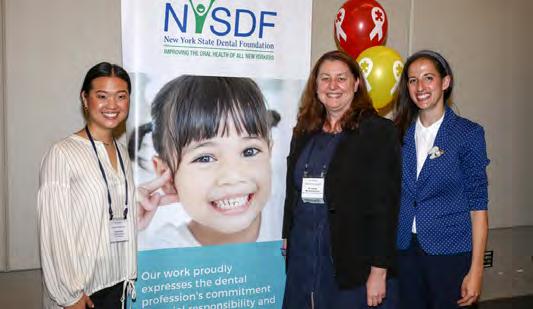 Brenda Turner, manager continuing education, checks guests in at registration table.
NYSDF Executive Director Stacy Mcllduff, left, and NYSDA President-Elect Prabha Krishnan welcome Tuoro Dental students and ASDA members Jordan Sahawneh and Vartkes Arakelian to June luncheon.
ASDA student Kristin Woo with her mentor sponsor, Ioanna Mentzelopoulou, New York County, and Kathryn Rothas, Third District.
Shailee Gupta, third from right, Texas Dental Association, and Duc Ho, at end, Greater Houston Dental Society, with Suffolk County members, from left, Guenter Jonke, Craig Smith, John Lagner, Martin Dominger, Paul Leary, Paul Markowitz.
Brenda Turner, manager continuing education, checks guests in at registration table.
NYSDF Executive Director Stacy Mcllduff, left, and NYSDA President-Elect Prabha Krishnan welcome Tuoro Dental students and ASDA members Jordan Sahawneh and Vartkes Arakelian to June luncheon.
ASDA student Kristin Woo with her mentor sponsor, Ioanna Mentzelopoulou, New York County, and Kathryn Rothas, Third District.
Shailee Gupta, third from right, Texas Dental Association, and Duc Ho, at end, Greater Houston Dental Society, with Suffolk County members, from left, Guenter Jonke, Craig Smith, John Lagner, Martin Dominger, Paul Leary, Paul Markowitz.
14 AUGUST/SEPTEMBER 2023 The New York State Dental Journal
Photos by Denis Nally
Association Activities
New York Dentist Elected AIP President
ROBERT M. PESKIN, D.D.S., who served as the first speaker of the NYSDA House of Delegates, was elected president of the American Institute of Parliamentarians (AIP) in August and installed during the closing ceremonies of AIP’s 64th Annual Session.
Dr. Peskin is currently speaker of the Academy of General Dentistry’s (AGD) House of Delegates and serves as parliamentarian to the AGD Board. He previously served as speaker of the American Dental Society of Anesthesiology.
In 2021, Dr. Peskin was credentialed as a certified parliamentarian by AIP. He has also received fellowships from the AGD, the American College of Dentists, the International College of Dentists and the Pierre Fauchard Academy, and has been recognized by many organizations for his distinguished service. He has been a member of the ADA House of Delegates every year since 1992.
Dr. Peskin earned his dental degree from Stony Brook University School of Dental Medicine, where he is now a clinical associate professor. He subsequently completed general practice and dental anesthesiology residencies at Long Island Jewish Medical Center and practices dentistry in Garden City, Nassau County.
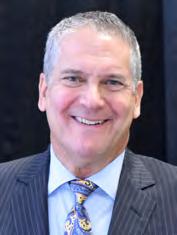
AIP is a not-for-profit educational organization founded in 1958 for the advancement of parliamentary procedure. Its mission is to develop skillful, highly trained parliamentarians and to improve parliamentary procedure in organizations that want a fair, democratic, and effective decision-making process. The current edition of “American Institute of Parliamentarians Standard Code of Parliamentary Procedure” is the most commonly used set of rules for many major health-related professional associations.
In Memoriam
SECOND DISTRICT
Alan Sosnay
New York University ‘60
16 Wheelock Road
Scarsdale, NY 10583
July 1, 2023
EIGHTH DISTRICT
William Bauer
University at Buffalo ‘90
84 Timberlane Drive Buffalo, NY 14221
June 17, 2023
NINTH DISTRICT
John Mc Intyre
Fairleigh Dickinson University ‘63
294 Bedford Banksville Road
Bedford, NY 10506
July 11, 2023
Robert Peskin
The New York State Dental Journal AUGUST/SEPTEMBER 2023 15
And then, They Partied
AS SOON AS THE GAVEL CAME DOWN, signaling the end of the business portion of the 2023 meeting of the NYSDA House of Delegates, attendees turned their attention to the celebration to follow. The Presidents’ Dinner Gala is the much-anticipated finale to the annual House meeting, a lavish party to honor NYSDA’s currently serving president, James E. Galati, and the officers who served alongside him.
This year’s party on June 3 in the beautiful and historic Hall of Springs didn’t disappoint. It was a perfect summer

evening, replete with good food, music, dancing and a spectacular fireworks display that lit up the sky over Saratoga Spa State Park. On the receiving end of tributes, along with Dr. Galati, were the other 2022-2023 officers: Anthony M. Cuomo, president-elect; Prabha Krishnan, vice president; Frank C. Barnashuk, secretary-treasurer; Steven Gounardes, speaker; and Kevin A. Henner, immediate past president.
A gallery of photos of celebrants is presented here.
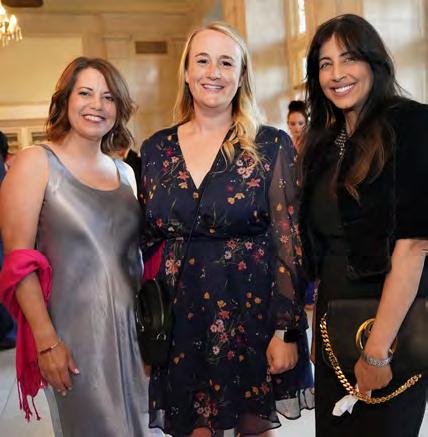
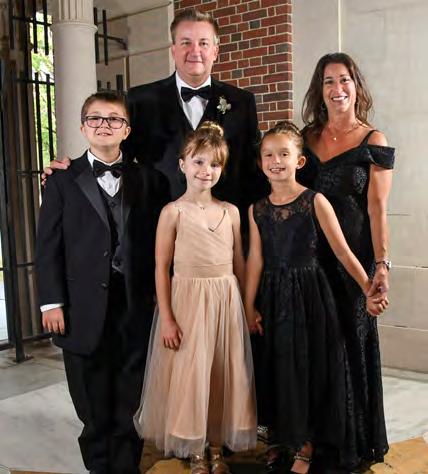
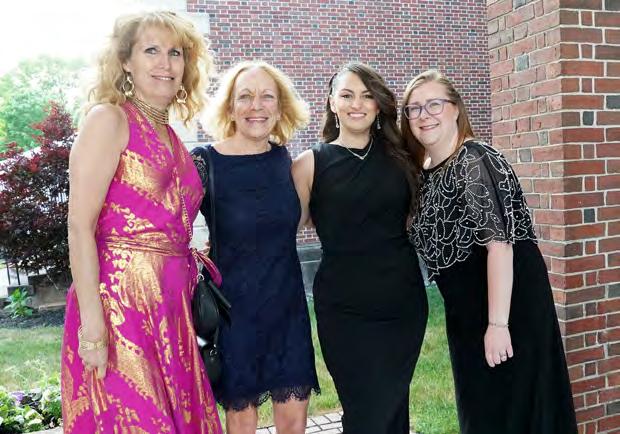
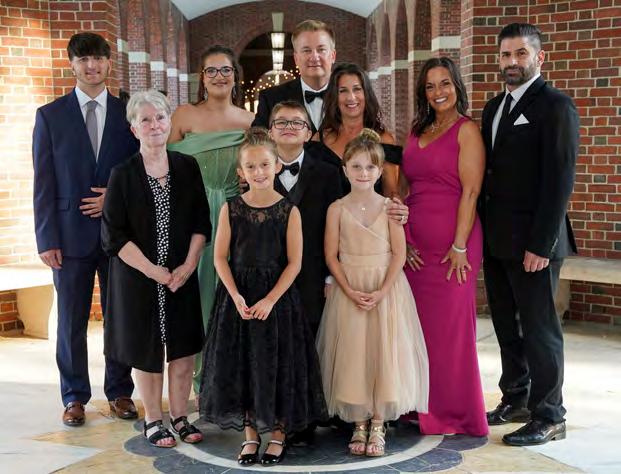 Photos by Cindy Schultz
Photos by Cindy Schultz
16 AUGUST/SEPTEMBER 2023 . The New York State Dental Journal
Photography

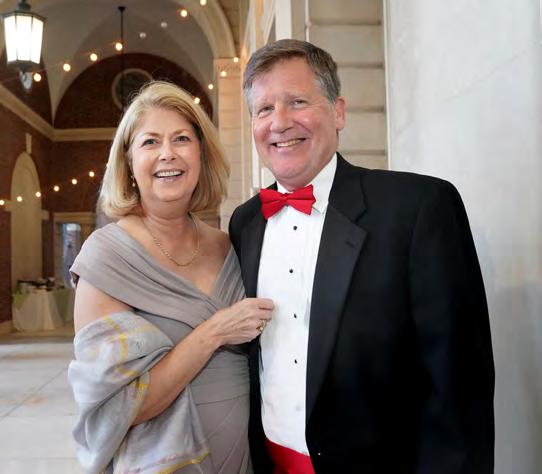
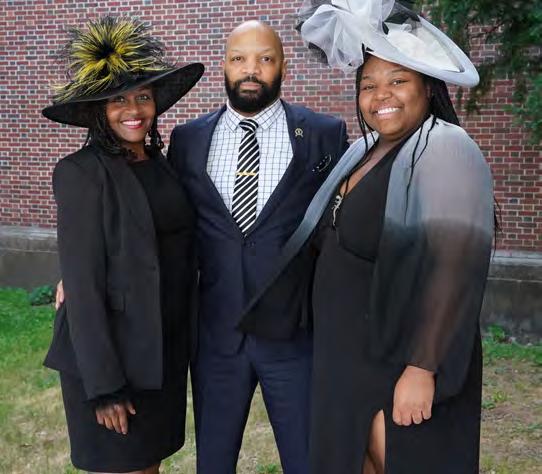
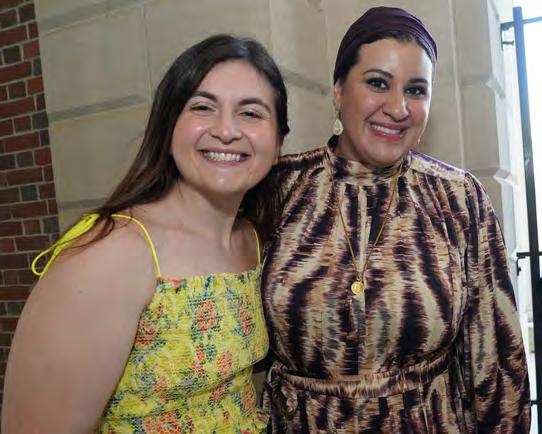
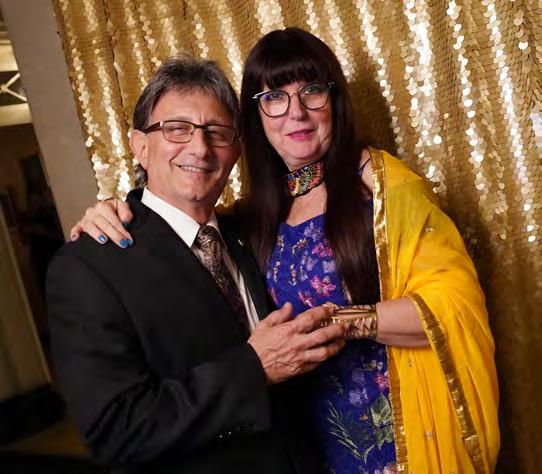
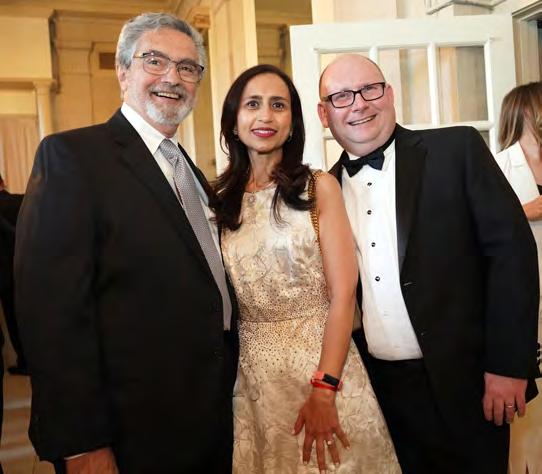
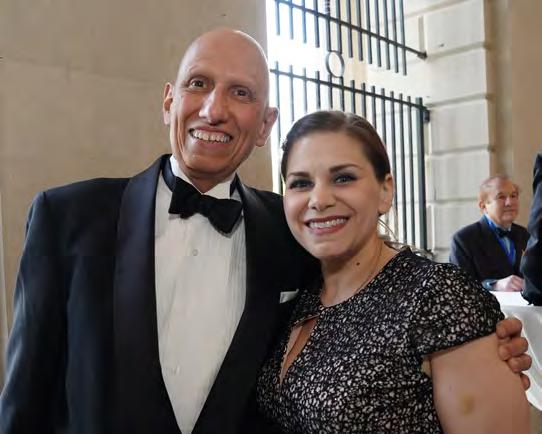
The New York State Dental Journal AUGUST/SEPTEMBER 2023 17

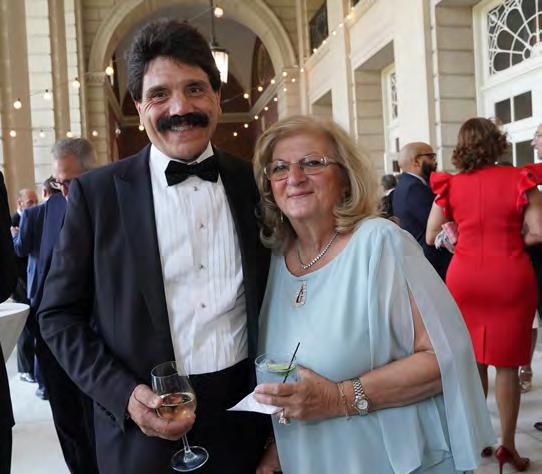
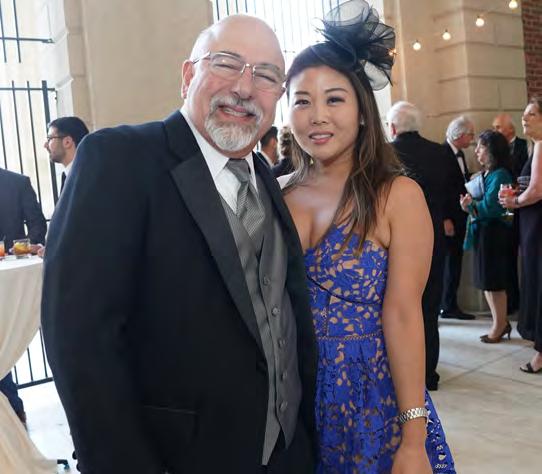
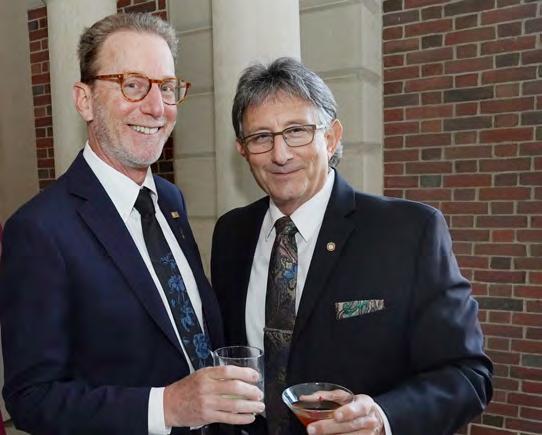
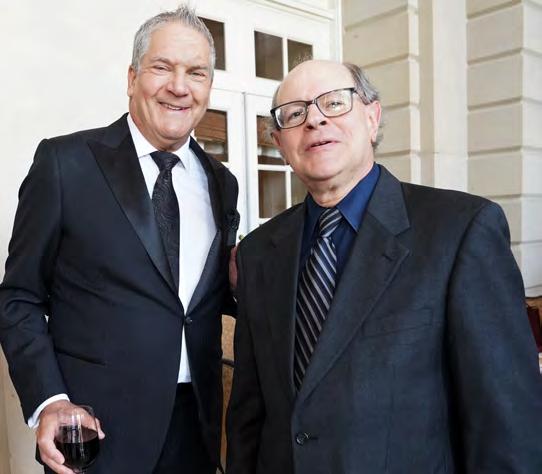
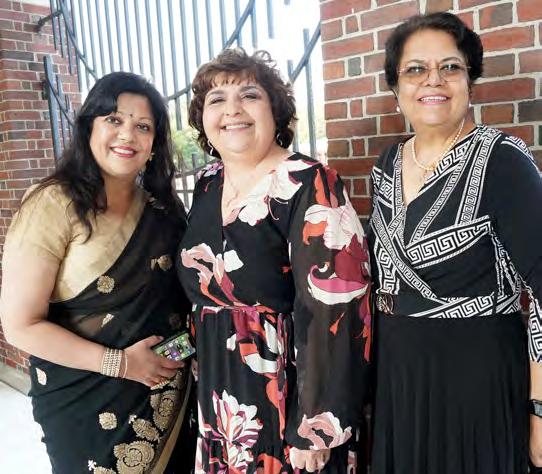
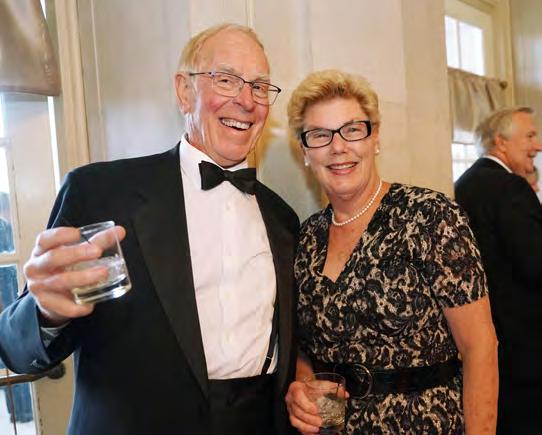
18 AUGUST/SEPTEMBER 2023 . The New York State Dental Journal

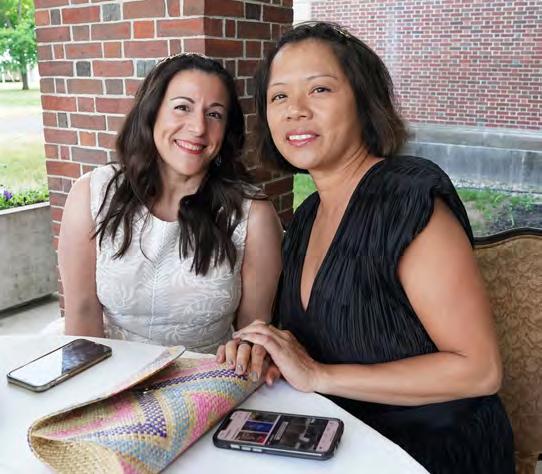
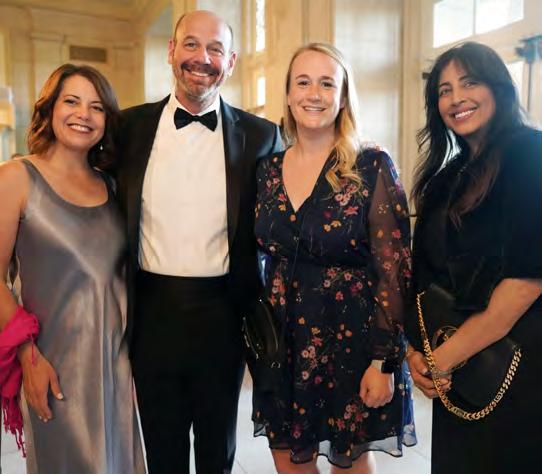
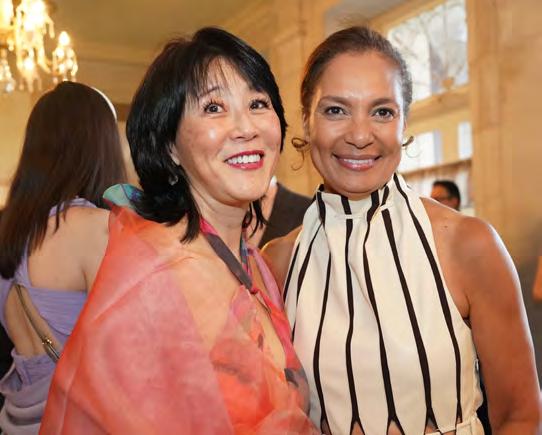
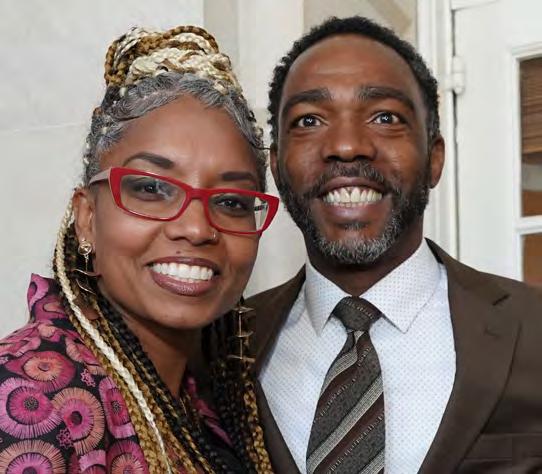

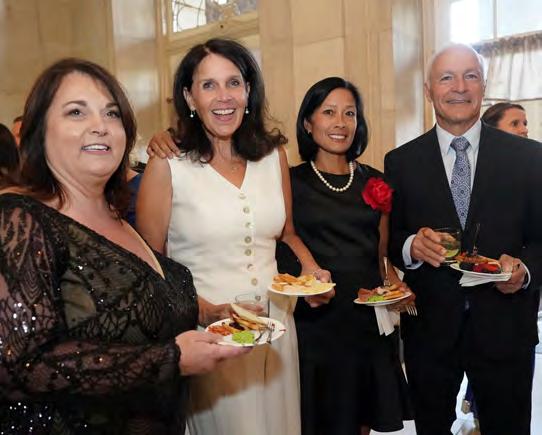
The New York State Dental Journal AUGUST/SEPTEMBER 2023 19

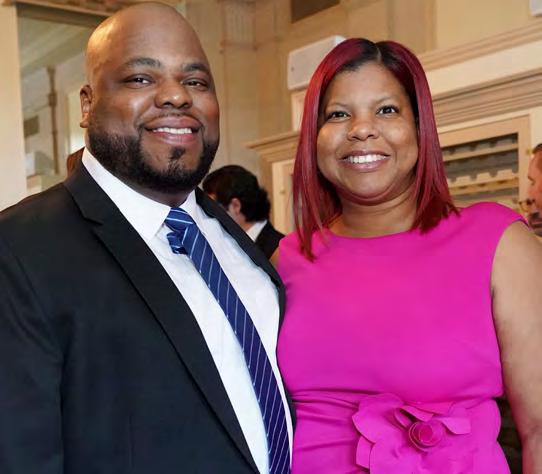
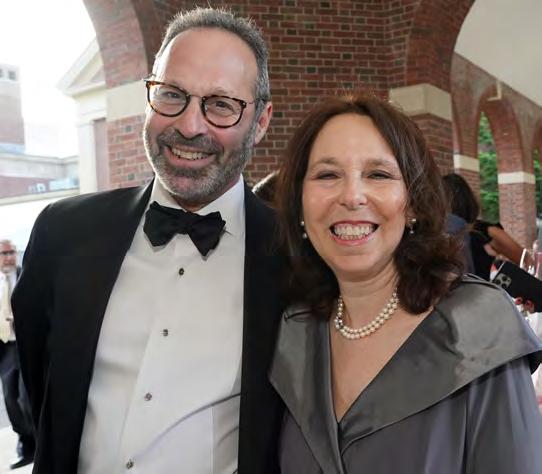
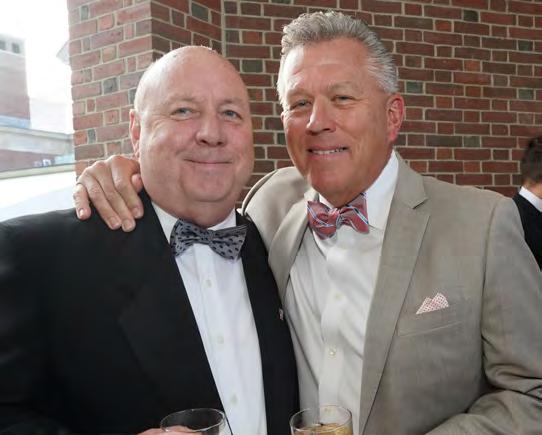
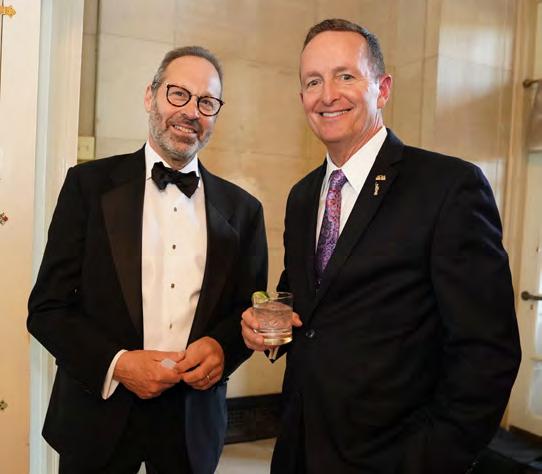
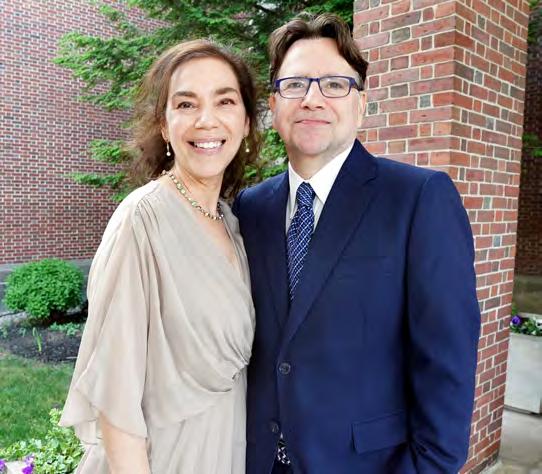
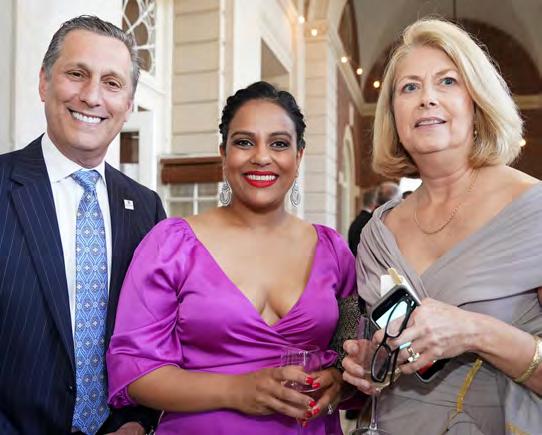
20 AUGUST/SEPTEMBER 2023 . The New York State Dental Journal

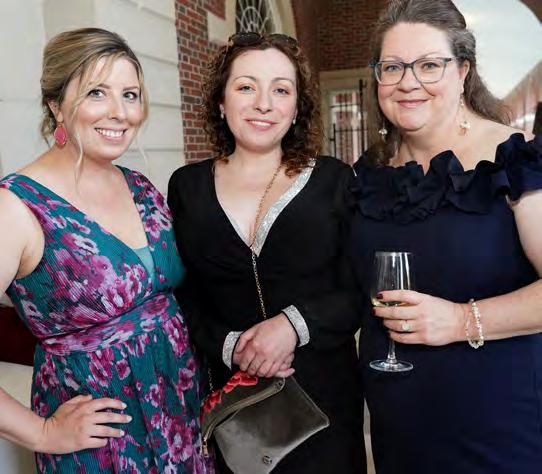
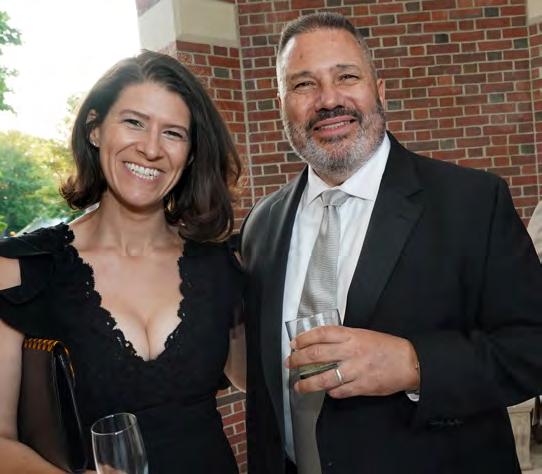
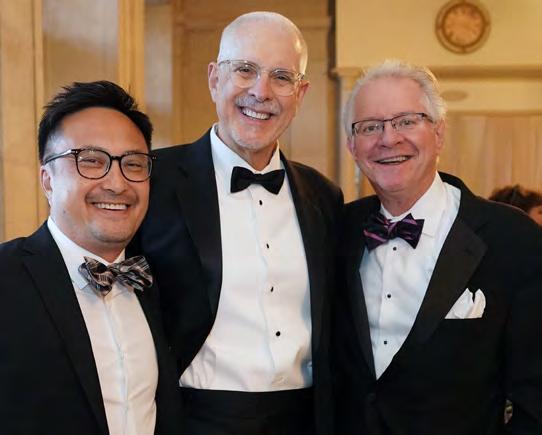
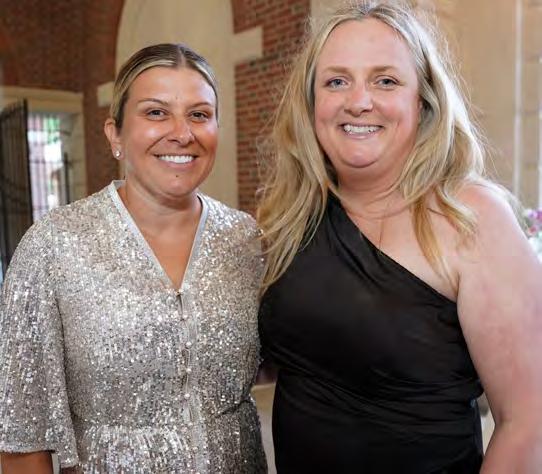
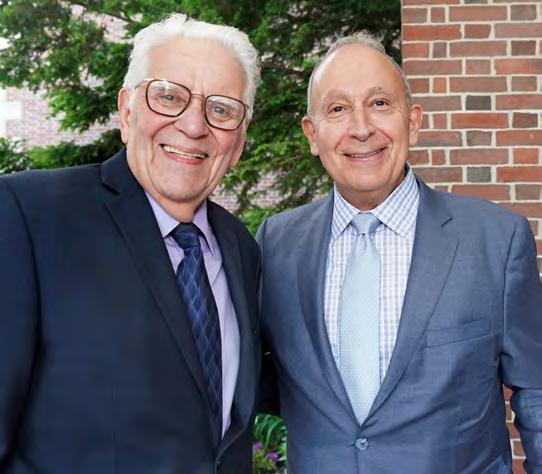
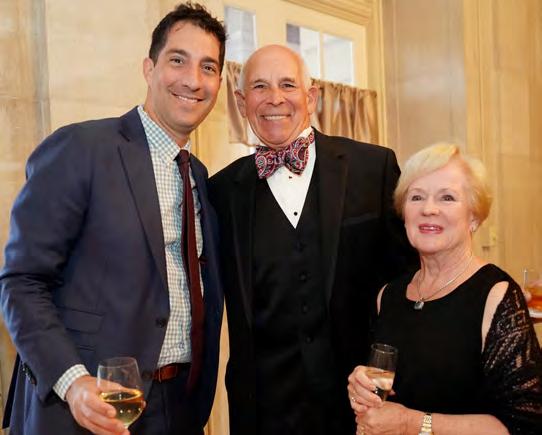
The New York State Dental Journal AUGUST/SEPTEMBER 2023 21
Fauchard Academy Honors Two for Service
Inducts Nine New Members
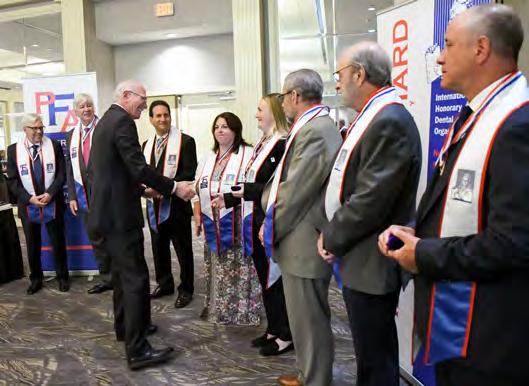
Maria C. Maranga, D.D.S., a prominent figure in organized dentistry, noted for her advocacy of women dentists and as an active participant in dental education, is the 2023 recipient of the Pierre Fauchard Distinguished Service Award, presented by the New York Section of the academy.
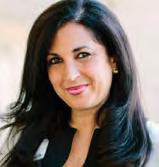
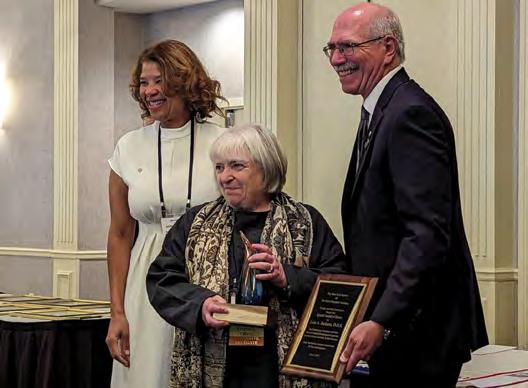
The presentation to Dr. Maranga was made June 2 at a meeting of the New York Section, which took place during the annual session of the NYSDA House of Delegates in Saratoga Springs. At its June gathering, the academy also honored Dr. Lois Jackson. Dr. Jackson received the PFA Honor Award. And it inducted nine new fellows into the academy.
Legacy of Caring
Dr. Maranga was cited for her “sustained, high-level caring service to both the dental and academic communities.” An endodontist from Northport, Suffolk County, Dr. Maranga is an attending to four GPR residency programs, a postgraduate endodontic program, and is on the dental faculty of NYU, Stony Brook and the medical staff of NYU Langone Health. She is a past president of the Suffolk County Dental Society, the New York State Endodontic Association, and immediate past ADA First Vice President. She has served on the Board of the American Association of Endodontists and
as chair of the ADA Council on Membership. She currently chairs the New York State Dental Foundation, is a member of the Board of the Empire Dental Political Action Committee and of the NYSDA Council on Dental Health Planning and Hospital Dentistry.
A graduate of the ADA Diversity Institute and former consultant to the institute, Dr. Maranga has been previously recognized as a top businesswoman and dentist. She was academic affairs director/membership director of the American Association of Women Dentists and cofounder of SCDS’s annual women’s conference, “Scrubs and Stilettos.”
It’s an Honor
The PFA New York Section selected Lois A. Jackson, D.D.S., to receive its Honor Award, in recognition of her contributions to the dental profession and community. A pediatric dentist, with offices in Soho and Brooklyn, Dr. Jackson is also an assistant clinical professor of pediatric dentistry at Columbia University College of Dental Medicine (CDM). She was previously honored by CDM, which named her an Alumni Medalist for her volunteerism and a Distinguished Alumni.
A past president of the New York County Dental Society, Dr. Jackson was installed this year as a NYSDA Trustee. She previously served on the Board of the American Academy of Pediatric Dentistry and chaired the New York State Board for Dentistry from 2014-2015. She is very in-
Maria Maranga
Lois Jackson, center, receives Pierre Fauchard Academy Honor Award from Cosection chairs Amarilis Jacobo and Jay Skolnick.
22 AUGUST/SEPTEMBER 2023 . The New York State Dental Journal
Dr. Skolnick congratulates PFA inductees.
volved with the Greater New York Dental Meeting, serving as chair of the Pediatric Dental Summit, cochair of the Outreach Committee and as a member of the Organization Committee. In 2019, she cochaired the first Women Dentist Leadership Conference. She is cofounder of the Woman-to-Woman Network.
Outside of dentistry, Dr. Jackson serves on the Board of the Flatbush Development Corp, as well as the boards of Camp Bronx and Camp Brooklyn, raising funds for children to attend sleepaway camp each year.
New Members Inducted
The Pierre Fauchard Academy seeks to educate dental professionals about the latest techniques in dentistry and to foster a sharing of ideas to improve the profession. Amarilis Jacobo of Bronx County and Jay Skolnick of Seventh District are co-section chairs. This year’s inductees include the following:
Christina Cocozzo, Fourth District; Steven R. Feigelson, Suffolk County; Joseph P. Graskemper, Suffolk County; Lauren Heisinger, Third District; William L. Hurtt, Seventh
• Refinance your student loans and save thousands


District; Marcus Johnson, New York County; Lawrence Kotlow, Third District; Douglas Schildhaus, Nassau County; and Donald A. Tucker, Eighth District.
Join thousands of dentists that have taken control of their student loan debt by refinancing through Laurel Road. Highlights of the Laurel Road Student Loan Refinance program include:
• An exclusive 0.25% rate reduction on loans for NYSDA Members in good standing



• No application or origination fees, and no payment penalties
• Flexible repayment options for residents during training



• Concierge-level customer service from dedicated representatives










• Check rates in 5 minutes, which does not require a hard credit pull.
855.277.6771
See website for all details and disclosures: Laurelroad.com/ada
For more information about this and other Endorsed Programs call: 800-255-2100
The New York State Dental Journal AUGUST/SEPTEMBER 2023 23
A big thank you for the generous support of our sponsors who helped make our 2023 Annual Meeting a success.
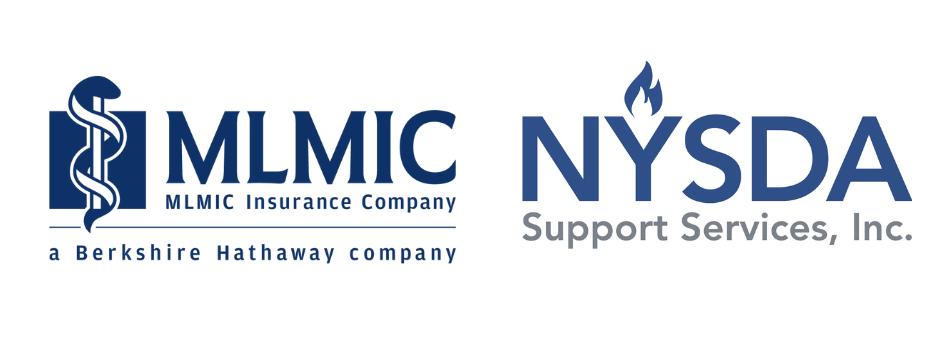
Platinum Sponsors

24 AUGUST/SEPTEMBER 2023 . The New York State Dental Journal
Pentafecta Sponsors Superfecta Sponsors
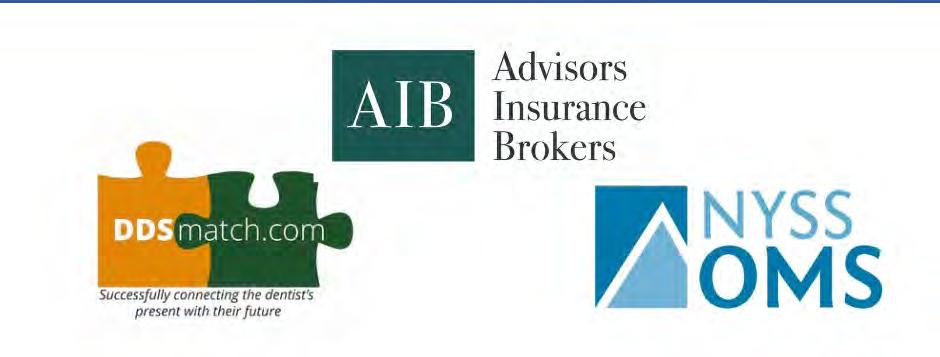
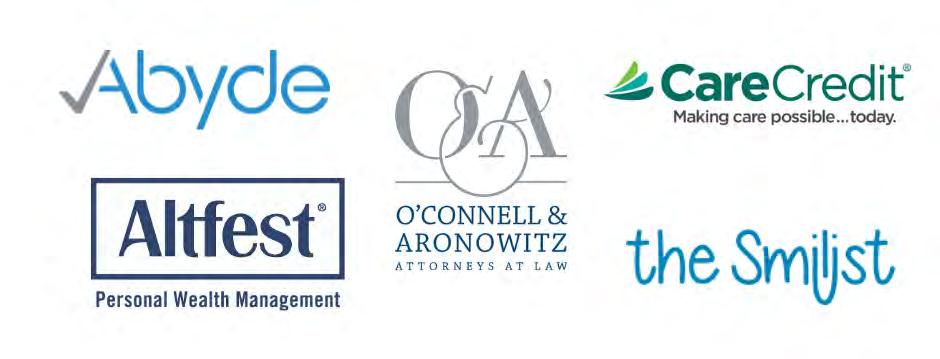

The New York State Dental Journal AUGUST/SEPTEMBER 2023 25
Iatrogenic Indirect Compression of the Inferior Alveolar Nerve by a Dental Implant
A Case Report and Review
ABSTRACT
Introduction: Although there are multiple studies regarding direct injury of the inferior alveolar nerve (IAN) during dental procedures, data related to an indirect compression phenomenon of the nerve is limited. This case report aims to review the topic of an iatrogenic indirect compression phenomenon following surgical placement of a dental implant and to report a clinical case of an indirectly compressed IAN with temporary loss of sensation following placement of a dental implant in the posterior mandible.
Case Presentation: Implant placement was used to replace tooth #31 (lower right second molar) in a healthy female patient. Prediagnostic cone beam computed tomography (CBCT) revealed sufficient bone volume, with an average of 15 mm height superior to the inferior alveolar canal and an average of 10 mm width of the alveolar ridge. Aided by an acrylic surgical stent, a bone-level implant size of 4 mm x 10 mm, with an average distance of 5 mm superior to inferior alveolar canal was inserted.
In the second day following surgery, and because of indirect compression by the implant on the IAN, the patient reported numbness and a burning sensation in her ipsilateral lower lip, part of her chin and buccal mucosa. The numbness and burning continued until it disappeared completely by day 10 postoperatively. Intervention was restricted to follow-up and careful communication with the patient with reporting of signs and symptoms. The implant was loaded successfully and followed up for nine months after surgery with no abnormality in sensation reported.
Conclusion: In such a clinical scenario, delaying a surgical approach, monitoring radiographs, clearly communicating with the patient, and evaluating the need of referral are recommended.
Dental implants are an integral part of current dental practice and widely accepted. Any dental intervention may lead to undesired effects or an iatrogenic outcome, which may or may not be avoided. A good practitioner always aims to “do no harm to the patient.” Some surgical procedures, including implant dentistry, are highly predictable but, at the
dental implants
26 AUGUST/SEPTEMBER 2023 . The New York State Dental Journal
Wesam Talal Alsalman, D.D.S., M.D.S.; Saad Mulhi Alharbi, B.D.S., S.B.E.; Haifa Alharbi, B.D.S.; Heba Alkhair Allah, B.D.S.; Marwan Abood, B.D.S., J.B.P.; Abeer Hani Albattah, D.D.S., M.D.S.; Khalid Almas, B.D.S., MSc, FDSRCS, FRACDS, DDPH, RCS
same time, not without risks. These risks may be biological or mechanical, i.e., surgical or restorative in nature.
The interior alveolar nerve (IAN) is the largest branch of the posterior division of mandibular nerve, which is a branch of the fifth cranial nerve, the trigeminal nerve (Figure 1).[1,2] Injury to the IAN can result from pathology or from iatrogenic causes while performing oral-related treatments. The injury can lead to temporary or permanent neurosensory disturbance of the innervated sites by anesthesia, hypoesthesia and/or neurogenic discomfort.[3] In addition, this damage can be applied either directly to the nerve, or indirectly through compression. Dental procedures that may result in IAN injury include: nerve block injections,[4] oral surgery in the posterior mandible,[5] dental implant placement,[6,7] orthodontic treatment[8] and endodontic treatment.[9,10]

This paper aims to review the iatrogenic indirect compression phenomenon of the IAN following surgical placement of a dental implant and to report a clinical case of an indirectly compressed IAN with temporary loss of sensation following placement of a dental implant in the posterior mandible.

Case Report
Patient Information
A healthy, mentally stable 27-year-old female presented to our dental implant clinic for replacement of missing tooth #31 (lower right second molar), which was extracted five weeks previously.
Clinical Findings
The clinical examination revealed good vertical and mesio-distal prosthetic space, absence of periodontal pockets around adjacent tooth #30 (>3mm), and a wide zone of keratinized mucosa buccal to the missing tooth site (>5mm). The patient had normal mouth opening, with no signs or symptoms of parafunctional habits. She had good oral hygiene, with a plaque index=0 and gingival index=1.
Three-dimensional radiograph cone beam computed tomography (CBCT) revealed sufficient bone volume for surgical placement of dental implant with average of 15 mm height of bone superior to the inferior alveolar canal and an average of 10 mm width of alveolar ridge (Figure 2). A prosthetically driven implant, sized 4 mm x 10 mm was planned considering safety margin of >3 mm of bone superior to inferior alveolar nerve canal.

Timeline
On the day of surgery, the patient signed surgical consent forms. Local anesthesia infiltration buccal and lingual to
Figure 1. Right side (A) Lateral; (B) Medial surface anatomy. [1] Trigeminal nerve V “the fifth cranial nerve.” [2] Ophthalmic branch V1. [3] Maxillary branch V2. [4] Mandibular branch V3. [5] Lingual nerve. [6] Inferior alveolar nerve/Mandibular canal. [7] Mandibular foramen. [8] Mental foramen. [9] Mental nerve. [10] Incisive branch. [11] Long buccal nerve.
Figure 2. Preoperative CBCT shows presence of more than 15 mm of alveolar bone to house implant superior to IAN canal.
The New York State Dental Journal AUGUST/SEPTEMBER 2023 27
Figure 3. Intraoperative periapical radiograph shows alignment and safe drilling for preparation of osteotomy site.
the site was administered (2% lidocaine with 1:80000 epinephrine). Aided by an acrylic prosthetic stent, a 3i bonelevel implant size 4 mm x 10 mm, with an average distance of 5 mm superior to the inferior alveolar canal was inserted.
Pre-, peri- and postoperative periapical radiographs were taken for implant alignment and safe drilling (Figures 3-5). An insertion torque of 40 Ncm with good primary stability was achieved.


One-stage implant surgery was performed, with a healing abutment fixed over the fixture, and the flap was sutured using 4/0 Vicryl with multiple-interrupted suturing technique.
Postoperative instructions were given to the patient, along with prescribed analgesics for three days (ibuprofen 400mg; TID), antibiotic for seven days (Augmentin 625mg amoxicillin/Clavulanic acid), TID and chlorhexidine mouthwash 0.2% (10ml, BID) for 14 days. The patient left the clinic in good condition without any pain or bleeding.
On the second day following surgery, the patient reported numbness and a burning sensation in her ipsilateral lower lip, part of her chin and the buccal mucosa. The numbness and burning continued until it disappeared totally by day 10 postoperatively (Figure 6) (Table 1).

Paresthesia grading was reported and tracked by asking the patient to grade on a scale of zero to 10, where 10 is the maximum paresthesia sensation (second day following surgery) and zero is complete return of sensation (day 11 postoperatively) (Table 1).
Diagnostic Assessment
A CBCT was taken postoperatively to assure that there was no direct trauma to the nerve. A distance between the fixture and the inferior alveolar canal was confirmed to be a minimum of 5 mm, with no direct trauma to the inferior alveolar tissues (Figure 7).
A periodontal probe UNC-15 (sharp-right angled) was applied to lower lip, chin and oral mucosa without breaching, followed by asking the patient to compare sensations to that produced by a blunt region of the probe. Areas of sensation disturbance in the skin and lip were marked by a medical skin marker (Figure 6).
Therapeutic Intervention
In addition to the mentioned routine postoperative instructions, medications and intervention were restricted to follow-up and careful communication with the patient with reporting signs and symptoms.
Follow-up and Outcomes
The implant was loaded successfully with a full ceramic prosthetic crown three months after surgery. The patient
Figure 4. Bone-level 3i implant sized 4 mm x 10 mm immediately after surgical insertion.
Figure 5. Immediate postoperative panoramic radiograph shows implant at site 47 (lower right second molar). Note recent extraction site of tooth 47 (five weeks old) with less calcified bone.
28 AUGUST/SEPTEMBER 2023 . The New York State Dental Journal
Figure 6. Extraoral numbness area of lower right skin and chin was outlined by medical pin using sharp blunt discrimination method (SBD).
was followed for six months after loading with no abnormality in sensation reported.
Discussion
One of the complications faced by the clinician and the patient following implant placement in posterior mandible is direct or indirect injury to the IAN. The injury leads to sensory disturbances that provide an unpleasant experience for both the doctor and the patient.[11]
The incidence of altered sensation was reported in literature as short-term (10 days after implant placement) in 13% of cases, while long-term (one year after implant placement) is reported in 3% of cases.[12] For the patients who initially reported altered sensation, 80% of them would return to normal sensation within six months after surgery, and 91% of them would return to normal sensation one year after surgery.[12]

As a protocol in our dental center, cone beam computed tomography (CBCT) is the diagnostic image used for preplanning of our case (Figure 2). CBCT was used again to confirm the absence of direct trauma of the IAN after the patient started feeling the symptoms (Figure 7). As compared to a panoramic radiograph for planning a surgical procedure, Nathalia et al., in a recent systematic review and meta-analysis, found that both a panoramic radiograph and CBCT offer similar ability to reduce the risk of temporary paresthesia of the IAN after oral surgery, specifically, third-molar surgery.[13]

The patient was anesthetized using 1.8 ml local infiltration of 2% lidocaine with 1:80000 epinephrine. Injections were given buccal and lingual to the surgical site, and the patient reported no pain during the surgical procedure. Some authors suggest using infiltration as an injection technique since it would allow a painful stimulus and enable the patient to warn the surgeon of close proximity to the IAN.[14-16] However, in a recent randomized controlled clinical trial comparing IAN block with infiltration, the study concluded that when using mandibular infiltration, and getting closer to the canal, the feeling of pain is not increased and it is, therefore, not recommended to use the presence of pain as a warning to avoid IAN injuries.[17]
It is recommended that after placement of posterior implants near the IAN canal, to check whether the patient
experienced a return of normal sensation. This can be six hours postoperatively, after the local anesthesia effect wears off.[11] The presence of persistent numbness/paresthesia in the lower lip and chin on the same side would be the first sign that direct or indirect damage to IAN has occurred.
Indirect trauma to the IAN can result from development of a hematoma and edema[11] from drilling at the surgical site or by indirect compression from the implant body.[18]
Park et al., in 2012, reported two cases of indirect trauma by compression to the IAN. Their explanation for this phenomenon is, since the diameter of the drill is smaller than that of the dental implant, the size difference makes for a tight fit of implant and the bone hole to increase the initial stability of the implant. This will lead to compressing the cancellous bone.[18] In cases where the IAN courses close to the dental implant and is not protected by the nerve canal, it can also lead to indirect nerve injury.[18]
Implant surgical placement can be performed the same day as extraction to limit additional surgeries (immediate approach), four to eight weeks after extraction to allow for soft-tissue healing (early approach), or after >12 weeks from extraction to allow for soft- and hard-tissue healing (delayed approach).[19] In our present case, an early approach of implant placement was used, where the pa-
The New York State Dental Journal AUGUST/SEPTEMBER 2023 29
Figure 7. Two weeks postoperative CBCT shows evidence of no direct trauma from implant to IAN canal.
tient had extraction of her lower right second molar five weeks prior to implant surgery. The site was less mineralized on radiographs compared to the rest of her alveolar bone in the posterior mandible. This may give an additional explanation of how indirect compression and edema led to temporary paresthesia of the ipsilateral IAN. Based on this explanation, we recommend careful evaluation and clear communication with the patient about the possibility of temporary paresthesia of the IAN when an implant is placed in the posterior mandible following a recent extraction. However, it is currently impossible to suggest how long we should wait after extraction, prior to performing implant surgery, to avoid temporary paresthesia of the IAN.
In the literature, there are several tests used to objectively measure sensation disturbance; they all produced similar results.[11,20] In the reported case, we used the sharp blunt discrimination method (SBD), where a sharp right-angle dental probe (UNC #15) was applied to the lower lip, chin skin and oral mucosa area without breaching the tissue. This was followed by asking the patient to compare the sensation produced by the sharp end of the probe to that produced by a blunt region of the probe. The area of sensation disturbance in the skin and lip was marked by a medical skin marker (Figure 6).
Since the patient reported a dramatic improvement of symptoms day-by-day following the surgery, our intervention was restricted to follow-up, careful communication with the patient, and reporting signs and symptoms. This improvement may be explained by body adaptive mechanisms and by the local, gradual absorption of the possible hematoma that formed at the surgical site.
Generally, early management is of extreme importance, and the injury is more likely to be persistent when there is an increased duration between injury and intervention with the patient.[21] Furthermore, late diagnosis and ignorance of intervention may lead to development of tunnel syndrome, where an increased pressure on peripheral nerves might occur, followed by impaired neural microcirculation and focal demyelination.[22]
In some cases, intervention to treat the effects of trauma to the IAN may include medications (i.e., steroidal anti-inflammatory drugs, dexamethasone, tricyclic antidepressants, pregabalin, topical 5% lidocaine patches [Versatis], benzocaine topical local anesthesia [LA] cream, and LA with Botox injections), cognitive behavioral therapy, removal of the implant and IAN canal decompression.[18,23,24]
Evaluation of risk factors is important to avoid direct and indirect injury to the IAN. Risk factors can be classified into general, intraoperative and postoperative,[25] and may include: high patient expectations, pre-existing altered sensation, improper selection of site for implant placement or
implant size, anatomical- and radiological-related factors, female patients, increased age, protrusion through the lingual or buccal plate, perforation of the IAN canal, extensive bleeding, inexperienced surgeons, recent extraction, less corticated canal, repeated IAN blocks, the interval between the time of injury, and diagnosis and treatment.[11,18,25-27] Clear communication between dentist and patient, careful evaluation of risk factors and planned treatment are critical for successful treatment and avoidance of direct and indirect injury to the IAN during implant placement.[12]
Conclusion
In general, if there is no infection, no inflammation of clinical significance, and an absence of clinical and radiographic pathology, then a wait-and-see policy should be adopted. In the case at hand, the following points may be considered for a favorable outcome:
1. Monitoring radiographically on a monthly basis is recommended for six months.
2. The patient should be reassured that paresthesia is possible, but it is a resolvable and manageable clinical situation.
3. If paresthesia persists, alternate measures should be adopted, i.e., removal of the implant and/or referral to a neurologist. p
Queries about this article can be sent to Dr. Alsalman at wesamcom@hotmail.com.
REFERENCES
1. Monkhouse S. Cranial Nerves: Functional Anatomy. Cambridge University Press; 1st edition (January 1, 2005). Pp 60-65.
2. Khalil H. A basic review on the inferior alveolar nerve block techniques. Anesth Essays Res [Internet] 2014;8(1):3–8. Available from: http://dx.doi.org/10.4103/0259-1162.128891.
3. Manfuso A, Pansini A, Tewfik K, Copelli C. Inferior alveolar nerve reconstruction in extensive mandibular resection: Technical notes. J Plast Reconstr Aesthet Surg [Internet] 2021;74(3):634–6. Available from: http://dx.doi.org/10.1016/j.bjps.2020.11.040.
4. Moon S, Lee S-J, Kim E, Lee C-Y. Hypoesthesia after IAN block anesthesia with lidocaine: management of mild to moderate nerve injury. Restor Dent Endod [Internet] 2012;37(4):232–5. Available from: http://dx.doi.org/10.5395/rde.2012.37.4.232.
5. Ali AS, Benton JA, Yates JM. Risk of inferior alveolar nerve injury with coronectomy vs surgical extraction of mandibular third molars-A comparison of two techniques and review of the literature. J Oral Rehabil [Internet] 2018;45(3):250–7. Available from: http://dx.doi.org/10.1111/joor.12589.
6. Lin M-H, Mau L-P, Cochran DL, Shieh Y-S, Huang P-H, Huang R-Y. Risk assessment of inferior alveolar nerve injury for immediate implant placement in the posterior mandible: a virtual implant placement study. J Dent [Internet] 2014;42(3):263–70. Available from: http://dx.doi.org/10.1016/j.jdent.2013.12.014.
7. Juodzbalys G, Wang H-L, Sabalys G, Sidlauskas A, Galindo-Moreno P. Inferior alveolar nerve injury associated with implant surgery. Clin Oral Implants Res [Internet] 2013;24(2):183–90. Available from: http://dx.doi.org/10.1111/j.1600-0501.2011.02314.x.
8. AlAli AM, AlAnzi TH. Inferior alveolar nerve damage secondary to orthodontic treatment: A systematic scoping review. Int J Risk Saf Med [Internet] 2021;32(3):175–91. Available from: http://dx.doi.org/10.3233/JRS-200098.
9. Bianchi B, Ferri A, Varazzani A, Bergonzani M, Sesenna E. Microsurgical decompression of inferior alveolar nerve after endodontic treatment complications. J Craniofac Surg [Internet] 2017;28(5):1365–8. Available from: http://dx.doi.org/10.1097/SCS.0000000000003672.
10. Biglioli F, Kutanovaite O, Autelitano L, Lozza A, Moneghini L, Bulfamante G, et al. Surgical treatment of painful inferior alveolar nerve injuries following endodontic treatment: a consecutive case series of seven patients. Oral Maxillofac Surg [Internet] 2017;21(4):461–6. Available from: http://dx.doi.org/10.1007/s10006-017-0656-8.
11. Shavit I, Juodzbalys G. Inferior alveolar nerve injuries following implant placement - importance of early diagnosis and treatment: a systematic review. J Oral Maxillofac Res [Internet] 2014;5(4):e2. Available from: http://dx.doi.org/10.5037/jomr.2014.5402.
12. Lin C-S, Wu S-Y, Huang H-Y, Lai Y-L. Systematic review and meta-analysis on incidence of
30 AUGUST/SEPTEMBER 2023 . The New York State Dental Journal
altered sensation of mandibular implant surgery. PLoS One [Internet] 2016;11(4):e0154082. Available from: http://dx.doi.org/10.1371/journal.pone.0154082.
13. Del Lhano NC, Ribeiro RA, Martins CC, Assis NMSP, Devito KL. Panoramic versus CBCT used to reduce inferior alveolar nerve paresthesia after third molar extractions: a systematic review and meta-analysis. Dentomaxillofac Radiol [Internet] 2020;49(4):20190265. Available from: http://dx.doi.org/10.1259/dmfr.20190265.
14. Heller AA, Shankland WE. Alternative to the inferior alveolar nerve block anesthesia when placing mandibular dental implants posterior to the mental foramen. J Oral Implantol 2001;27:127–33.
15. Alhassani AA, Alghamdi AS. Inferior alveolar nerve injury in implant dentistry: diagnosis, causes, prevention, and management. J Oral Implantol 2010;36:401–7.
16. Scher ELC. Risk management when operating in the posterior mandible. Implant Dent [Internet] 2002;11(1):67–72. Available from: http://dx.doi.org/10.1097/00008505-200201000-00016.
17. Garcia-Blanco M, Gualtieri A-F, Puia S-A. A randomized controlled trial comparing nerve block and mandibular infiltration techniques in posterior mandible implant surgeries. J Clin Exp Dent [Internet] 2018;10(10):e1003–10. Available from: http://dx.doi.org/10.4317/jced.54330.

18. Park Y-T, Kim S-G, Moon S-Y. Indirect compressive injury to the inferior alveolar nerve caused by dental implant placement. J Oral Maxillofac Surg [Internet] 2012;70(4):e258-9. Available from: http://dx.doi.org/10.1016/j.joms.2011.11.025.
19. Hämmerle CHF, Chen ST, Wilson TG Jr. Consensus statements and recommended clinical procedures regarding the placement of implants in extraction sockets. Int J Oral Maxillofac Implants 2004;19 Suppl:26–8.
20. Khawaja N, Renton T. Case studies on implant removal influencing the resolution of inferior alveolar nerve injury. Br Dent J [Internet] 2009;206(7):365–70. Available from: http://dx.doi. org/10.1038/sj.bdj.2009.258.
21. Renton T, Yilmaz Z. Managing iatrogenic trigeminal nerve injury: a case series and review of the literature. Int J Oral Maxillofac Surg [Internet] 2012;41(5):629–37. Available from: http:// dx.doi.org/10.1016/j.ijom.2011.11.002.
22. Schmid AB, Bland JDP, Bhat MA, Bennett DLH. The relationship of nerve fibre pathology to sensory function in entrapment neuropathy. Brain [Internet] 2014;137(12):3186–99. Available from: http://dx.doi.org/10.1093/brain/awu288.
23. Khawaja N, Renton T. Case studies on implant removal influencing the resolution of inferior alveolar nerve injury. Br Dent J [Internet] 2009;206(7):365–70. Available from: http://dx.doi. org/10.1038/sj.bdj.2009.258.
24. Renton T, Dawood A, Shah A, Searson L, Yilmaz Z. Post-implant neuropathy of the trigeminal nerve. A case series. Br Dent J [Internet] 2012;212(11):E17. Available from: http://dx.doi. org/10.1038/sj.bdj.2012.497.
25. Juodzbalys G, Wang H-L, Sabalys G. Injury of the inferior alveolar nerve during implant placement: A literature review. J Oral Maxillofac Res [Internet] 2011;2(1):e1. Available from: http://dx.doi.org/10.5037/jomr.2011.2101.
26. Renton T, Janjua H, Gallagher JE, Dalgleish M, Yilmaz Z. UK dentists’ experience of iatrogenic trigeminal nerve injuries in relation to routine dental procedures: why, when and how often? Br Dent J [Internet] 2013;214(12):633–42. Available from: http://dx.doi.org/10.1038/sj.bdj.2013.583.
27. Juodzbalys G, Wang H-L, Sabalys G, Sidlauskas A, Galindo-Moreno P. Inferior alveolar nerve injury associated with implant surgery. Clin Oral Implants Res [Internet] 2013;24(2):183–90. Available from: http://dx.doi.org/10.1111/j.1600-0501.2011.02314.x.
Dr. Talal AlsalmanDr. Mulhi AlharbiDr. Marwan AboodDr. Hani AlbattahDr. Almas
Wesam Talal Alsalman, D.D.S., M.D.S., Haifa Alharbi, B.D.S., and Marwan Abood, B.D.S., J.B.P., are members of the Department of Periodontics and Dental Implantology, Qassim Regional Dental Center, Buraydah, Saudi Arabia.
Saad Mulhi Alharbi, B.D.S., S.B.E., and Heba Alkhair Allah, B.D.S., are members of the Department of Endodontics, Qassim Regional Dental Center, Buraydah, Saudi Arabia.

Abeer Hani Albattah, D.D.S., M.D.S., is a member of the Department of Pediatric Dentistry, Qassim Regional Dental Center, Buraydah, Saudi, Arabia.
Khalid Almas, B.D.S., M.Sc., FDRCS, FRACDS, DDPH, RCS, is a member of preventive dental science, Faculty of Dentistry, Imam Abdulrahman Bin Faisal University, Dammam, Saudi Arabia.
The New York State Dental Journal AUGUST/SEPTEMBER 2023 31
Use of Dentoalveolar and Zygomatic Implants in Restoration of Maxillary Defect Following Fibula Free-flap Reconstruction Failure
A Case Report
ABSTRACT
Oral cancer resections cause tissue defects which result in functional complications, such as masticatory dysfunction, dysphagia, articulation and phonation issues. When the defect involves the maxillary arch, obturation is needed, either surgical or prosthetic. In cases where surgical procedures become ineffective, prosthetic options could be challenging.
This is a case of a 78-year-old male with the diagnosis of squamous cell carcinoma of the right alveolar ridge. The patient underwent partial maxillectomy and right neck dissection with fibula freeflap reconstruction of the maxillary arch. Despite a positive doppler reading, the fibula free flap became nonvital seven days postoperatively. At the time of removal of the non-vital flap, two osseointegrated dentoalveolar endosseous implants were placed in the remaining maxilla, and a defect/adhesive-retained edentulous interim obturator was fabricated. Because of the size of the defect, with only approximately 20% of remaining maxillary arch (Aramany Class IV, Okay Class III), prosthetic obturation was extremely difficult due to lack of retention and support from the defect side.
The patient was brought back to the operating room for placement of two zygomatic implants on the defect side. To enhance the success of the zygomatic implants and the patient’s function in the interim phase, a fixture-level impression was made in the operating room to fabricate an interim bar, splinting all implants and providing retention for an immediate interim obturator prosthesis. Once the implants were healed and integrated, a definitive implant bar was fabricated to splint all implants and to ideally be placed within the confines of the prosthetic reconstruction. A locator-retained, implant bar-supported definitive obturator was fabricated. The patient was successfully prosthetically obturated with no evidence of nasal regurgitation or hypernasal speech.
This case demonstrates the prosthetic possibilities when surgical obturation is contraindicated or unsuccessful.
Malignant tumors of the maxilla often require removal of the lesion, along with extensive resection of surrounding tissue. The maxillary defect that results from the ablative surgery offers a variety of restorative challenges and alter-
maxillofacial prosthetics
32 AUGUST/SEPTEMBER 2023 . The New York State Dental Journal
Paul Canallatos, D.D.S., M.S.; Thom Loree, M.D.; Amanda Colebeck, D.D.S., M.S.; Maureen Sullivan, D.D.S.
ations in the patient’s quality of life.[1] In cases where an oronasal communication is present due to surgical resection, most patients will have masticatory dysfunction and dysphagia, along with articulation and phonation issues.[2] Surgical obturation, by way of distant vascularized free-flap reconstruction, most commonly fibular free-flap (FFF),[3] has the advantages of immediately closing the oronasal or oroantral communication, providing osseous structures for implant placement and decreased dependence on a prosthesis. These surgical procedures have the potential to fail secondary to thrombosis at the microvascular anastomotic site, wound infection, wound-edge necrosis and a variety of other complications.[3] When failures occur or are expected, prosthetic obturation is necessary to aid in the surgical reconstruction to bring the patient closer to preoperative physiological functions.
An obturator is a type of prosthesis that restores separation between the sino-nasal and oral cavities, allowing for restoration of speech, swallow and masticatory function.[4] In cases where cancer ablation requires removal of these structures, implants can significantly aid in the stability, retention and support of the obturator prosthesis.[5-8] When alveolar bone is largely missing, remote osseous beds, such as zygomatic arches, can be used for implant placement. The use of zygomatic implants in the oncologic patient has been widely discussed in the literature as effective and, at times, the only option for successful prosthetic rehabilitation.[5,9-12]
This report describes the post-maxillectomy prosthetic rehabilitation of a patient utilizing an obturator prosthesis with retention in the form of zygomatic and dentoalveolar implants after fibula free-flap failure.

Case Report
A 78-year-old Caucasian male was referred to the Oral Oncology and Maxillofacial Prosthetics Department at Erie County Medical Center (ECMC) by his general dentist, who observed an exophytic mass of the right maxilla extending to the midline and hamular notch. A biopsy was performed with resulting pathology consistent with invasive non-keratinizing squamous cell carcinoma, p16 negative. The patient underwent oral partial maxillectomy and right neck dissection with fibula free-flap reconstruction. Despite a positive doppler reading during fibula resection, the fibula free flap became nonvital seven days postoperatively. The patient was immediately brought to the operating room for removal of the nonvital flap and placement of two osseointegrated dentoalveolar endosseous implants (Astra Osseospeed EV, Dentsply Sirona) into the remaining left maxillary segment.
A clear acrylic (Orthoresin Clear, Great Lakes Orthodontics) immediate surgical obturator was placed and retained by a screw in the left hard palate.
Ten days postoperatively, the patient presented to the Maxillofacial Prosthetics Clinic for removal of the obturator and surgical dressing. The maxillary defect was cleaned with a 50:50 mix of chlorhexidine gluconate and hydrogen peroxide. An impression was made using irreversible hydrocolloid (Jeltrate Alginate-Fast Set, Dentplsy Sirona), and an interim obturator was fabricated and inserted by the maxillofacial prosthetics team the same day. Limited retention was present from tissue undercuts and utilization of denture adhesive on the remnant left maxilla, as the dentoalevolar implants could not be utilized until osseointegration had occurred. With only approximately 25% of the maxillary arch remaining (Aramany Class IV, Okay Class III),[4,13] treatment options were discussed with the patient to include zygomatic implants for bilateral support and retention for the final prosthesis.
The patient was brought back to the operating room by the head and neck surgeon and maxillofacial prosthetics team for placement of two zygomatic implants (NobelZygoma 45˚ 42mm and 35mm, Nobel Biocare) into the zygoma on the defect side (Figure 1). At this time, the dentoalveolar implants in the remaining maxillary alveolar bone were exposed to the oral cavity, and transmucosal stud attachments (Locators, Zest Dental Solutions) were placed on the implants. Attachment housings were incorporated into a new interim obturator with fast-set autopolymerizing acrylic (Unifast Trad Live Pink, GC America Inc.) and relined using Coe-Soft (Coe-Soft, GC America Inc.)
The New York State Dental Journal AUGUST/SEPTEMBER 2023 33
Figure 1. Surgical placement of zygomatic implants.
(Figure 2). A fixture-level impression was made in the operating room for fabrication of an interim milled implant bar to splint the zygomatic and dentoalveolar implants during healing. To expedite fabrication of the bar, no diagnostic set up or prosthetic wax try-in was performed, thus creating an arbitrary bar according to anatomic structures.
The patient returned to the clinic for insertion of an interim milled implant bar (Cobalt Chrome Implant Bar, Panthera Dental) and fabrication of a new interim obturator, which was implant-supported, and hader clip (Hader Clip, Sterngold Dental) and ERA (ERA, Sterngold) attachment-retained. The prosthesis was relined chairside (Bosworth Rimseal, Keystone Dental) to ensure complete seal of the defect (Figures 3a,b,c). The interim milled implant bar provided much needed retention for the interim obturator prosthesis and also served to splint the zygomatic implants during osseointegration.
After four months of healing, a milled implant bar was fabricated for support and retention of the definitive obturator. To avoid a complicated intraoral fixture-level impression that was difficult due to trismus, the existing bar and obturator were used to fabricate a master cast. The cast was made using fast-set Type IV stone (Snap Stone, Whip Mix Corp.) with implant analogs attached to the existing implant bar

(Figure 4). The bar was placed within the current obturator, which was molded to perfectly obturate the defect. Soft-tissue borders were captured using polyvinylsiloxane (Reprosil Quixx Putty, Dentsply Sirona), which allowed resiliency to avoid damage to the prosthesis upon removal from the cast. Using this cast, a denture tooth set-up was completed and tried in. Once approved by the patient, the cast and denture setup were sent for milled bar fabrication (Cobalt Chrome Implant Bar, Panthera Dental). Digital design of the bar with scanned overlay of the tooth set-up allowed for fabrication of the bar within the confines of the ideal prosthetic arrangement (Figures 5a,b). Once the design was approved, the bar was milled out of cobalt chromium with stud attachments.




The denture tooth wax-up was transferred to the new bar. The patient returned for implant bar try-in with final wax try-in. The definitive obturator was processed using heat-cured acrylic (Lucitone 199, Dentsply Sirona). The definitive implant bar with five locator attachments (Zest Dental Solutions, Carlsbad, CA) had a passive fit and was torqued to the appropriate manufacturer recommendation (Figures 6a, b, 7). Obturator was inserted and adjusted to avoid any hyperpressurization in the defect while maintaining adequate seal. At the time of insertion, no additional reline
 Figure 2. Locator-retained interim obturator #1 relined with Coe-Soft.
Figure 3a. Implant bar-retained interim obturator #2 relined with Rimseal-Intaglio Surface.
Figure 3b. Implant bar-retained interim obturator #2 relined with Rimseal-Intramural. Frontal view.
Figure 3c. First implant bar.
Figure 4. Master cast.
Figure 2. Locator-retained interim obturator #1 relined with Coe-Soft.
Figure 3a. Implant bar-retained interim obturator #2 relined with Rimseal-Intaglio Surface.
Figure 3b. Implant bar-retained interim obturator #2 relined with Rimseal-Intramural. Frontal view.
Figure 3c. First implant bar.
Figure 4. Master cast.
34 AUGUST/SEPTEMBER 2023 . The New York State Dental Journal
Figure 5a. Digital rendering of bar with superimposed diagnostic wax up. Occlusal view.
was needed (Figures 8, 9a-c). The patient was successfully prosthetically obturated with no evidence of nasal regurgitation or hypernasal speech (Figure 10). Strict hygiene was reviewed with the patient due to the hyperplastic inflamed mucosa that was noted around the zygomatic implants at one-week follow-up (Figure 11). The patient reports to the Maxillofacial Prosthetics Department for prosthetic followup, as well as the Head and Neck Department for oncologic surveillance. He has had no new primary cancers or recurrences and is on a three-month recall.





Discussion
Distant vascularized osteocutaneous free flaps (DVOFF) are an ideal choice for a maxillary defect that extends to midline or farther because of their ability to transfer an osseous structure for endosseous implant placement for prosthetic rehabilitation.[4] Although free-flap success rates are in excess of 95%, recipient failures are noted and are predominately due to either primary thrombotic occlusion at the anastomosis or to secondary nonanastomotic deposition within the flap.[14,15] In the case of the patient reported here, there was a recipient site complication that led to flap failure, leaving a large defect to be obturated.


 Figure 5b. Digital rendering of bar with superimposed diagnostic wax up. Frontal view.
Figure 6a. Definitive implant bar. Occlusal view.
Figure 6b. Definitive implant bar. Frontal view.
Figure 9b. Definitive obturator. Occlusal surface.
Figure 7. Panoramic radiograph of definitive implant bar.
Figure 8. Definitive obturator. Intraoral frontal view.
Figure 9a. Definitive obturator. Intaglio surface.
Figure 5b. Digital rendering of bar with superimposed diagnostic wax up. Frontal view.
Figure 6a. Definitive implant bar. Occlusal view.
Figure 6b. Definitive implant bar. Frontal view.
Figure 9b. Definitive obturator. Occlusal surface.
Figure 7. Panoramic radiograph of definitive implant bar.
Figure 8. Definitive obturator. Intraoral frontal view.
Figure 9a. Definitive obturator. Intaglio surface.
The New York State Dental Journal AUGUST/SEPTEMBER 2023 35
Figure 9c. Definitive obturator. Frontal view.
Due to the size of the defect and the amount of maxillary bone that was removed, remote anchorage into the zygoma was explored. Introduced by Branemark in 1998,[16] zygomatic implants are endosseous implants, typically 30 mm to 55 mm in length, that are placed into the zygoma in cases of atrophic maxillae or extensive surgical resections. The advantage of these implants over flap reconstruction is that the defect remains open for surveillance of recurrent disease.[17] When a zygomatic implant is placed on the side of the maxillectomy defect, the patient typically does not have supporting osseous structures beyond that of the zygoma, leading to a long lever arm. As Schweitzer et al., explained, zygomatic implants are placed at a 30- to 65-degree angle relative to occlusal force and may be up to 50 mm in length, embedding only 10 mm to 15 mm into the zygoma.[18] Although placement of zygomatic implants has been shown to be beneficial, with only one or two implants on a defect side,[19,20] it has been strongly recommended to provide rigid, cross-arch splinting with an implant bar.[17,18,21,22] Effective axial load to the implant is achieved by cross-arch stabilization.[23]


The first bar was fabricated with hader clips (Hader Clips— Yellow Regular Retention Insert, Preci-Horix, Alphadent NV, Belgium) and
 Figure 10. Patient smile.
Figure 10. Patient smile.
36 AUGUST/SEPTEMBER 2023 . The New York State Dental Journal
Figure 11. Zygomatic implant peri-mucositis.
ERA attachments (Sterngold, Attleboro, MA) to maximize the restorative space available for placement of an immediate implant-retained obturator. Once the patient was well healed, and time allowed for additional prosthetic tryins, the definitive bar was designed virtually within the parameters of the prosthetic arrangement, with locator abutments as retentive features. The benefits of locator abutments include ease of replacement for the retentive inserts and familiarity among providers, as the attachment has become very popular in dental practice. In the definitive bar, the patient was provided with five locator (Zest Dental Solutions, Carlsbad, CA) abutments. Given the parallel nature of the abutments, all five abutments are not needed due to extreme retention. Different combinations were experimented with to allow for adequate retention, while still maintaining the ability for patient removal.
Conclusion
This case report demonstrates the successful prosthetic rehabilitation of a patient with an unfortunate surgical complication. Reconstruction with a fibula free flap is the recommended treatment for patients with large maxillectomy defects, as it provides adequate bone for placement and utilization of osseointegrated implants for prosthetic rehabilitation. However, in cases of flap failure, zygomatic implants are an alternative means to functionally rehabilitate the patient with an obturator prosthesis. This patient will require close, long-term follow-up for prosthetic maintenance and tissue surveillance. p
The authors thank the incredible support from the head and neck team at Erie County Medical Center. No financial disclosures for any of the authors were disclosed. Queries about this article can be sent to Dr. Canallatos at pcanallatos@ecmc.edu.
REFERENCES
1. Beumer J III, Marunick M, Esposito S. Maxillofacial Rehabilitation: Prosthodontic and surgical management of cancer related acquired and congenital defects of the head and neck. (Ed 12). Los Angeles: Quintessence, 2011.
2. Hagio M, Ishizaki K, Ryu M, et al: Maxillofacial prosthetic treatment factors affecting oral health-related quality of life after surgery for patients with oral cancer. J Prosthet Dent 2018;119:663-70.
3. Dolan RT, Butler JS, Murphy SM, et al. Health-related quality of life, surgical and aesthetic outcomes following microvascular free flap reconstructions: an 8-year institutional review. AnnR Coll Surg Engl 2012Jan;94(1):43-51.
4. Okay DJ, Genden E, Buchbinder D, et al. Prosthodontic guidelines for surgical reconstruction of the maxilla: a classification system of defects. J Prosthet Dent 2001;86:352163.
5. Cuesta-Gil M, Caicoya SO, Riba-García F, et al. Oral rehabilitation with osseointegrated implants in oncologic patients. YJOMS 2009;67:2485-96.
6. Schepers RH, Slagter AP, Kaanders JHAM, et al. Effect of postoperative radiotherapy on the functional result of implants placed during ablative surgery for oral cancer. International Journal of Oral & Maxillofacial Surgery. 2006;35:803-8.
7. Lethanus B, Lie N, de Beer F, et al. Surgical and prosthetic reconsiderations in patients with maxillectomy. Journal of Oral Rehabilitation 2010;37:138-42.
8. Nguyen CT, Driscoll CF, Coletti DP. Reconstruction of a maxillectomy patient with an osteocutaneous flap and implant-retained fixed dental prosthesis: A clinical report. J Prosthet Dent, The Editorial Council of the Journal of Prosthetic Dentistry 2011;105:292-5.
9. Butterworth CJ. Primary vs secondary zygomatic implant placement in patients with head and neck cancer—a 10-year prospective study. Head Neck 2019;41:1687-95.
10. D’Agostino A, Trevisiol L, Favero V, et al. Are zygomatic implants associated with maxillary sinusitis? J Oral Maxillofac Surg 2016;74:1562-73.
11. Romeed SA, Malik R, Dunne SM. Zygomatic implants: the impact of zygoma bone support on biomechanics. J Oral Implantol 2014;40:231-7.
12. Rossi M, Duarte LR, Mendonça R, et al. Anatomical bases for the insertion of zygomatic implants. Clinical Implant Dentistry and Related Research 2008;10:271-5.
13. Aramany MA. Basic principles of obturator design for partially edentulous patients. Part II: Design principles. J Prosthet Dent 2001;86:562-8.
14. Novakovic D, Patel RS, Goldstein DP, et al. Salvage of free flap used in head and neck reconstruction. Head and Neck Oncol 2009;1:33.
15. Hoffman GR, Islam S, Eisenberg RL. Microvascular reconstruction of the mouth, face and jaws. Oromandibular reconstruction—free fibula flap. Australian Dental Journal 2012;57:3790-87.
16. Branemark P. Surgery and fixture installation. Zygomatic Fixture Clinical Procedures (p. 1). Goteborg, Sweden: Nobel Biocare. 1998.
17. Parel SM, Brånemark PI, Ohrnell LO. Remote implant anchorage for the rehabilitation of maxillary defects. J Prosthet Dent 2001;86:377-81.
18. Schweitzer DM, Bloom MJ, Mancia GO: A partial palatal coverage overdenture retained by zygomatic implants. J Prosthodont 2015;24:647-53.
19. Hackett S, Wazani El B, Butterworth C. Zygomatic implant-based rehabilitation for patients with maxillary and mid-facial oncology defects: a review. Oral Dis 2021 Jan;27(1):27-41.
20. Qu XZ, Wang MY, Ong HS, et al. Post-operative hemimaxillectomy rehabilitation using prostheses supported by zygoma implants and remaining natural teeth. Clinics (Sao Paulo). 2016;71:575-9.
21. Bedrossian E. Rehabilitation of the edentulous maxilla with the zygoma concept: a 7-year prospective study. Int J Oral Maxillofac Implants 2010;25:1213-21.
22. Sharma A, Rahul GR. Zygomatic implants/fixture: a systematic review. J Oral Implantol. 2013;39:215-24.
Paul Canallatos, D.D.S.,M.S., is a maxillofacial prosthodontist, Erie County Medical Center, Department of Oral Oncology and Maxillofacial Prosthetics, Buffalo, NY.
Thom Loree, M.D., FACS, is chief of department, Erie County Medical Center, Head and Neck Surgery and Plastic Reconstructive Surgery, Buffalo, NY.
Amanda Colebeck, D.D.S., M.S., FACP, is a board-certified maxillofacial prosthodontist, Erie County Medical Center, Department of Oral Oncology and Maxillofacial Prosthetics, Buffalo, NY.
Maureen Sullivan, D.D.S., is chief of department, Erie County Medical Center, Oral Oncology and Maxillofacial Prosthetics, Buffalo, NY.
The New York State Dental Journal AUGUST/SEPTEMBER 2023 37
Flapless Approach to Dental Implant Surgery
To Use or Not to Use?
Rebecca Skaf, D.D.S.; Kenneth Parrera, D.D.S.; Abhiram Maddi, D.D.S., M.Sc., Ph.D.
ABSTRACT
Flapless approach to implant surgery is emerging as a viable alternative to traditional implant surgery, where a full-thickness flap is raised and the alveolar bone is exposed for placement of dental implants. However, there are several disadvantages of the traditional approach, including patient morbidity, bleeding and postoperative complications. With the advent of digital technologies, such as cone beam computed tomography (CBCT) and 3D printing of surgical guides, flapless surgery has become desirable for implant placement, especially for general dentists. This manuscript discusses the benefits and risks of the flapless approach as compared to the traditional approach for dental implant placement and describes a step-by-step approach to flapless implant placement.
Dental implants have become a mainstream approach for restoration of edentulous alveolar ridges. A traditional approach to dental implant placement involves raising a fullthickness flap to access the alveolar bone at the edentulous site; however, a flapless approach to implant surgery is emerging as a viable alternative.[1]
A flapless surgical approach may be effective at reducing comorbidities, including bleeding and alveolar bone loss, and may reduce postoperative complications.[2,3] Additionally, it may reduce the intraoperative time, especially when combined with digital technology, including cone beam CT for presurgical planning and 3D printing of surgical guides.
In the flapless technique, a tissue punch is used to remove the mucogingival tissue to the desired width of the implant, and the osteotomy drills are placed through the punched area into the alveolar bone. For successful placement of dental implants using the flapless approach, certain biological criteria have to be considered. These criteria include the presence of adequate keratinized tissue at the site of implant placement, proximity to vital anatomic structures like nerves and blood vessels. It was found that 1.5 mm of keratinized tissue circumferentially around the implant site is adequate for a flapless approach.[3] However, others found that 6 mm of keratinized tissue is required from the gingival crest of the implant site to the mucogingival junction for successful implant outcomes.[1]
Additional anatomical features affecting flapless implant placement are when there are bony undercuts or inadequate bone volume.[3] Cone beam computed tomography (CBCT) imaging provides valuable information of possible bony anomalies, anatomic structures, and helps to guide the placement of the implant.[2,4]
There have been several studies comparing the flapless versus flapped implant placements in order to assess
maxillofacial prosthetics
38 AUGUST/SEPTEMBER 2023 . The New York State Dental Journal
While the disadvantages of flapless technique cannot be totally mitigated, they can be reduced by taking additional precautions. To avoid perforating through cortical bone, the practitioner can perform bone sounding prior to implant placement.
implant survival rate. One study analyzed the long-term clinical performance of the flapless implant technique vs. traditional implant placement by reviewing the implant survival rate, marginal bone loss and complication rate over three years and found no statistically significant difference.[1] A meta-analysis of survival rates and marginal bone levels of flapless implants not only found no significant difference in the survival rate of conventional vs. flapless implant techniques,[5] it also found no difference in the success of free-handed vs. guided flapless implant placement.[1,6-8]
One retrospective case series described the success rate of flapless implants as 95.08%,[2] compared to a review of 23 studies that averaged a success rate for conventional flap technique to be 94.6%.[9] This coincides with another study that claims traditional and flapless techniques have statistically similar success rates of over 90%.[3] Success of implant placement by either technique is dependent on practitioner preference and experience.[3,5,6,10] However, each method has its own advantages and disadvantages (Tables 1, 2). The practitioner placing the implant must decide which of these challenges they are prepared to face.
While the disadvantages of flapless technique cannot be totally mitigated, they can be reduced by taking additional precautions. To avoid perforating through cortical bone, the practitioner can perform bone sounding prior to implant placement. One study suggested bone calibers, endodontic files to evaluate gingival size and manual crest
mm, 3.5 mm and 4.2 mm drill. (g) Final guide pin to confirm osteotomies remained parallel to adjacent teeth. Since there was no guide utilized during this flapless implant procedures, it is important for the practitioner to hold drill in correct orientation both mesial-distally and buccal-lingually; having assistant confirm these orientations from different angle as practitioner is helpful. (h) Final placement of implant. (i) Healing screw is placed on implant. (j) Bitewing radiograph shows implant positioned properly with ample room between adjacent roots. Patient had primary stability of implants at time of surgery and were given postoperative instructions after surgery. Antibiotics and pain medication prescribed for 1 week.
 Figure 1. Flapless implant placement at single edentulous area. (a) Clinical preoperatory photo of site 30. (b) Preoperatory bitewing radiograph. (c) 3 mm diameter disposable biopsy punch held parallel to long axis of adjacent teeth and pressure applied until underlying bone is felt. (d) Surgical curette was used to remove mucoperiosteal tissue. (e) Osteotomies prepared according to Straumann’s guidelines, starting a pilot drill. (f) 2.2 mm diameter drill followed by 2.8
Figure 1. Flapless implant placement at single edentulous area. (a) Clinical preoperatory photo of site 30. (b) Preoperatory bitewing radiograph. (c) 3 mm diameter disposable biopsy punch held parallel to long axis of adjacent teeth and pressure applied until underlying bone is felt. (d) Surgical curette was used to remove mucoperiosteal tissue. (e) Osteotomies prepared according to Straumann’s guidelines, starting a pilot drill. (f) 2.2 mm diameter drill followed by 2.8
The New York State Dental Journal AUGUST/SEPTEMBER 2023 39
palpation can be used to gauge the topography of the alveolar bone.[10] To avoid overheating, which may occur from reduced access to irrigant, the drilling system should be auto-irrigating and flushing the osteotomies with saline. Proper drilling technique advises that the osteotomy drills be in constant motion to prevent overheating. Overheating can occur with either implant technique, and irreversible osteonecrosis occurs when the bone temperature increases above 47°C, which can happen in a matter of seconds. [11] This can lead to implant failure.
Use of Surgical Guides in Flapless Surgery
Technological advances have made flapless implant surgery more reliable and predictable. Implant planning software,
such as BlueSky, 3Shape and/or Planmeca, can be integrated with CBCT information to design implant guides. The exact location of where the implant should be placed, as well as the restoration for the implant, can be predetermined before the surgery, taking into account the patient’s specific anatomy.[3] Static guides, which are manufactured to use either soft tissue or teeth as support, consider the anatomy, multiple spatial dimensions and desired depth of implants. However, the multiple steps needed to fabricate them, as well as the possible human error imparted when using the guide, could lead to surgical error.[12] Figure 1 shows how implants can be placed freehanded without a flap, while Figure 2 shows how a prefabricated guide can be utilized to aid in implant placement.

40 AUGUST/SEPTEMBER 2023 . The New York State Dental Journal
Figure 2. Flapless implant placement at multiple edentulous areas using surgical guide. (a) Clinical preoperatory photo of implant site. Current implant existing at site 11; 2 additional implants planned posteriorly. (b) Preoperatory bitewing radiograph. (c) Acrylic guide with buccal slots for drill insertion and alignment. (d) 3 mm diameter disposable biopsy punch held parallel to long axis of adjacent teeth and pressure applied until underlying bone is felt. (e) Surgical curette used to remove mucoperiosteal tissue. (f) Osteotomies prepared according to Straumann’s guidelines, starting with pilot drill. (g) 2.2 mm diameter drill followed by 2.8 mm, 3.5 mm, and 4.2 mm drill. (h) Healing screw placed on implant. (i) Radiograph shows implants positioned properly in comparison with existing implant. Patients had primary stability of implants at time of surgery and were given postoperative instructions after surgery. Antibiotics and pain medication prescribed for 1 week.
•

Save an Extra $1,000 on Your Next Volvo
NYSDA’s endorsement of Volvo Cars gives members a $1,000 discount off the purchase or lease of a any vehicle, as well as a Certified by Volvo (pre-owned) vehicle purchase. Members can take advantage of the new program by visiting ADA.org/Volvo to browse the vehicles and sign up to receive a pin number.
Members will need to have their member number handy in order to log in and request a pin number that is then presented to the dealer. Members are allowed two pin numbers per year, as well as three more for family and friends to use.

















For more information about this and other Endorsed Programs call: 800-255-2100 The New York State Dental Journal AUGUST/SEPTEMBER 2023 41
Conclusions
As discussed in this review, there are many advantages to a flapless approach to implant placement. While it is not an option for every surgery, if there is sufficient keratinized tissue and no abnormal bony topography, a flapless surgery may result in more efficient implant placement for the practitioner, as well as less eventful healing for the patient. Further research could be conducted into the difference in infection rates between flapless and traditional implant placement, though flapless is less invasive and, therefore, may have reduced chances for bacterial invasion. Additional research is also needed to confirm whether flapless implant placement has increased patient compliance due to decreased postoperative complications.

While flapless implant surgery can have high success rates, it requires practitioner experience, knowledge and skill. In addition to having a mastery of the procedure of implant placement, one must be able to discern the alveolar bone topography and visualize the ideal angulation of the implant. As stated in Chrcanovic et al., “precision of the whole procedure depends largely on the ability to position accurately the drill guide, and to maintain that stable position during the whole procedure.”[13] This skillful surgery can be extremely rewarding for both dentist and patient. p
Queries about this article can be sent to Dr. Maddi at maddi@musc.edu.
REFERENCES
1. Cai H, Liang X, Sun DY, Chen JY. Long-term clinical performance of flapless implant surgery compared to the conventional approach with flap elevation: a systematic review and metaanalysis. World Journal of Clinical Cases 2020;8(6):1087–1103. https://doi.org/10.12998/wjcc. v8.i6.1087.
2. Doan N, Du Z, Crawford R, Reher P, Xiao Y. (2012). Is flapless implant surgery a viable option in posterior maxilla? A review. International Journal of Oral and Maxillofacial Surgery 2012;41(9):1064–1071. https://doi.org/10.1016/j.ijom.2012.06.002.
3. Laverty DP, Buglass J, Patel A. Flapless dental implant surgery and use of cone beam computer tomography guided surgery. British Dental Journal 2018;224(8):591–602. https://doi. org/10.1038/sj.bdj.2018.268.


4. Naeini EN, Atashkadeh M, De Bruyn H, D’Haese J. Narrative review regarding the applicability, accuracy, and clinical outcome of flapless implant surgery with or without computer guidance. Clinical Implant Dentistry and Related Research 2020;22(4):454–467. https://doi. org/10.1111/cid.12901.

5. Lin GH, Chan HL, Bashutski, JD, Oh TJ, Wang HL. The effect of flapless surgery on implant survival and marginal bone level: a systematic review and meta-analysis. Journal of Periodontology 2024;85(5). https://doi.org/10.1902/jop.2013.130481.
6. Pisoni L, Ordesi P, Siervo P, Bianchi AE, Persia M, Siervo S. (2016). Flapless versus traditional dental implant surgery: Long-term evaluation of crestal bone resorption. Journal of Oral and Maxillofacial Surgery 2016;74(7):1354–1359. https://doi.org/10.1016/j.joms.2016.01.053.
7. Jesch P, Jesch W, Bruckmoser E, Krebs M, Kladek T, Seemann R. An up to 17-year follow-up retrospective analysis of a minimally invasive, flapless approach: 18,945 implants in 7,783 patients. Clinical Implant Dentistry and Related Research 2018;20(3):393–402. https://doi. org/10.1111/cid.12593.
8. Doan N, Du Z, Reher P, Xiao Y. Flapless dental implant surgery: a retrospective study of 1,241 consecutive implants. The International Journal of Oral & Maxillofacial Implants 2014;29(3):650–658. https://doi.org/10.11607/jomi.3195.
9. Moraschini V, Poubel LA da, Ferreira VF, Barboza E dos. (2015). Evaluation of survival and success rates of dental implants reported in longitudinal studies with a follow-up period of at least 10 years: a systematic review. International Journal of Oral and Maxillofacial Surgery 2015;44(3):377–388. https://doi.org/10.1016/j.ijom.2014.10.023.
10. Romero-Ruiz MM, Mosquera-Perez R, Gutierrez-Perez JL, Torres-Lagares D. Flapless implant surgery: a review of the literature and 3 case reports. Journal of Clinical and Experimental Dentistry 2015. https://doi.org/10.4317/jced.51985.
11. Chen YC, Hsiao CK, Ciou JS, Tsai YJ, Tu YK. (2016). Effects of implant drilling parameters for pilot and twist drills on temperature rise in bone analog and alveolar bones. Medical Engineering & Physics 2016;38(11):1314–1321. https://doi.org/10.1016/j.medengphy.2016.08.009.
12. D’haese J, Ackhurst J, Wismeijer D, De Bruyn H, Tahmaseb A. Current state of the art of computer-guided implant surgery. Periodontol 2000. 2017 Feb;73(1):121-133. doi: 10.1111/ prd.12175. PMID: 28000275.
13. Chrcanovic BR, Albrektsson T, Wennerberg A. (2014). Flapless versus conventional flapped dental implant surgery: a meta-analysis. PLoS ONE 2014; 9(6). https://doi.org/10.1371/journal.pone.0100624.
14. Lee DH, Choi BH, Jeong SM, Xuan F, Kim HR. Effects of flapless implant surgery on soft tissue profiles: a prospective clinical study. Clinical Implant Dentistry and Related Research 2009;13(4):324–329. https://doi.org/10.1111/j.1708-8208.2009.00217.x.
15. Zhuang J, Zhao D, Wu Y, Xu C. (2018). Evaluation of outcomes of dental implants inserted by flapless or flapped procedure. Implant Dentistry 2018;27(5):588–598. https://doi.org/10.1097/ id.0000000000000820.
Rebecca Skaf, D.D.S., is a graduate of University at Buffalo School of Dental Medicine, Buffalo, NY. Kenneth Parrera, D.D.S., is a graduate of University at Buffalo School of Dental Medicine, Buffalo, NY. Abhiram Maddi, D.D.S., M.Sc., Ph.D., is associate professor, Division of Periodontics, Department of Stomatology, Medical University of South Carolina, Charleston, SC.
42 AUGUST/SEPTEMBER 2023 . The New York State Dental Journal
Dr. Parrera Dr. Maddi Dr. Skaf

The True Cost of Insurance Denials and How Automated Verification can Help
Robert McDermott
Over the past few years, nearly 70% of providers noted that insurance denials were increasing. The same research revealed that 27% of those denials are related to registration and eligibility. With those numbers, it’s no wonder that more and more practices are looking for solutions that allow them to automate the process and increase their accuracy. Automated insurance verification has significant benefits, and one of them is decreasing insurance denials.
Top Causes of Insurance Denials
There are countless reasons for insurance denials. It would be difficult to provide an exhaustive list as sometimes claims depend upon the insurer. However, there are a few top reasons you, as dental providers, can prevent.
• Necessity—In this case, insurers do not believe the treatment or procedure is necessary.
• No coverage—The treatment isn’t actually covered by the patient’s insurance.
• Provider is out of network—Some insurance companies require that covered procedures be performed by providers who are in their network.
• Cost—Typically, if a treatment is denied for cost, the insurer believes there is a less expensive available option to achieve the same results.

• Procedural failure—For some treatments, insurers require prior authorization. Failing to get that authorization may result in a claim denial.
• Missing or incomplete information—Requests for procedures often require details about the need or the problem itself. Failure to include that information may result in a denial and require a call back.
• Administrative errors—Administrative errors range from incorrect names, birthdates or, even, incorrect coding for the procedure.
The True Cost of Insurance Denials
Often, patients do not fully understand their benefits or stipulations to care (such as in and out-of-network providers), which can create problems for both medical and dental practices, particularly when a treatment or procedure has been either recommended or already performed. So, when the insurance denial occurs, there can be a bit of sticker shock when the true out-of-pocket cost is discussed. This, undoubtedly, has an impact on patient trust, as well as the patient-provider relationship, and could impact future care and patient retention.
In addition to the very real impact denials have on your patients (and their health), there’s also a significant impact to your practice. Any time you have to resubmit a claim, you not only incur additional costs, anywhere from $25 to $118 per claim, you also delay your cash flow.
The same research indicated that nearly 65% of denied claims are never resubmitted, which means that money is being left on the table. On top of all of this, you’re likely
44 AUGUST/SEPTEMBER 2023 . The New York State Dental Journal
contending with staffing shortages and the verification process requires considerable human resource utilization.
How Does Automated Insurance Verification Work?
Highly productive automated insurance verification solutions have the potential to look at your full schedule of patients and verify their coverage, as well as any changes in their plans and available benefits. This modern, cloudbased software often completes reports in seconds, whether you have a hundred patients on your schedule or a thousand. This frees up your team to focus on additional tasks and customer service.

Further, with up-to-date insurer connections, you can verify current coverage, you can also identify coverage for future treatments and book those before your patients even leave your office. In short, automated insurance verification enables you to ensure coverage and cash flow.
How Automated Insurance Verification Reduces Denials
Not only does automated insurance verification improve your team’s efficiency and your revenue generation, it can also help you reduce insurance denials.
More specifically, when you are carefully vetting modern verification software, look for products that include automatic error identification, addressing administrative problems or incomplete information before it becomes a problem. As a result, your error-free claim submissions can mean higher case acceptance and far less time spent on appeals and callbacks or corrections.
Additionally, because your entire patient schedule is verified before patients enter the office, with up-to-date benefits information, you can be sure a treatment is covered so there’s no claim denial later. Your team can be prepared well ahead of the patient appointment and share up-to-date claim information with the patient in the office. In short, go forward prepared with automated insurance verification to help stop many of the reasons for insurance denials before they happen, ensuring your patients get care, you get paid and your patient provider relationships flourish. p
The New York State Dental Journal AUGUST/SEPTEMBER 2023 45
Mr. McDermott is president and CEO of iCoreConnect. NYSDA-endorsed iCoreVerify automated insurance verification software is like gaining an extra team member without the overhead. iCoreVerify completes automated insurance verifications—up to seven days in advance—for every patient on the schedule. Book a demo at iCoreConnect.com/NY10. NYSDA members receive a discount on iCoreVerify by iCoreConnect.
Deanna Barranco to Head Staten Island Hospital Staff
DEANNA BARRANCO, D.D.S., is the new president of the Staten Island University Hospital medical and dental staff. Dr. Barranco assumed her position on July 1, succeeding Jonathan Scheiner, M.D., M.B.A. Dr. Scheiner will remain part of the staff and Medical Executive Committee as immediate past president.
Dr. Barranco completed her education at New York University College of Dentistry in 2008. She continued her training at Staten Island University Hospital in the General Practice Residency Program, graduating in 2009. She then served as chief resident until 2010. In 2010, she received the Arthur W. Puglisi Award for demonstrating leadership qualities.
In 2013, Dr. Barranco became director of performance improvement for the Department of Dental Medicine at SIUH, and in 2015, she was promoted to assistant clinical director of the Department. Her dedication to patient care and commitment to mentoring young professionals was acknowledged that year with the Alfonso J. Fressola Humanitarian Award.

Currently, Dr. Barranco is the program director for the General Practice Residency Program, a position she has held since 2017. She is a member of the American Dental Association, the New York State Dental Association, the Second District Dental Society, the Richmond County Dental Society, the Special Care Dentistry Association, the American Association of Hospital Dentists and the Medical Education Committee.
New Education Center Offers
Unique Learning Experience
Students at Touro College of Dental Medicine are being offered an enhanced learning experience this year with the opening of the Konikoff Education Center, a state-of-the-art venue offering both smallgroup and large-group learning spaces that is expected to become a hub for comprehensive learning, treatment planning and practice management. Pictured are deans Dr. Edward Farkas and Dr. Ronnie Myers on tour of center, made possible by generous donation of Dr. David Konikoff, in memory of wife, Sophie. Click Here to learn more about the Konikoff Center.

NEWS General
Deanna Barranco
46 AUGUST/SEPTEMBER 2023 The New York State Dental Journal
‘Gates of Heaven’ Calcium Channel Drives Oral Cancer Pain and Growth
AN ESSENTIAL PROTEIN that acts as a gatekeeper for calcium entering cells promotes the growth of oral cancer and generates pain, according to a new study published in Science Signaling, led by researchers at NYU College of Dentistry.
Targeting this protein—the ORAI1 calcium channel—could provide a new approach to treating oral cancer.
“Our results show that the ORAI1 channel fuels the growth of oral cancer tumors and produces an abundance of molecules that, once secreted, interact with neurons, resulting in an increased sensitivity to pain,” said Ga-Yeon Son, a postdoctoral fellow in the Department of Molecular Pathobiology at NYU College of Dentistry and the study’s first author.
Keepers of the Gates of Heaven
ORAI calcium channels—named after the three sisters who guarded the gates of heaven at Mount Olympus—play an important role controlling how much calcium enters cells.
“These calcium channels can be a source of good or bad for cells,” said Rodrigo Lacruz, professor of molecular pathobiology at NYU College of Dentistry and the study’s senior author. “Calcium entering cells is necessary for many good things, but too much calcium for a long time has the opposite effect.”
Calcium channels have been linked to various cancers, especially cancer progression, but few studies have looked at the role of ORAI1 in cancer and pain.
“Calcium influx through ORAI1 channels has been well-known to contribute to the regulation of gene expression by activating gene transcription factors in the cells. Notably, our investigation extends its function in regulating gene expression to altering oral cancer pain,” said Son.
Less ORAI1, Less Cancer Growth and Pain
The researchers first analyzed tissue samples from human oral cancer tumors and healthy tongues. They found that the ORAI1 gene, which contains instructions for creating the ORAI1 calcium channel, was heavily overexpressed in the tumors but not in healthy tissue.
They then examined human oral cancer cells and found that activating the ORAI1 calcium channel (but not other calcium channels) caused a large influx of calcium into cancer cells. This influx
resulted in the increase of a calcium-dependent enzyme called matrix metalloprotease 1 (MMP1) that is secreted outside of cancer cells. MMP1 is abundant in multiple types of cancer, including oral cancer, where its overexpression is associated with metastasis and poor prognosis.
Removing the ORAI1 gene from oral cancer cells changed the course of the disease in animal studies. When mice were inoculated with cancer cells lacking the ORAI1 gene, tumors grew more slowly and were less painful.
“These findings demonstrate an important role for ORAI1 in oral cancer progression and pain, but what is the mechanism? We wondered if MMP1 could be the messenger relaying pain,” said Lacruz.
In collaboration with NYU Pain Research Center scientists Rajesh Khanna and Yi Ye, the team looked at the levels of MMP1 expressed in the fluid surrounding oral cancer cells and saw that cells lacking the ORAI1 gene secreted less MMP1 into the surrounding fluid. They combined the fluid with neurons from the trigeminal ganglia, a collection of nerves in the face that transmit pain in oral cancer. The fluid from cancer cells without the ORAI1 gene did not elicit a strong response from the neurons, but the MMP1-rich fluid from cells with ORAI1 evoked an increase in action potentials, the necessary signal for pain transmission.
“This gives us evidence that an abundance of MMP1 may generate increased sensitivity to pain,” said Lacruz.
Blocking ORAI
Several FDA-approved drugs block the ORAI1 calcium channel, but they have not yet been tested in oral cancer. In future studies, the researchers will see whether nanoparticles can be loaded with an ORAI-blocking drug and precisely delivered into the tongues of animal models to stop oral cancer progression and pain.
“In light of the ongoing opioid crisis, our study paves the way for validating novel pain treatments in oral cancer,” said Rajesh Khanna, director of the NYU Pain Research Center, professor of molecular pathobiology at NYU Dentistry, and a co-author of the study.
“Ultimately, our hope is that targeting the ORAI1 channel in oral cancer can prevent or delay the progression from oral epithelial dysplasia to oral cancer tumors and concurrently alleviate the pain burden experienced by oral cancer patients,” added Son.
The New York State Dental Journal AUGUST/SEPTEMBER 2023 47
Nominees Sought for NYSDA Honors
The NYSDA Council on Awards is seeking nominations for the Association’s two merit awards—the William Jarvie and Harvey J. Burkhart Award and the New York State Dental Association Dr. Mark J. Feldman Distinguished Service Award.
The council will consider nominees according to its criteria and guidelines for selecting recipients. The guidelines are printed here. The council expects to make its selection at its teleconference at noon, Wednesday, Dec. 13, although it reserves the right to withhold either of the awards if it feels no nominee meets the criteria.
The 2024 Jarvie-Burkhart Award and Distinguished Service Award will be presented in June at the NYSDA Annual Session. Nomination forms appear on the following page. Nominations must be submitted no later than Monday, Nov. 27.
Awards Criteria and Guidelines
The William Jarvie and Harvey J. Burkhart Award
The William Jarvie and Harvey J. Burkhart Award (also referred to as the Jarvie-Burkhart Award) is the highest honor bestowed by the New York State Dental Association and is presented in recognition of great service rendered mankind in the field of dentistry. It may be awarded to an individual dentist, a nondentist or an organization. To be considered for the Jarvie-Burkhart Award, nominees must have demonstrated advancement in at least one of the following areas:
• promotion of continuing dental education;
• advancement of dental research;
• philanthropic endeavors in the field of dentistry; or
• original contributions to the science and application of dentistry.
Nomination Procedure: Annually, notice shall be published in an official publication of the New York State Dental Association in the month of September, requesting nominations for the Jarvie-Burkhart Award. The notice shall include the eligibility criteria, as well as the guidelines and instructions for submitting a nomination. The nomination form for the Jarvie-Burkhart Award shall be available from the New York State Dental Association’s Headquarters Office or from the Association’s website (www.nysdental.org). The completed form must include pertinent information detailing the accomplishments of the nominee in the field of dentistry. In addition, the nomination must include corroborative endorsements and testimony from as many sources as possible substantiating the great service that has resulted from these accomplishments.
The deadline for submitting applications shall be Nov. 27 after notice has been published. The Council on Awards shall meet to consider all eligible nominees and make its recommendations and report to the Board of Trustees before the first meeting of the Board of Trustees in the year following the Nov. 27 deadline for submission of nominations. Should the Board determine that
an eligible nominee is to receive the award in accordance with Chapter V, Section 100 of the Bylaws, the Jarvie-Burkhart Award shall be presented at the Annual Session of the New York State Dental Association.
Inasmuch as the Jarvie-Burkhart Award is the highest award that NYSDA can bestow, it must not be seen as synonymous with the Distinguished Service Award, which was established to recognize an individual’s contributions to organized dentistry. Therefore, the Jarvie-Burkhart Award is not necessarily given every year. The Council on Awards shall only recommend presentation of the Jarvie-Burkhart Award if the council is of the opinion that the above criteria and guidelines have been met.
Nominations of members serving on the Council on Awards must be deferred until completion of their service on the council.
The New York State Dental Association
Dr.
Mark J. Feldman Distinguished Service Award
The New York State Dental Association Dr. Mark J. Feldman Distinguished Service Award is presented to an individual in recognition of numerous years of meritorious service and commitment to the Association. The criteria to be considered in determining eligibility for the Distinguished Service Award include:
• contributions to the New York State Dental Association;
• contributions to organized dentistry as a whole;
• the offices and positions held; and/or
• the tenure of the individual’s service
Nomination Procedure: Annually, notice shall be published in an official publication of the New York State Dental Association in the month of September requesting nominations for the Distinguished Service Award. The notice shall include the eligibility criteria, as well as the guidelines and instructions for submitting a nomination. The nomination form for the Distinguished Service Award shall be available from the New York State Dental Association’s Headquarters Office or from the Association’s website (www. nysdental.org). The completed form must include pertinent information substantiating why the individual being nominated should be considered.
The deadline for submitting applications shall be Nov. 27 after notice has been published. The Council on Awards shall meet to consider all eligible nominees and make its recommendations and report to the Board of Trustees before the first meeting of the Board of Trustees in the year following the Nov. 27 deadline for submission of nominations. Should the Board determine that an eligible nominee is to receive the award in accordance with Chapter V, Section 100 of the Bylaws, the Distinguished Service Award shall be presented at the Annual Session of the New York State Dental Association.
Nominations of members serving on the Council on Awards must be deferred until completion of their service on the council.
48 AUGUST/SEPTEMBER 2023 • The New York State Dental Journal
2024 William Jarvie and Harvey J. Burkhart Award NOMINATION FORM
(Deadline for Submission – November 27, 2023)
Name of Nominee:
Submitted by:
The William Jarvie and Harvey J. Burkhart Award (also referred to as the Jarvie-Burkhart Award) is the highest honor bestowed by the New York State Dental Association and is presented in recognition of great service rendered mankind in the field of dentistry. It may be awarded to an individual dentist, a nondentist or an organization. To be considered for the Jarvie-Burkhart Award, nominees must have demonstrated advancement in at least one of the following areas:
• promotion of continuing dental education;
• advancement of dental research;
• philanthropic endeavors in the field of dentistr y; or
• original contributions to the science and application of dentistr y.
Please specify how the nominee has accomplished advancement in the areas noted above.
2024 Dr. Mark J. Feldman Distinguished Service Award NOMINATION FORM
(Deadline for Submission – November 27, 2023)
Name of Nominee:
Submitted by:
The New York State Dental Association Dr. Mark J. Feldman Distinguished Service Award is presented to an individual in recognition of numerous years of meritorious service and commitment to the Association. The criteria to be considered in determining eligibility for the Distinguished Service Award include:
• contributions to the New York State Dental Association;
• contributions to organized dentistr y as a whole;
• the offices and positions held; and/or
• the tenure of the individual’s service.
Please specify how the nominee has contributed to the New York State Dental Association, or organized dentistry as a whole.
m Please fill in circle if continued on attached pages.
Please list any other reasons you believe the nominee is deserving of this award.
m Please fill in circle if continued on attached pages.
Please list any other reasons you believe the nominee is deserving of this award.
m Please fill in circle if continued on attached pages.
Please attach curriculum vitae or other appropriate documents detailing the background and general information regarding the nominee. Remit to:
New York State Dental Association
20 Corporate Woods Blvd., Ste. 602
Albany, New York 12211
ATTN: Dr. Lawrence Busino, Council on Awards Chair
m Please fill in circle if continued on attached pages.
Please attach curriculum vitae or other appropriate documents detailing the background and general information regarding the nominee. Include the offices and/or positions held in organized dentistry. Remit to:
New York State Dental Association
20 Corporate Woods Blvd., Ste. 602
Albany, New York 12211
ATTN: Dr. Lawrence Busino, Council on Awards Chair
The New York State Dental Journal • AUGUST/SEPTEMBER 2023 49
QUEENS COUNTY
Dr. Prabha Krishnan, Presidentelect State Dental Association
On June 1, at the annual meeting of the NYSDA House of Delegates in Saratoga Springs, our own Dr. Prabha Krishnan was elected and sworn in as the Association’s President-elect for 2023-2024. She will serve alongside Dr. Anthony Cuomo, president; Dr. Maurice Edwards, vice president; Dr. Paul Leary, secretary-treasurer; and Dr. William Karp, speaker.

Dr. Krishnan has held a variety of positions within QCDS, NYSDA and the American Dental Association. During her presidency of QCDS, in 2009, she hosted the Women’s Dentist Conference, winner of an ADA Golden Apple Award. From 2015 to 2019, she served as NYSDA Trustee, and as vice president of the Association from 2022 to 2023. In addition, she is chair of the
QUEENS COUNTY
ADA Council on Communications, and she previously served on the Diversity and Inclusion Committee of the ADA Board of Trustees.
During her term as president-elect, Dr. Krishnan plans to visit all the local component dental societies in New York State, listening to members’ suggestions and concerns and making note of actions to take to have a positive impact on the dental profession and the oral health of the community.
We are excited about her continued leadership and know that Dr. Krishnan will represent all of us well, doing what is best for our profession and the public.
SUFFOLK COUNTY Give Kids A Smile
Natalia Elson, D.D.S.
The rain didn’t dampen the spirit of our April 29th Give Kids A Smile event at the LI Aquarium. Volunteers numbering over 130 delivered donated dental care to nearly 200 children. A very big thank you to our sponsors, including Fidelis Care, NYSDA, Henry Schein, Henry Schein Cares, the Long Island Center for Speech, MLMIC, TD Bank, LI HeadStart, LI Aquarium, the Smilist, JVC Broadcasting, Lions International, Rotary International and, of course, the ADA.
Huge thanks also to our ADA member dentists and their volunteer supporters, including the Stony Brook School of Dental Medicine, Hygiene Care Center at Farmingdale College, Eastern Suffolk BOCES, the NYSDA Dental Demonstration Project, Catholic Health St. Charles Hospital, Long Island Head Start and the
Sunrise Hi Railers. We also appreciate the visit by Councilman Michael Loguercio, who joined us at the event to show his support.
General Membership Meeting
Our May 10th General Membership
Meeting was another great event. We were honored to have Councilman Michael Loguercio recognize us with a Certificate of Appreciation for the efforts of our Give Kids A Smile Committee, our volunteer dentists and our partners to deliver care to underserved children in the community. Our CE program was outstanding and featured presentations by three Stony Brook School of Dental Medicine residents. They were Christopher Peppel, D.D.S., “Endo-Perio Considerations”; Mohammad Mahjoorighasrodashti, D.D.S., “Incidental Findings on Panoramic Radiographs”; and Daniel Lim, D.M.D., M.P.H., “Petroleum Jellybased Foreign Body in the Nasopharynx: A Case Report.”
Sponsors of the meeting were David Barry from TD Bank Practice Solutions Group, Kathy Lagano from MLMIC, Tracey Meyer from Haleon, Thomas Passalaqua from Smilist, Grace Crowley from Long Island Center for Speech and Jeff Lasky from Garfield Refining. We enjoyed a nice meal, and the New Dentist Committee had a productive meeting in the bar to finish off a very nice evening.
Record Disposal
Our annual shredding event took place on Saturday, May 13. Members volunteered to help their colleagues dispose of records in a HIPAA-compliant manner and at no charge. The event was generously sponsored by MLMIC and Garfield Refining and arranged by our Membership Committee.
Full House
The 2023 meeting of the NYSDA House of Delegates in June in Saratoga Springs was a busy time for the Association, as well as for SCDS leaders, and all the delegates and alternate delegates who
Component
50 AUGUST/SEPTEMBER 2023 . The New York State Dental Journal
Prabha Krishnan
SUFFOLK COUNTY
attended. In addition to critically important work on resolutions for the health and well-being of patients and the profession of dentistry as a whole, other business of the House was addressed. Here are some of the highlights.

New officers were elected, including SCDS’s Dr. Paul Leary as NYSDA Secretary-Treasurer, and from the Fifth District, Dr. William Karp as speaker of the House. Additionally, all the NYSDA officers were installed, including Dr. Maurice Edwards, vice president; Dr. Prabha Krishnan, president-elect; and Dr. Anthony Cuomo, president.
Dr. Kevin Henner and Dr. Leary received NYSDA Service Awards. Dr. Maria Maranga was honored with the Distinguished Service Award, presented to her by the Pierre Fauchard Academy for her many years of service to her patients and the dental and academic communities. Three new Pierre Fauchard Fellows from Suffolk County were inducted into the Academy. They are Dr. Joseph Graskemper, Dr. Lauren Heisinger and Dr. Steven Feigelson.
Dr. Claudia Mahon-Vazquez received a service award for her leadership and efforts on the NYSDA Membership Council. Dr. Nick Vittoria was recognized with a service award for his work on the NYSDA Ethics Council. NYSDA Hallmarks of Excellence awards were presented to Dr. Keri Logan, for her donated dental care to veterans at St. Charles Hospital, and to Dr. Steven Feigelson, for his work with the SCDS mentorship program.
Out for Golf in June
Our 23rd annual Golf Outing on June 14 was great fun. Nearly 60 golfers enjoyed the barbeque lunch, putting contest and awards dinner. We gave away a lot of prizes and awards, and all the golfers had a shot at the $10,000 holein-one cash prize. Maybe we can give that away next year!

We greatly appreciate the support of our golf sponsors: Tangredi Endodontics, Damianos Realty Group, MLMIC, Premier Endodontics of LI, DDS Match,
 More than 130 volunteers turned out to help at April Give Kids A Smile event at LI Aquarium. Thanks to their efforts, nearly 200 children were seen by a dental professional.
Stony Brook residents were front and center at May General Membership Meeting. Attendees heard presentations from three young dentists.
Success of Golf Outing in June is due in large part to cadre of volunteers who pulled together to keep things running smoothly.
More than 130 volunteers turned out to help at April Give Kids A Smile event at LI Aquarium. Thanks to their efforts, nearly 200 children were seen by a dental professional.
Stony Brook residents were front and center at May General Membership Meeting. Attendees heard presentations from three young dentists.
Success of Golf Outing in June is due in large part to cadre of volunteers who pulled together to keep things running smoothly.
The New York State Dental Journal AUGUST/SEPTEMBER 2023 51
Suffolk County cont.
Fuoco Group, Target Rock Wealth Management, Joe Schwan, CPA, LI Center for Speech, Dr. Peter Pruden, Dr. Steven Blonder, TD Bank Health Care Practice Solutions, Dr. Laurence Schwartz/Ms. Carol Deerwester and Nappi’s Nook—Jason Nappi. A special shoutout to the following volunteers, who toughed out some rain and put in a long day to ensure a good time was had by all: Dr. Patricia Hanlon, Fran McHugh, Meryl Panzarino, Henry Shemet, Dr. Claudia Mahon-Vazquez, Dr. Ivan Vazquez, Dr. Nick Vittoria and Carol Deerwester. Without the sponsors and volunteers, events such as this would not be possible.

School Visit
SCDS was at the Stony Brook School of Dental Medicine on June 21 to meet with members of the Class of 2024 for a discussion of organized dentistry. It was great to have our current president, Dr. Radha Sachdeva-Munk; past president, Dr. Jeff Seiver; past president and current NYSDA Trustee, Dr. Guenter Jonke; and SCDS Executive Assistant Carol Deerwester on hand to engage the students. Best of luck to this fine group as they prepare for their boards. Thank you, Dr. Seiver, for arranging this meeting.
Resident Orientation
On June 27, we hosted a lunch, along with the New York State Dental Association, for the incoming dental residents at the Stony Brook School of Dental Medicine. Leaders from SCDS joined with Stony Brook Dean Dr. Patrick Lloyd in addressing the residents and providing insight into the profession and organized dentistry.



Component
SCDS delegation relaxes at President’s Dinner Dance at conclusion of NYSDA Annual House Meeting in June in Saratoga Springs.
Stony Brook dental residents received orientation to organized dentistry and the profession over lunch hosted by SCDS and NYSDA.
52 AUGUST/SEPTEMBER 2023 . The New York State Dental Journal
Dr. Jeff Seiver, past president SCDS, delivers introduction to organized dentistry to members Class 2024, Stony Brook School Dental Medicine.
SUFFOLK COUNTY
Don’t Miss a Thing
We continue to make a significant push to better communicate and connect with our members using methods that more easily integrate with their lifestyle. You can find us on Facebook, Twitter, Instagram, LinkedIn and, even, Spotify, in addition to our traditional www.SuffolkDental.org presence.
EIGHTH DISTRICT Baseball and Oral Health

Kevin
J. Hanley, D.D.S.
On Sunday, May 21, the Eighth District, along with UB School of Dental Medicine, Erie County Medical Center, NYSDA’s Dental Demonstration Project and the Buffalo Bisons, hosted an oral cancer screening day at Sahlen Field, the Bisons’ home. Dr. Brendan Dowd, ADA Trustee, threw out the ceremonial first pitch. Local dentists, members of the ECMC staff, and UB School of Dental Medicine students and staff performed complimentary oral cancer screenings on those attending the game.
Roles Well Played
At the NYSDA House of Delegates meeting in June in Saratoga Springs, ADA Trustee Brendan Dowd presented his predecessor in the Trustee position, Dr. Paul Leary, with a plaque commemorating his service to the tripartite. Dr. James Galati, president of NYSDA (20222023), awarded Dr. Frank Barnashuk a plaque for his outstanding service to NYSDA, most recently as its secretarytreasurer. During his association with organized dentistry, Frank has served on the NYSDA Board of Governors, as a delegate to the NYSDA House, a delegate to the ADA House and as the Eighth District representative on NYSDA’s Board of Trustees.

CE and Golf
The Lockport Town and Country Club was the venue for the 2023 William C. Knauf Memorial Golf Tournament on June 12. The day began with a continuing education course, “Let’s Just Make
Brendan Dowd throws out ceremonial first pitch at Buffalo Bisons game in May, site of NYSDA Dental Demonstration Project to screen for oral cancer.
The New York State Dental Journal AUGUST/SEPTEMBER 2023 53
Frank Barnashuk, left, with plaque he received on completion of his term as NYSDA Secretary-Treasurer. It was presented by 2022-2023 President James Galati.
EIGHTH DISTRICT
Eighth District cont.
This Viral: How Dentists are Getting in the Game by Using Social Media to ‘Open Up’ to a Larger Audience,” presented by Dr. Jason Orlisky. Dr. Orlitsky gave an interesting and in-depth look at how a dentist can utilize social media to promote dentistry in a fun and insightful way. Members completing the course earned 3 CE credits.
Following lunch, 94 golfers braved light rain showers to compete for bragging rights as the best golfers in the Eighth District. Even though weather conditions were less than ideal, all golfers finished the round, a little wet but none the worse for wear.
The overall champion was Dr. Gary McBride, who shot an 81 over the challenging 18 holes making up the Lockport golf course. The Men’s overall scramble winning team of Drs. Chris Kacalski, Rob Kacalski, Mike Piazza and Mr. Joe Piazza, shot a 64. The Men’s Senior overall winning team, with a 65, was made up of Drs. Robert Reszel,

Ron Chmiel, Scott Seier and Gregory George. The Super Senior team of Drs. Joseph Modica, Eugene Sibick and Mark Mahaney scored 70 to claim that championship. The Women’s overall winning team of Drs. Catherine Grogan, Patricia Starring, Frances DePlato and Alyssa Tzetzo shot an 82 to claim that prize. The Mixed Overall winning team of Drs. Chet Gary, Rick Redmin, Frank Sindoni and Ms. Julia Gengo shot a sparkling 64.
Following golf, a cocktail hour and dinner served as the backdrop for awarding all prizes. It was another successful day, and everyone is looking forward to next year’s competition.
Sensitive and Proper Disposal
The Eighth District held another successful shredding event at the district office on June 24. Lincoln Archives provided the shredding service. Members were able to bring all their old files for proper disposal. Many members took advantage of this opportunity to rid themselves of sensitive material and filled two trucks, a total of 14,000 pounds of paper. The next shredding day will be held on Saturday, June 22, 2024.
Drive Right
The Eighth District will again host a defensive driving class for its members. On Wednesday, September 6, at the district office, Mr. Ray Ammerman with Safe Driver Academy will present the course. Having taken the course last year, I can personally vouch for its value. Mr. Ammerman presents the information in a format guaranteed to keep all participants involved and entertained at the same time.
As the saying goes, this isn’t your grandfather’s safe driving course. Also, those in attendance will receive a certificate entitling them to a 10% discount on their auto insurance for the next three years. I heartily recommend you attend this course!
NEW YORK COUNTY Pizza Party
Vera W.L. Tang, D.D.S.
Aug. 2 was a perfect night for an outdoor Pizza Party at a classic New York City pizza parlor. New dentists turned out for a casual and fun event sampling a variety of pizza styles, capped off with delicious desserts. It was a great way to catch up and relax with friends and colleagues. Committee Chair Greg Shank had this to say:
“As New Dentist Chair, one of my goals is to provide fun, less formal opportunities for our new dentists to network with their peers. This event was a blast and a great start!”
Special thanks to MLMIC for sponsoring this event.
Pride Month Celebration
Several members came together at Mondrian Terrace on June 20 to raise a glass in honor of Pride Month. This was the second year NYCDS has held a Pride celebration to commemorate those who went before us and bravely paved the path to greater acceptance for everyone in the LGBQT+ community, to allow them to live and celebrate openly. NYSDA’s support of this event was greatly appreciated.
Golf Outing
There is still time to register for the 7th annual NYCDS Charity Golf Outing, which will be held Sept. 27 at a new venue, the Metropolis Country Club (www. metropoliscc.org) in White Plains. It is sure to be a fantastic time, with the added bonus of raising funds for The Special Olympics. Nongolfers can enjoy the beautiful grounds and a cocktail reception and dinner. Go to www.charitygolftoday.com/nycds to register.
Gone Fishing
The New York County and Second District Dental societies have organized a members-only Fishing Trip for Oct. 1 aboard the Ocean Eagle V Party Fishing Boat. The trip will get underway at
Component
EIGHTH DISTRICT
ADA Trustee Brendan Dowd, right, gifts Paul Leary, who preceded him in the role, with plaque recognizing Dr. Leary’s service.
54 AUGUST/SEPTEMBER 2023 . The New York State Dental Journal
8 a.m. (arrival by 7:45 a.m. at the launch site, 2250 Emmons Ave, Brooklyn), with return at 1 p.m.
Come out and catch what New York City waters have to offer, including fluke, sea bass, porgies and more! We will also be setting up pool prizes for the largest catches of the day. For more details and to register CLICK HERE

Greater New York

The New York County and Second District Dental societies invite all members of the dental profession to the Greater New York Dental Meeting, one of the largest dental congresses in the United States. Registration is open now for this year’s 99th annual GNYDM, which will take place Nov. 24-29 at the Jacob K. Javits Convention Center in New York City. The Exhibit Area will be open Nov. 26-29.
Last year’s meeting attracted over 30,000 healthcare professionals and featured over 1,600 technical exhibits showcasing the newest technology for the dental profession. An added plus: the GNYDM is the only major dental meeting with no pre-registration fee.
This year’s meeting will again offer an unparalleled educational program, featuring highly regarded educators in the field of dentistry. Attendees will be given a choice of full-day seminars, half-day seminars and hands-on workshops that are sure to fascinate even the most discriminating dentist and staff. Course registration is open now.
It is an integral part of the dental meeting experience for attendees to interact with the over 600 exhibitors who enhance the event in countless ways. They are there to demonstrate and teach about new products and technologies from around the world. Attendees can touch, use and compare the newest materials and technology in dentistry today. Visit www.gnydm.com Pre-registration is free!
For 2023, the GNYDM proudly offers a greatly expanded World Implant Expo, Annual Global Orthodontic Conference, 3D Printing Conference, Oral
Health Symposium, Pediatric Summit, Women’s Program, Public Health Program. Special Needs programs and Dental Laboratory Education. Dentists and their staff can also take advantage of the many educational opportunities available. This will enable the dental team to excel in delivering the finest care in the world. Invite your staff to participate; you will reap the rewards
immediately. We look forward to seeing you there!
Continuing Education
The 2023 Fall/Winter CE Program brings new courses and returning favorites. Highlights include the in-person “Actions and Algorithms for Medical Emergencies: How to Save a Life, Including Your Own” lecture, led by Dr. Daniel
NEW YORK COUNTY
Enjoying outdoor pizza party are, from left, NYCDS Secretary Andrew Deutch, New Dentist Chair Grego Shank, President Mina Kim, New Dentist member and event organizer Jacqueline Katz.
Marking June Pride Month are from left, Vice President Vera Tang, Board member Jaskaren Randhawa, guest Connor Balog, members Michele Perna and Laura Conciatori, DEI Chair Leo Paige, member Yassmin Parsaei, President Mina Kim, Immediate Past President Ioanna Mentzelopoulou.
The New York State Dental Journal AUGUST/SEPTEMBER 2023 55
New York County cont.
Pompa. Every attendee will receive one of three giveaways: Pulse Oximeter, BP Monitor or Glucometer.

We are also pleased to bring back the anticipated full-day Speed Learning: 6 Speakers, 6 Hours, 5 Credits program on Oct. 27. This educational experience brings together cutting-edge dental lectures by clinicians who will provide a wealth of expertise on topics such as wellness, prosthodontics, general dentistry, ethics, Botox and oral surgery. Check out the schedule below.
• Wed. Sept. 27: OSHA-mandated Update for Dentists and Staff. “What You Need to Know to Comply with the Law.”
• Wed. Sept. 27: Basic Life Support/ CPR Certification Course (In-Person).
• Thurs. Sept. 28: “Preparing Your Dental Practice for Sale” (No CE credit).
• Wed. Oct. 4: “Actions and Algorithms for Medical Emergencies: How to Save a Life, Including Your Own.”
• Wed. Oct. 11: Mandatory Prescriber DEA Education Renewal for Licensed Dentists.
• Wed. Oct. 25: Infection Control for the Dental Practice (In-Person).
• Fri. Oct 27: Speed Learning: 6 Speakers, 6 Hours, 5 Credits.
• Wed. Nov. 1: “Orofacial Pain—The 12th Dental Specialty: A Look to the Future.”
Visit www.nycdentalsociety.org for the latest course and registration information.

SECOND DISTRICT Spotlight on Dr. Edward Jastremski
Allyson Buchalter, D.M.D.
Dr. Edward Jastremski, a general dentist on Staten Island and 2015 president of the Richmond County Dental Society, has been a member of SDDS for his entire career. In that time, he has dedicated himself to helping people near and far. A graduate of the University of Texas School of Dental Medicine, he continues to have a special place in his heart for the people of the metro Austin area. As a matter of fact, in addition to being a member of NYSDA and the SDDS, Dr. Jastremski maintains membership in the Texas Dental Association and the Capital Area Dental Society of Austin.
This past July 14 and 15, Dr. Jastremski again showed his caring side, joining the Texas Dental Association at its Mission of Mercy (MOM) event in Abilene, TX. Dr. Jastremski has volunteered with the Texas MOM for over 10 years.
The TMOM is a mobile dental clinic that travels around the state providing charitable basic dental care to Texas residents with limited access to care. Its primary focus is relieving pain and preventing infection by providing extractions, cleanings, and diagnosis and

Component
SECOND DISTRICT 56 AUGUST/SEPTEMBER 2023 . The New York State Dental Journal
A volunteer at Texas Dental Association Mission of Mercy for over 10 years, SDDS member Edward Jastremski is welcomed to event by Stacy Hill, TMOM Program Director.
treatment of oral pathology. At the July event, volunteers treated 605 patients while performing over $840,000 worth of services.


Needless to say, SDDS is very proud of Dr. Jastremski and admiring of his deep compassion for those in need.
Raised on Dentistry
One of SDDS’s favorite sons was honored on July 12. New York State Senator Andrew Gounardes is the son of Dr. Steven Gounardes, past president of NYSDA, immediate past speaker of the NYSDA House of Delegates and past president of SDDS. Sen. Gounardes practically grew up at the SDDS, attending innumerable general membership meetings and installations. Through those years and, of course, his father’s influence, he gained an intimate knowledge of the issues facing dentists in New York State.

It’s no wonder then, given his background, that Sen. Gounardes has been a close friend of dentistry throughout his time in the New York State Legislature. He has helped promote and sponsor bills of importance to NYSDA. At the event at which he was honored were several SDDS members, including SDDS President and EDPAC Secretary Dr. Raymond Flagiello and SDDS Treasurer Dr. Phyllis Merlino.
We couldn’t be prouder of our favorite son.
The Numbers
are Very Good
SDDS was proud to be present at ADA headquarters in Chicago in July when NYSDA was honored for its membership outreach. The State Association gained over 5,000 new members in 2022. Ours was the Trustee District with the “Greatest Net Gain” in membership in 2022. SDDS played a large part in reaching the 5,000 mark by recruiting over 200 new members.
Thank you to our Executive Director Bernard Hackett and staff members Stephanie Carter and Christine Terrio for being present at the ADA Conference Week where this award was given.

SECOND DISTRICT
At ADA, Chicago, for presentation of award to NYSDA for successful membership recruitment campaign are, back row, from left: SCDS Executive Director Bill Panzarino; SDDS Executive Director Bernard Hackett; Christine Terrio, SDDS staff; ADA President George Shepley; BCDS President-elect Jerica Cook; Eighth District Executive Director John Craig; Grazia Yaeger, NYSDA staff. In front, from left: Ninth District Vice President Renuka Bijoor; Third District President-elect Kendra Zappia; NYSDA President-elect Prabha Krishnan; Stephanie Carter, SDDS staff; Heather Relation, NYSDA staff.
The subject was opioids. The presenter was pharmacologist Tom Viola.
On hand for ceremony honoring Sen. Andrew Gounardes, second from left, are SDDS Treasurer Dr. Phyllis Merlino, far left, and Meredith Flagiello and President Dr. Raymond Flagiello.
The
York State Dental Journal AUGUST/SEPTEMBER 2023 57
New
Component
Second District cont.
Opioid Courses
Though it was the middle of summer, close to 80 SDDS members participated in state-mandated opioid training courses. We were proud to have worldrenowned pharmacology speaker Tom Viola present in Brooklyn and on Staten Island. True to form, Tom presented engaging, funny and informative classes that more than met state requirements for the benefit of our members.
Shred Fest
What was once an annual event, the ever-popular SDDS Shred Fest is now being offered more frequently. Due to the very high interest in this program, shredding events were held in Brooklyn on July 28 and on Staten Island on Aug. 4. The shredder worked overtime to rid members of unwanted charts and other documents containing protected health information in a strictly HIPAAcompliant manner.
NINTH DISTRICT
Varied Programming
Olga Lombo-Sguerra, D.D.S.
The Ninth District will be mixing it up a bit this fall. Our CE lineup will be held in person, via Zoom, and we’re initiating a hybrid option, as well as a live broadcast of our in-person courses. We’ve learned over these past few years that we need to be flexible and available to members where they are.
Our CPR courses will again be offered by the American Heart Association in two stages—an online module, followed by an in-person skills assessment that will take place at the Blythedale Children’s Hospital in Valhalla, rather than at headquarters. The ability of the hospital
to host more registrants at once, while allowing registrants to remain socially distant, made it a logical venue.

President Cuomo
Congratulations to Dr. Anthony Cuomo, a past president of the Ninth District, who ascended to the office of NYSDA President in June at the conclusion of the Annual Meeting of the State Association House of Delegates.
Meet and Learn
A full-day General Meeting took place on Wednesday, Sept. 13, at the Sleepy Hollow Hotel in Tarrytown. Miriam Robbins, D.D.S., M.S., professor in the Clinical Oral Medicine and Restorative
Dentistry Departments at Penn Dental Medicine, presented “Management of Medically Compromised and Special Needs Patients: Key Updates for the Dental Team.” Attendees received 7 MCE credits.

Gaining Insight on Dentistry
Along with our general meetings, and in keeping with our focus on strengthening the association and organized dentistry in general, the 9th got together on Aug. 10 with D3 and D4 students at the Touro College of Dental Medicine for an “Ask Me Anything” panel. The evening consisted of new and established dentists, as well as professors, in all specialties providing insight into
NINTH DISTRICT
Ice cream parlor on wheels rolled into Ninth District for September new dentist event.
Third and fourth-year Touro dental students during break in Ninth-sponsored session designed to familiarize students with organized dentistry.
58 AUGUST/SEPTEMBER 2023 . The New York State Dental Journal
career paths and life after dental school and answering students’ questions.
It was by all accounts, an enjoyable evening for both the students and dentists, who were treated to fabulous food as well. This is another great event in the district that brings together students and members of the 9th District Executive Committee, Membership & Communications Committee and its Mentoring Subcommittee, to meet, grow and learn.
Focus on New Dentists
There are two new dentist events on the fall schedule. On Sept. 27, the 9th will bring back a member favorite—Ice Cream Emergency—to headquarters for new dentists and leaders to revisit the association offices and enjoy delicious ice cream in a travelling oldtimey ice cream parlor.
And on Oct. 24, we’ll keep the momentum going with a New Dentist Reception at Sambal in Irvington. This event has become a go-to for new dentists to come together with older, more experienced members in a comfortable and relaxed setting, to discuss triumphs and challenges as they navigate the business of dentistry.
Smiles for Children
Among members’ favorite events each year are the Give Kids A Smile programs held around the 9th District. The past few years have been difficult for all of us, but even more so for the underserved children in need of oral health care. We have held two events so far this year and have planned a third for Oct. 12 that will include screenings for children at B’Above in Peekskill. If you’re interested in joining us for this extremely rewarding event, call the district office to sign up.
Rounding Out the Year
And, to finish our calendar year, our Annual Meeting will be on Wednesday, Nov. 15, at the Westchester Country Club in Rye. Dr. Craig le Rosenbach will present “Predictable Interdisciplinary Management of Implant Therapy: Single Tooth to Full Mouth.”
As always, our executives, committees and district staff are ready, willing and able to help you. And we welcome your advice, thoughts and concerns so we can be sure all our members’ needs are met and voices heard.
Remember, coming together is the beginning, keeping together is progress, working together is success!
THIRD DISTRICT
Sister Dentists Make the News
Paula Tancredi Penman, Executive Director
The Third District’s own Drs. Kendra Zappia and Morgan Fryer were the subjects of “Today’s Women,” a locally produced program on television station WNYT, Channel 13. Reporter Elaine Houston presents a new segment every Thursday and on July 20, the sisters were highlighted.

In the segment, Dr. Zappia discussed the obstacle she faced as a female student being guided away from being the doctor. After writing a paper in the eighth grade about wanting to become a dentist, she was told that girls are usually the hygienist or the assistant. But someone who journaled her dentist visits, which you can find
THIRD DISTRICT
THIRD DISTRICT
framed on the office walls, was clearly destined to be the doctor. Dr. Fryer fondly remembered her visits to the dentist and thought they were more of a fun adventure.
Both sisters are very involved with the Third District and NYSDA. Dr. Zappia is the president-elect of the district, chair of the Membership and Communications Committee, serves on the CE Committee, is Chair of NYSDA Membership and Communications Council and is a delegate to the NYSDA House. Dr. Morgan is chair of the district New Dentist Committee and serves on the NYSDA New Dentist Committee.
To watch this great story, go to the WNYT website and search “Sisters Team Up for Albany Dental Practice.”

First Mini-Golf Tournament
The Third District has been capitalizing on the summer days for networking and socializing. It held its First MiniGolf Tournament on a sunny evening in June. Several foursomes lined up, and everyone had to play their individual game. The doctors played a full 18-hole, garden-style course and then enjoyed cool, soft-serve ice cream at All 4 Fun in Latham.
Dr. Chris Walsh had the lowest stroke count, and his name is now on the trophy in the district office.
Dental team of sisters Kendra Zappia, left, and Morgan Fryer
The New York State Dental Journal AUGUST/SEPTEMBER 2023 59
Executive Director Paula Tancredi at Saratoga Race Course with father and son buglers Tony and Carson Gambaro.
Take advantage of Quality, Discounted Services through NYSDA

BANKING
Third District cont.
A Day at the Track
On Saturday, Aug. 19, members were on hand for the running of the Alabama Stakes at Saratoga Race Course. It was a fun-filled day that included some friendly competition. It also offered a unique venue for mingling with colleagues, as the Third District aims to enhance a sense of camaraderie within the dental profession.
Everyone contributed to a picnic and had a day of indulging in delicious food and beverages, in addition to enjoying the thrill of the track.
On the Horizon
The Greater Capital District Dental Symposium will be held Oct. 5-6 at the Albany Marriott. There will be an oral surgery panel discussion Thursday evening, as well as the General Membership Meeting and reception.
On Friday, there will be full-day CE courses for doctors, hygienists and dental assistants, and a course just for office staff. Please go to www.third-district.org to learn more.
Endorsed Services
Bank of America Practice Loans

800-932-2775
800-497-6076
US Bank Credit Card
888-327-2265
FINANCIAL SERVICES
CareCredit





800-300-3046 (#5)
Altfest Personal Wealth Management

888-525-8337
Best Card
877-739-3952
Patient Financing

Financial Planning
Credit Card Acceptance
TekCollect Collections
888-292-3530
Laurel Road
855-245-0989
INSURANCE SERVICES
MLMIC

Student Loan Refinancing
Professional Liability Insurance

800-683-7769 Bronx, Manhattan, Staten Island & Westchester
888-263-2729 Brooklyn, Queens, Nassau & Suffolk
888-744-6729
Arthur Gallagher

Other Counties
Other Business
888-869-3535 Insurance
Long-term Care

844-355-2596
OTHER
Long-term Care Insurance

Henry Schein Electronic Prescribing


Abyde





Compliance 800-594-0883 Ext. 1

Volvo
Vehicles 800-550-5658 ada.org/volvo
For further information about NYSDA Endorsed Programs, call Michael Herrmann at 800.255.2100
Component
Enjoying mini-golf outing are members, from left, Lydia Hunt, Rachel Moore, Lauren Heisinger.
THIRD DISTRICT
800-734-5561 Prosites Website Development 888-932-3644 SolmeteX Amalgam Recycling 800-216-5505 Mercedes Luxur y Vehicles 866-628-7232 Lands’ End Apparel for Staff 800-490-6402 UPS Deliver y Services 800-636-2377 Travel Discounts Exclusive Travel Program www.nysdental.org iCoreExchange Secure Email 888-810-7706 The Dentists Supply Company Dental Supplies 888-253-1223 Alliance Risk Group Background Screening 800-579-2911
HIPPA
Sustainable
* When enlarging or reducing this logo, always make sure to select Scale Strokes & E ects to maintain the integrity of the gradients in the core graphic. Main Logo on White Background Vertical Logos on White Background Vertical Logos on Charcoal Background (with drop shadow behind-right of core graphic) Reversed-out Vertical Logos on Green/Charcoal Background Main Logo on Charcoal Background (with drop shadow behind-right of core graphic) Main Logo on Carbon Fiber Background (with drop shadow behind-right of core graphic) Reversed-out Main Logo on Carbon Fiber Background 2-color Main Logo * These logos are never to be placed over any other colors, photographs, illustrations, charts or type/text. 60 AUGUST/SEPTEMBER 2023 . The New York State Dental Journal
A
SMILE SALUTE VETS WITH
WILL YOU PLEDGE TO PROVIDE DENTAL CARE FOR ONE VETERAN IN 2024?
Through major acts of courage and simple acts of kindness, Veterans have protected Americans' rights and defended our freedoms. Yet millions of U.S. Veterans are going without much-needed, essential oral health care.
The New York State Dental Foundation is organizing a crew of dentists across New York State who will pledge to provide free dental treatment to one or more United States Veterans in 2024.
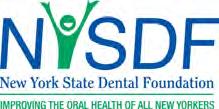
PLEDGE YOUR SUPPORT TODAY
Fill out the pledge form by using the QR code below. Your name will be added to our internal directory of Dental Heroes.
We will spread the news about New York's Salute Vets with a Smile program and connect Veterans in need with a Dental Hero in their area.
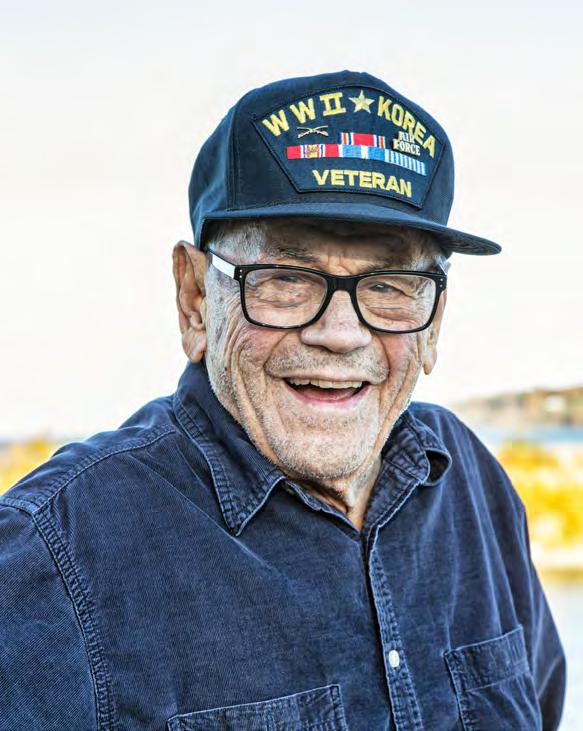
Free toothbrushes and up to $500 in funding for supplies will be provided to any components wishing to organize an additional Veterans event in their district.
"85%, or about 7.8 million veterans enrolled in the Veterans Affairs health care system, are ineligible for VA dental benefits... in order to qualify for dental services, Veterans must either have a dental issue that is service-connected or qualify based on narrow criteria."
Read, Learn and Earn
Readers of The New York State Dental Journal are invited to earn three (3) home study credits, approved by the New York State Dental Foundation, by properly answering 30 True or False questions, all of which are based on articles that appear in this issue.


To complete the questionnaire, log onto the site provided below. All of those who achieve a passing grade of at least 70% will receive verification of completion. Credits will automatically be added to the CE Registry for NYSDA members.
For a complete listing of online lectures and home study CE courses sponsored by the New York State Dental Foundation, visit www.nysdentalfoundation.org
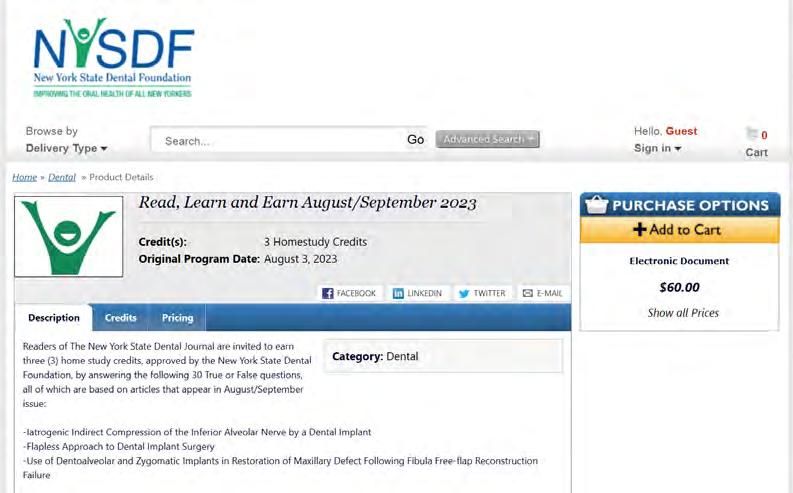
Iatrogenic Indirect Compression of the Inferior
Alveolar Nerve by a Dental Implant—Page 26-31
1. The inferior alveolar nerve (IAN) compression symptoms did not resolve in the clinical case.

Visit
Use of Dentoalveolar and Zygomatic Implants in Restoration of Maxillary Defect Following Fibula
Free-flap Reconstruction Failure—Page 32-37
1. Dysphagia can be a functional complication of oral cancer resection.
Visit
Flapless Approach to Dental Implant Surgery—Page 38-42
1. A flapless approach to implant surgery is emerging as a viable alternative.
continuing education
o T or o F
o T or o F
T or o F
o
our online portal for more....
our online portal for more....
our online portal for more.... ONLINE CE QUIZ Click below 62 AUGUST/SEPTEMBER 2023 The New York State Dental Journal
Visit
FOR SALE
WATERTOWN: General dental practice for sale. Grossing approximately $1.1M. Located north of Syracuse in Watertown, close to Thousand Islands. Practice has 9 operatories with digital X-ray, CBCT, 3D printing and CEREC. Real estate also available. For more information, please contact Sean Hudson by phone: (585) 690-6858; or email: sean@hudsontransitions.com.
CENTRAL WESTCHESTER COUNTY: Established general practice for sale within co-op apartment of 950 square feet; both practice and real estate for sale. Ground-level, facing major road with street parking. Growing city with thousands of new apartments under construction; near RR and major roads. Two ops with room for possible third. Mostly FFS with limited insurance. Gross $445K with high net. Apartment has kitchen and bathroom and zoned legal to live in. Asking 80% of net and $265K for apartment. Inquiries to: mollync2022@gmail.com.
ORANGE COUNTY: Great opportunity to own your own dental practice. Owner retiring from 2-dentist flourishing general practice established in 1973. Looking for someone to take over busy practice. Supporting associate, hygienists and front desk staff willing to remain. Associate has been with practice over 40 years and also thinking of retiring in near future. Front desk staff have been with practice nearly 20 years. Practice previously supported two full-time dentists and has excellent hygiene program. Quality PPO practice now treating 4th generation family members. Great opportunity for right individual. Easy access location, 1 mile from Route 17 and Interstate 84. Located in high-growth area with plenty of parking at standalone office on very visible highway. Inquiries to: (845) 692-5311; or email: wecatertocowards1@frontier.com.
BRONX: Architecturally designed, beautiful dental office for sale. Well set up and very high potential in heavily populated area of working-class community. Call (718) 379-4800; leave message.
CAPITAL DISTRICT: Located on main road with ample onsite parking. Thoroughly modern with Dentrix software, 3 Shape Trios scanner, digital X-rays with Scan X. Open three days/week. Great for satellite practice or to grow. Four-chair office: two hygiene and two fully equipped ops for dentist. Post-COVID headed toward $600K gross. Busy hygiene schedule. Building can be part of package deal. Contact by email: drdave329@gmail.com; or (518) 428-1492.
BERKSHIRES: Lee, MA. Small town practice in cultural Berkshires of Western, MA. Large, 3,900-square-foot office with 6 ops. Great staff, mostly all cross-trained. 9 hygiene days/week; respectable doctor production. Owner made good living in great space surrounded by great people. Patients always treated with dignity, fairness and excellent dentistry. If this is your goal then an equitable exchange of practice price for value can be reached. Seeking the right dentist(s) to take care of my team and my patients in coming years. Practice price to be determined by how we mutually fit. If this scenario meets your interests and you seek to acquire fully FFS practice in beautiful area, please contact. Email: holly@drjaywisedds.com; or call (413) 243-1222.
Online Rates for 60-day posting of 150 words or less — can include photos/images online: Members: $200. Non-Members: $300. Corporate/Business Ads: $400. Classifieds will also appear in print during months when Journal is mailed: Jan and July.
ALBANY AREA: General practice for sale. FFS practice producing $675K on 4 days. Very modern, 4-op dental office with sound patient base. Low overhead allows for maximum profitability. Excellent home values and school systems throughout area. No buyer fees. Please contact Dr. Mike by email: dkny1964@rocketmail.com; or call (917) 670-0191.
MANHATTAN: Dental office for sale at 30 Central Park South. Renovated dental condo overlooking Central Park. Includes 4 operatories, private office, reception area, waiting room and one bathroom. Move-in condition; fully equipped with dental chairs, X-ray equipment, cabinets and some furniture. A+ building; prime location; 24-hour doorman. Please contact Randi Brown for more information by phone: (201) 615-0763; or by email: randibrown18@gmail.com.
SYRACUSE SUBURBS: General practice conveniently located off main road in Liverpool. Open 2.5 days/week with 4 days of hygiene. Healthy patient base, with 50% commercial insurance, 20% self-pay and 30% state insurance. Located in small medical building with 4 ops in second-floor rental space with plenty of parking. Grossing $608K with room to grow with help of longstanding staff. For details contact Henry Schein Dental Practice Transitions Consultant Donna Bambrick at (315) 430-0643; or email: donna.bambrick@henryschein.com. #NY291.
TOMPKINS COUNTY: Well-established, high-quality general practice available to transition to new owner or seller can stay as part of team. Located in Ithaca suburb, this beautiful standalone, 15-year-old building of 2,544 square feet has five ops, digital X-rays, utilizes Eaglesoft software and completely paperless. Revenue over $700K. One FT and one PT Hygienist. Real estate also for sale. Growing patient base; practice draws increasing number of new patients with strong mixture of FFS. Great opportunity with doctor willing to stay on as part-time associate. For details contact Dental Practice Transitions Consultant Donna Bambrick by email: donna.bambrick@henryschein.com; or call (315) 430-0643. #NY3071.
ORANGE COUNTY: GP office currently staffed by full-time veteran associate. Minutes from main highway and features 5 ops, 2,000 square feet utilizing Dentrix software, intraoral camera and imaging system. Grossing $630K. 80% PPO insurances and 20% FFS. For information contact Dental Practice Transitions Consultant Mike Apalucci at (718) 213-9386; or email: michael.apalucci@ henryschein.com. #NY3088.
UPSTATE: Nestled in great family village community. Make offer for well-established Central New York general family practice close to main highways. Located near one of Top 100 Ranked Golf Courses by GolfWeek. 2021 gross col-
lections $544K. Standalone, 1,800-square-foot building for sale with practice purchase. Great curb appeal, with large parking lot. 3 treatment rooms and space to add on. Refers out specialties. Practice utilizes Dexis digital X-ray, digital panoramic X-ray, brand new patient chairs. High-profit margins. Healthy new patient flow. Contact Dental Practice Transition Consultant Michael Damon at (315) 430-9224; or email: mike.damon@henryschein.com. #NY3235
ROCHESTER: Family general practice in beautiful suburb with 2021 revenue of $255K+ and growth potential. Seller highly motivated. 1,400-square-foot space with affordable lease, great curb appeal and ample parking. 3 ops with potential 4th plumbed op. Single-doctor practice utilizes digital pano X-ray and Denoptix phosphor plates. Contact Dental Practice Transition Consultant Michael Damon at (315) 430-9224; or email: mike. damon@henryschein.com. #NY3291.
KINGSTON: 3 ops with Carestream software, digital sensors, digital scanner, CEREC mill and pan/ceph with phosphor plates. Doctor refers out most endo, all implant placements and perio. Great staff, including one highly trained in Sleep Study. Building on large lot also for sale. Rental apartments in building bring in extra income. For more information contact Dental Practice Transitions Consultant Chris Regnier at (631) 766-4501; or email: chris.regnier@henryschien.com. #NY3327.
ERIE COUNTY: Great practice with 3 treatment rooms. All digital, with collections of $413K. For details contact Dental Practice Transitions Consultant Brian Whalen at (716) 913-2632; or email: brian.whalen@henryschein.com. #NY3366.
QUEENS: Nassau County border. Terrific family-oriented practice for sale. Highly desirable neighborhood of Floral Park, Queens. Located in freestanding building with 1,250 square feet. 3 fully equipped treatment rooms with digital X-rays and utilizing Easy Dental software. Building handicap-accessible and offers easy street parking. Diagnostic, preventive and restorative practice with strong hygiene program. Seller owns building and will provide buyer-friendly lease. Contact Dental Practice Transitions Consultant Mike Apalucci at (718) 213-9386; or email: michael.apalucci@ henryschein.com. #NY3370.
ERIE COUNTY: Located on busy road surrounded by established residential population and beautiful town. 3-operatory digital practice, well-positioned for future growth with $307K gross revenue. Crown & bridge, restorative and preventative focus. Some specialties referred out. Strong patient base and mixed PPO. Real estate next to practice owned by the seller and for sale with practice. To discuss details, contact Dental Practice Transitions Consultant Brian Whalen at (716) 913-2632; or email: brian.whalen@henryschein.com. #NY1648
SUFFOLK COUNTY: Mature private general practice at desirable suburban downtown village location. Open 26-30 hours/ week. 3 operatories in 1,000 square feet. Selling dentist referring out all specialty services. For details contact Dental Practice Transitions Consultant Michael Apalucci at (718) 213-9386; or email: michael.apalucci@henryschein.com. #NY280
CLASSIFIEDS CLASSIFIED I N F O R M A T I O N
The New York State Dental Journal ● AUGUST/SEPTEMBER 2023 63
JEFFERSON COUNTY: Great opportunity. Longestablished, profitable practice is a must-see. Located minutes from downtown Watertown. Well-equipped 4-operatory practice sits on busy road with great curbside appeal. Large private parking lot. Practice fully digital with pano X-ray and utilizes Eaglesoft. Revenue $730K with one FT Hygienist. Doctor only works 3 days per week (20 hours max). Seller refers out all endo, ortho and oral surgery. Practice positioned for growth. Primarily FFS with 2,000 active patients. 2-story building also for sale with vacant apartments upstairs. Contact Dental Practice Transitions Consultant Michael Damon at (315) 430-9224; or email: mike.damon@henryschein.com. #NY3385
NASSAU COUNTY: Fee-for-service dental practice. 5 fully equipped treatment rooms and approximately 2,100 square feet. 95% FFS and 5% PPO insurances. Generates all revenue in only two days/week. Practice equipped with Dentrix software, ADec dental chairs and digital pan and sensors. For more information contact Dental Practice Transitions Consultant Chris Regnier at (631) 766-4501; or email: chris.regnier@henryschien.com. #NY3392
ONTARIO COUNTY: Long-established, highly productive practice with 2022 revenue of $1.4M. Nestled in backdrop of beautiful Finger Lakes winemaking country. Fully computerized, fully digital office with 7 well-equipped treatment rooms. Utilizes Dentrix Ascend PMS; Planmeca CBCT and digital impressioning systems, added in recent years. 3,500 active patients and combination of insurance and FFS. Strong hygiene program. Well-trained team available for transition. For more contact Dental Practice Transitions Consultant Michael Damon at (315) 430-9224; or email: mike.damon@henryschein.com. #NY3395
ONONDAGA COUNTY: Great family general practice located in desirable suburb minutes from downtown Syracuse. Less than 5 miles from approved site of new major semiconductor plant, which will bring thousands of jobs. Seller motivated to sell immediately. Located on busy 4-lane road with ample free parking. Well-equipped with 4 ops, digital, Dexis sensors, Sirona 2D pano (upgradable to 3D) and Dentrix PMS. 2022 revenue $673K with mix of FFS and PPO. Favorable lease terms for 2,400-squarefoot space within professional building. Currently open 26 hours/week. Selling dentist refers out most endo/ortho services. For details contact Dental Practice Transitions Consultant Michael Damon at (315) 430-9224; or email: mike.damon@henryschein.com. #NY3414
STEUBEN COUNTY: Beautiful, modern, established practice within standalone building with plenty of parking. Six operatories; fully digital, laser, intraoral cameras and N2O sedation driven by Practiceworks software. Active patients at 1,965, with mix of PPO and FFS. Building also available for purchase or lease. Outstanding turnkey opportunity with wonderful location for growth. To discuss details, contact Transitions Sales Consultant Brian Whalen at (716) 913-2632; or email: brian. whalen@henryschein.com. #NY3436
EASTERN LONG ISLAND: Well-established PPO/FFS dental practice chart sale. In practice for 17 years with over 779 active patients and averages 10-15 new patients monthly. For details contact Transition Sales Consultant Chris Regnier at (631) 766-4501; or email: chris.regnier@henryschein.com. #NY3437
SARATOGA COUNTY: Immaculate, well designed, private FFS practice collected just over $1.2M, with excellent profit margins and about 1,000 active patients. Digital, paperless, three well-equipped, updated operatories and one full-time hygienist. Utilizing 1,740 square feet in modern professional building. Refers out all endo, ortho, oral surgery and implants. Must see. Contact Transition Sales Consultant Mike Damon at (315) 430-9224; or email: mike.damon@henryschein.com. #NY3466
SUFFOLK COUNTY: Well-established general practice located in professional building that overlooks beautiful park and plenty of parking. Three fully equipped treatment rooms and open 4.5 days/week. Highly profitable with collections over $570K. Collections based on 50% FFS and 50% PPO insurance. Seller open to transition options. For details contact Transition Sales Consultant Chris Regnier at (631) 766-4501; or email: chris.regnier@henryschein.com. #NY3470
WESTCHESTER: Hot opportunity. Practice sits in professional building with multiple tenants. 1,200-square-foot office currently provides 3 treatment rooms and open 3.5 days/ week. Referring out ortho, perio and implant surgery, which can easily generate additional revenue. Gross receipts over $791K stemming from 70% FFS and 30% PPO, with consistent and stable patient base. Office boasts strong hygiene program, along with well-trained staff available for transition. Seller open to transition options. For details, contact Transition Sales Consultant Mike Apalucci at (718) 213-9386; or email: michael.apalucci@henryschein.com. #NY3487
UPSTATE NY: Long-established practice in diverse community halfway between Binghamton and Syracuse; situated just minutes from area hospital and college on busy 2-lane road with excellent street visibility. Three operatories in 3,000 square feet and room to expand. Real estate also available. Building includes a 2,000-square-foot rental apartment upstairs for great passive income. Three full-time employees, including one full-time hygienist. 75% FFS and 25% PPO. Refers out all endo, ortho and oral surgery offering great upside for new owner. 2022 gross collections $358K. Highly motivated seller. Contact Transition Sales Consultant Mike Damon at (315) 430-9224; or email: mike.damon@henryschein.com. #NY3488
WESTCHESTER COUNTY: Beautiful, 1,750-squarefoot general dental practice in professional building that overlooks Long Island Sound. Six fully equipped treatment rooms and open 6 days/week. Collections just over $1.3M, with over 2,200 patients and strong hygiene department. 55% FFS and 45% PPO insurance. For more details contact Transition Sales Consultant Chris Regnier at (631) 766-4501; or email: chris.regnier@henryschein.com. #NY3497
STATEN ISLAND: State-of-the-art general practice in highly desirable area. Doctor will provide 100% seller financing. 1,500 square feet in beautiful freestanding building with 5 fully equipped treatment rooms. Open Dental software, digital X-rays and paperless. 80% FFS and 20% PPO, with collections $624K in only 2.5 days/week. For more information, details contact Transition Sales Consultant Chris Regnier at (631) 766-4501; or email: chris.regnier@henryschein.com. #NY3562
ONEIDA COUNTY: Bright and immaculate all-digital 100% FFS practice with great curb appeal. Highly desirable location with convenient access to highways. $900K+ revenue on a 4-day workweek. Seller in practice for 30 years and committed
to aiding in very successful transition. Four well-equipped operatories and Dentrix, all in efficiently designed 1,100-squarefoot space. Thriving general practice averages 30+ new patients per month. Excellent turnkey opportunity. Contact Transitions Sale Consultant Mike Damon at (315) 430-9224or email: mike.damon@henryschein.com. #NY3513
ALBANY COUNTY: Bethlehem. Growing community close to downtown Albany on bus line, near major highways leading to NYC. Modern-feel office with four ops, Dentrix Ascend, Dexis, Pan, Diode laser and more. 2 fulltime Hygienists, along with valued team, working 4-days/ week with systems in place and excellent collection policies. No HMOs or State Insurance. Excellent opportunity for NY dental entrepreneur. For details contact Transition Sales Consultant Michael Damon at (315) 430-9224; or email: mike.damon@henryschein.com. #NY2712
FINGER LAKES REGION: Wonderful opportunity in heart of Cayuga County. Long-established practice with 2022 collections of $565K. Located on busy street. 5 equipped operatories, easily expandable in 1,350-square-foot space. Beautiful, spacious home of 3,350 square feet off rear of practice provides great tax advantages. Seller willing to lease or sell building. Active patients reached 5,500 in less than 3 years. Dedicated, full-time staff willing to stay on. Seller motivated to sell. Newly reduced: asking $100K for practice. Contact Transition Sales Consultant Michael Damon at (315) 430-9224; or email: mike.damon@henryschein.com. #NY3147
SENECA COUNTY: Charming practice in heart of Finger Lakes region; 45-minute drive to both Rochester and Syracuse city centers. Digital practice offering 3 equipped ops with 2022 revenue of $653K on 3 clinical days/week. Softdent, 2D pano and diode laser. 1,700-square-foot practice offers comprehensive dental care in welcoming environment. Full-time hygienist and full administrative staff, all with excellent systems and training in place. 50% FFS. Refers out specialties. Real estate also available. Schedule to see this wonderful opportunity today. Contact Transition Sales Consultant Michael Damon at (315) 430-9224; or email: mike.damon@henryschein.com. #NY3572
CLASSIFIEDS Abyde 8 Buffalo Niagara Dental Meeting 45 Choice Transitions 43 DDSMatch 12 Epstein 31 GNYDM 9 iCore 5 MLMIC Cover II NSS 23& 41 NYSSOMS Cover IV O’Connell & Aronowitz Cover III Smilist 35 UB 10 Utica Dental Lab 11 INDEX TO ADVERTISERS
64 AUGUST/SEPTEMBER 2023 ● The New York State Dental Journal
FOR RENT
MIDTOWN MANHATTAN: Newly decorated office with windowed operatory for rent FT/PT. Pelton Crane equipment, massage chair, front desk space available; shared private office, concierge, congenial environment. Best location on 46th Street between Madison and 5th Avenue. Please call or email: (212) 371-1999; karenjtj@aol.com.
MANHATTAN: Central Park South. Two dental operatories for lease in 4-op oral surgery practice with windows facing Central Park in exclusive medical condominium building. Front desk for two, waiting area, laboratory and bathroom. Option to transition to ownership. Work in pristine office in prime location. Tremendous growth potential. Inquiries by email: nycentralparksouth@gmail.com.
WHITE PLAINS: Modern, state-of-the-art operatories available in large office with reception. Available FT/PT. Turnkey. Rent includes digital radiology with pan, equipment, Nitrous, all disposables. Start-up or phase down. Need a satellite or more space? Upgrade or downsize. Contact us at (914) 290-6545; or email: broadwayda@gmail.com.
UPPER EAST SIDE: Operatory for rent in UES office (Madison Ave & 60th). Modern, quiet, boutique private practice. Endodontic microscope, 2 digital scanners, materials, instruments available for rent. Inquiries by text or email: (646) 648-3242 or pyondds@gmail.com.
MIDTOWN MANHATTAN: Madison Avenue next to worldrenowned St. Patrick’s Cathedral. Beautiful, large, renovated office with in-house full-service dental lab. Shared front desk space, shared private doctors’ office. Fully equipped with CS-9600 CBCT scanner. Large conference room with presentation dual TV/monitor. Please contact doctor directly at (646) 265-7949.
MIDTOWN MANHATTAN: 3 dental operatories for rent full time. Renovated, large, bright, modern dental operatories with windows available on Madison Avenue in Midtown Manhattan with full service in-house lab. Fully equipped with CS-9600 CBCT scanner and X-ray system. Shared front desk, private Doctor’s office, as well as large conference room. Please contact doctor directly at (646) 265-7949; or email: office@madisonavenuesmiles.com.
PUTNAM COUNTY: Mahopac. 3-op office available for lease takeover with option for new equipment and existing patients if desired. Office recently renovated during pandemic and looks beautiful. Current lease $1,500/ month through Oct 31, 2023, and then $1,700/month through Oct 31, 2026. Current dentist relocating out of state. Inquiries by email: asantostefanodds@gmail.com.
BROOKLYN: Manhattan Beach. Turnkey, fully equipped dental office available for sale or rent. 2 fully equipped ops in beautiful, upscale co-op building facing the water in Manhattan Beach. 35-year-old established practice. 70% high-end PPOs and 30% FFS with original phone number and website available. Active patient charts and large amount of supplies will be included with purchase or lease. Private doctor’s office, lab, storage closet and beautiful waiting room. Lobby level with exterior signage. Only office in building. Available immediately. Lease/Rent with option to purchase or purchase. No fees. Offered by owner. Contact by email: filmrn@aol.com; or call (516) 527-2343.
OPPORTUNITIES AVAILABLE
STONY BROOK: Job opportunity at Stony Brook School of Dental Medicine. The Department of Orthodontics & Pediatric Dentistry is seeking part-time, non-tenure-track Clinical Assistant Professor. Incumbent will be involved in Department’s clinical and academic activities at both the predoctoral and postdoctoral levels and supervision of resident research projects and activities. Candidates must have DDS or DMD (from CODA-accredited institution) or equivalent foreign degree, completed 2-3-year CODA-accredited advanced specialty education program in Orthodontics, NYS license and be ABO Board certified or eligible. More details can be found at: https://apply.interfolio.com/125341. Contact: Emmy Yan by email: emmy.yan@stonybrookmedicine.edu.
MIDTOWN MANHATTAN: If you have small practice and want to grow it stress-free without any rent, overhead or staffing issues, then send your CV so we can have conversation. 60th Street between Madison/Park Ave. Opportunity to become part of progressive practice in beautiful, relaxed office. There are NO excess patients for you; strictly chance to grow your practice using our facility, well-trained staff, organized business systems and over 35 years experience to mentor you. Two-doctor office looking for go-getter to build up and buy into equity position. Inquiries to: drk@nycsmilespa.com.
HUDSON: Associate dentist position available full time. Booming upper Hudson Valley river town. 6 operatories for 2 doctors and 2 hygienists. Retiring dentist will provide great opportunity for new associate to quickly build upon already solid patient base. Abundant new patient flow and hygiene booked for months. Potential for equity position or future buy-out. Applicant must have gentle, kind disposition; excellent communication skills with patients; and be able to perform high-quality dentistry. Send resume to: karenron94@yahoo.com.
BUFFALO: Periodontal and Implant Specialty office in Buffalo area adding full-time Periodontist. Office equipped with state-of-the-art digital equipment with dependable referral base. With strong marketing program in place, we are looking for someone who has experience, friendly and engaging personality and good long-term fit with other doctors. Our single-doctor-owned FFS practice averages 85 new patients monthly with gross production of $2.5M. Starting 2-4 days/week. Requirements include residency and NYS license with experience recommended. Benefits: health insurance, one work location. High-producing, excellent internal referral system and modern office with well-trained staff and state-of-the-art equipment, including CBCT, TRIOS Scanner, PRF, 3D printer, Schick 33 series, Chrome Guides. Offering IV conscious sedation; 300 implants placed in 2022. Contact Julie Rustowicz to arrange interview. Phone: (716) 626-4427; or email: info@thecornerstonedentist. com. Visit us online at: www.thecornerstonedentist.com.
BAY RIDGE, BROOKLYN: Seeking part-time general dental associate with experience. Must possess excellent clinical, plus communication skills. Proficiency in all aspects of general dentistry. Must be team player and self-starter. State-of-the-art facility. Must be able to work Saturdays and Thursdays. Please call (347) 487-4888; or email: Studiodntl@gmail.com.
WESTCHESTER COUNTY: Pound Ridge. Seeking boardcertified pediatric dentist 2 days/month. Lovely town with need for pediatric dentist. No specialist nearby. Fee-forservice practice participates in Delta and Cigna. New office with brand new pedo treatment room. Assistants supplied; great team and very upbeat practice. Lots of potential for growth compensation to be discussed. Seeking hard-working, focused team player with positive attitude and passion for your career and excited to grow the pedo practice. Comfortable in boutique practice and speaking with parents. Requires good communication skills and knowledge of newest, best practices in pedo and prevention. Visit us online at: www.poundridgecosmeticdentistry.com. Please send CV to: cosmetic914@gmail.com; or call (617) 462-0200.
MIDTOWN MANHATTAN: Park Avenue. Times have changed, let us help. Turnkey environment available for managing your practice. Looking for GP or Specialist who has their own patients but would like to have worry-free business. If you are looking to become associate or wind down but remain engaged, vital and active, this is extraordinary opportunity. Private practice or insurance-based, we invite you to join our team and work full or part time. Office provides beautiful and healthy environment with all current PPE ensuring the comfort of you and your patients, including experienced team for support. Rental space also available. All inquiries, please email: mssds33@yahoo.com.
ALBANY AREA: Are you an awesome dentist who loves working with teenagers? If so, come join The Smile Lodge Pediatric Dentistry. Our general dentists see our older kids and have busy operative schedule. We believe that every child deserves to smile, and we are looking to add to our team of like-minded practitioners. Right candidate can earn $3,000+ daily with base rate of $1,250/day. Candidate will obtain experience treating wide range of restorative procedures, including composites, extractions, stainless steel crowns, etc. Office has available shifts Monday-Friday (7 a.m.-5:30 p.m.) with ability to work 1-4 days/week. Immediate openings at both our beautiful locations in Clifton Park and East Greenbush. Benefits include health insurance ($1,000/month); vision and dental insurance; 401k; PTO and up to 6 weeks unpaid vacation. Please email CV to: Careers@smilelodge.com.
ROCHESTER: Seeking associate. Come to Rochester. Busy Brighton family dental practice in need of associate, preferably full time, with opportunity to lead to partnership. Conebeam Panorex, Planmeca same-day crowns, all digital radiographs. 8 ops, 4 dentists, 4 hygienists. Visit us online at: www.DrRandyDDS.com. Please send CV to: rgrdds@ rochester.rr.com.
WESTCHESTER COUNTY: Seeking full-time associate dentist for private practice in Pound Ridge. 4 days/week plus Saturdays. Candidate must have excellent communication skills and be comfortable in private practice environment. Please submit resume and references via email: admin@poundridgecosmeticdentistry.com.
CLASSIFIEDS
The New York State Dental Journal ● AUGUST/SEPTEMBER 2023 65
Promoting Lifelong Learning
NYSDA and Foundation Salute CE Achievers
THE NEW YORK STATE DENTAL ASSOCIATION embraces lifelong learning as vital to staying current in the ever-evolving dental profession. Notably, NYSDA was the first professional organization in New York State to mandate a requisite number of continuing education (CE) credits for relicensure.
Administered by the New York State Dental Foundation, the NYSDA Continuing Education (CE) Registry tallies the CE hours amassed by its members annually. In 2022, standout performers included Carla Schlissel from the Suffolk County Dental Society, boasting an impressive 3,500 hours, and Michael Beck from the Second District Dental Society, with an admirable 3,000 hours.
NYSDA further acknowledges members achieving CE milestones, recognizing those who earn 100, 300, 500, 1,000 and each
3,500
Carla Schlissel Suffolk County
3,000
Michael Beck Second District
2,500
Marc Beshar New York County
Glen Donnarumma Eighth District
Richard Rosenbloom Ninth District
Joseph DeLapa Ninth District
Joseph Arcuri Ninth District
John Chicvak Nassau County
2,000
Randy Raetz Seventh District
Anthony Lafornara Eighth District
Michael Teitelbaum Ninth District
Anthony Pavone Ninth District
Stephen Silverstein Nassau County
Viren Jhaveri Queens County
Meredith Jaffe Suffolk County
Steven Lamberg Suffolk County
Kevin Henner Suffolk County
Robert Frankel Bronx County
Gregory Kennedy Suffolk County
1,500
Graziano Giglio New York County
Udo Schutte New York County
Fraya Karsh New York County
Eric Ploumis New York County
Gabriela Lee New York County
Frank Schepis Fifth District
Duraid Sahawneh Ninth District
Robert Horowitz Ninth District
Allen Avrutin Ninth District
Ashok Soni Ninth District
Peter Mychajliw Nassau County
Michael Shreck Nassau County
Mohammad Bhuyan Queens County
Deepak Bhagat Queens County
Bharati Bedi Suffolk County
William Friedel Suffolk County
subsequent 500 hours as recorded within the Registry. This year, the number of members appearing in each tier is as follows: 100 (92); 300 (69); 500 (105); 1,000 (42); 1,500 (16); 2,000 (11); 2,500 (6); 3,000 (1); and 3,500 (1). Each of these learned members will receive a certificate from NYSDA, presented by the awardee's local dental society.
Members can submit credits up to a year old by mailing certificates of course completion to NYSDA: Continuing Education, 20 Corporate Woods Blvd., Ste. 602, Albany, NY 12211, or by uploading certificates electronically via the NYSDA website, https://www.nysdental.org/ member-center/ce.
Congratulations to this year’s top achievers, listed below.
1,000
Stephen Dautel Fourth District
Bettina Pels-Wetzel Fourth District
James Condry Fourth District
Samuel Goodloe Eighth District
Sanil Nigalye Eighth District
Frank Barnashuk Eighth District
Mildred Irizarry Fifth District
Ronald Levin Nassau County
Neil Engel Nassau County
Gerard Menzies Nassau County
Henr y Chalfin New York County
Tatiana Perlroth New York County
Mark Gurin New York County
Gregory Hull New York County
Michael Ghalili New York County
Julie Connolly New York County
Cecilia Scheuerman .New York County
Michelle Mirsky New York County
Steven Cho New York County
Steven Stern Ninth District
Louis Colletti Ninth District
Kimberly Ferguson Ninth District
William Skiba Ninth District
Maria Jacome Ninth District
Leonard Chiat Ninth District
Nina Capretta Ninth District
Steven Konis Ninth District
Martin Greenberg Second District
Louis DeSantis Second District
Joseph Shainbaum Second District
Kenneth Stoler Suffolk County
Robert Branca Suffolk County
John Rose Suffolk County
Erica Kaplan Suffolk County
Michael DeSanti Third District
Stuart Fass Third District
Paul Lonstein Third District
Keith Margulis Bronx County
Paul Hertz Bronx County
Michael Lenchner Queens County
Tomas Capla Queens County
John Guerrieri Seventh District
66 AUGUST/SEPTEMBER 2023 • The New York State Dental Journal
Addendum
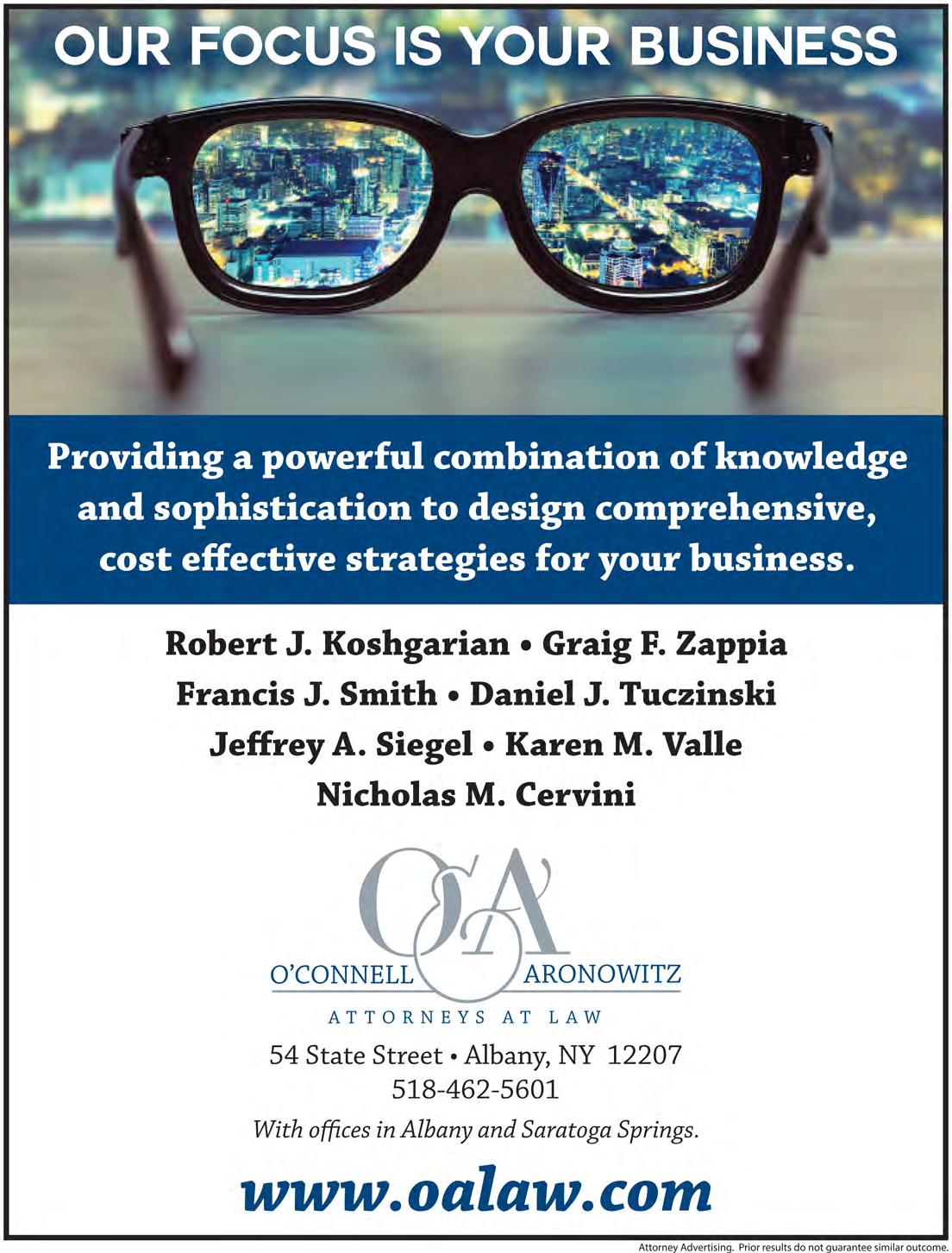
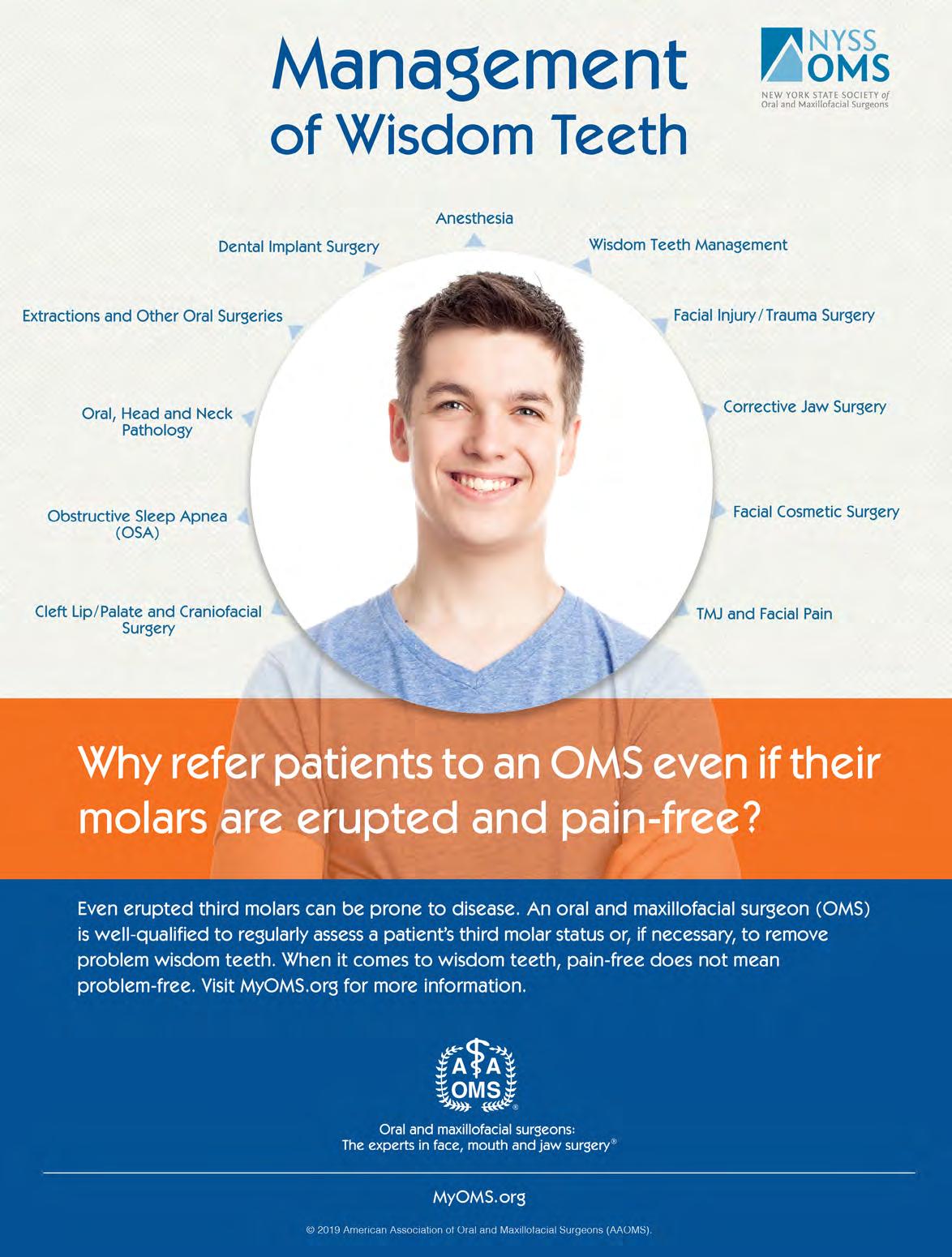





























 Brenda Turner, manager continuing education, checks guests in at registration table.
NYSDF Executive Director Stacy Mcllduff, left, and NYSDA President-Elect Prabha Krishnan welcome Tuoro Dental students and ASDA members Jordan Sahawneh and Vartkes Arakelian to June luncheon.
ASDA student Kristin Woo with her mentor sponsor, Ioanna Mentzelopoulou, New York County, and Kathryn Rothas, Third District.
Shailee Gupta, third from right, Texas Dental Association, and Duc Ho, at end, Greater Houston Dental Society, with Suffolk County members, from left, Guenter Jonke, Craig Smith, John Lagner, Martin Dominger, Paul Leary, Paul Markowitz.
Brenda Turner, manager continuing education, checks guests in at registration table.
NYSDF Executive Director Stacy Mcllduff, left, and NYSDA President-Elect Prabha Krishnan welcome Tuoro Dental students and ASDA members Jordan Sahawneh and Vartkes Arakelian to June luncheon.
ASDA student Kristin Woo with her mentor sponsor, Ioanna Mentzelopoulou, New York County, and Kathryn Rothas, Third District.
Shailee Gupta, third from right, Texas Dental Association, and Duc Ho, at end, Greater Houston Dental Society, with Suffolk County members, from left, Guenter Jonke, Craig Smith, John Lagner, Martin Dominger, Paul Leary, Paul Markowitz.





 Photos by Cindy Schultz
Photos by Cindy Schultz





























































 Figure 2. Locator-retained interim obturator #1 relined with Coe-Soft.
Figure 3a. Implant bar-retained interim obturator #2 relined with Rimseal-Intaglio Surface.
Figure 3b. Implant bar-retained interim obturator #2 relined with Rimseal-Intramural. Frontal view.
Figure 3c. First implant bar.
Figure 4. Master cast.
Figure 2. Locator-retained interim obturator #1 relined with Coe-Soft.
Figure 3a. Implant bar-retained interim obturator #2 relined with Rimseal-Intaglio Surface.
Figure 3b. Implant bar-retained interim obturator #2 relined with Rimseal-Intramural. Frontal view.
Figure 3c. First implant bar.
Figure 4. Master cast.







 Figure 5b. Digital rendering of bar with superimposed diagnostic wax up. Frontal view.
Figure 6a. Definitive implant bar. Occlusal view.
Figure 6b. Definitive implant bar. Frontal view.
Figure 9b. Definitive obturator. Occlusal surface.
Figure 7. Panoramic radiograph of definitive implant bar.
Figure 8. Definitive obturator. Intraoral frontal view.
Figure 9a. Definitive obturator. Intaglio surface.
Figure 5b. Digital rendering of bar with superimposed diagnostic wax up. Frontal view.
Figure 6a. Definitive implant bar. Occlusal view.
Figure 6b. Definitive implant bar. Frontal view.
Figure 9b. Definitive obturator. Occlusal surface.
Figure 7. Panoramic radiograph of definitive implant bar.
Figure 8. Definitive obturator. Intraoral frontal view.
Figure 9a. Definitive obturator. Intaglio surface.


 Figure 10. Patient smile.
Figure 10. Patient smile.
 Figure 1. Flapless implant placement at single edentulous area. (a) Clinical preoperatory photo of site 30. (b) Preoperatory bitewing radiograph. (c) 3 mm diameter disposable biopsy punch held parallel to long axis of adjacent teeth and pressure applied until underlying bone is felt. (d) Surgical curette was used to remove mucoperiosteal tissue. (e) Osteotomies prepared according to Straumann’s guidelines, starting a pilot drill. (f) 2.2 mm diameter drill followed by 2.8
Figure 1. Flapless implant placement at single edentulous area. (a) Clinical preoperatory photo of site 30. (b) Preoperatory bitewing radiograph. (c) 3 mm diameter disposable biopsy punch held parallel to long axis of adjacent teeth and pressure applied until underlying bone is felt. (d) Surgical curette was used to remove mucoperiosteal tissue. (e) Osteotomies prepared according to Straumann’s guidelines, starting a pilot drill. (f) 2.2 mm diameter drill followed by 2.8














 More than 130 volunteers turned out to help at April Give Kids A Smile event at LI Aquarium. Thanks to their efforts, nearly 200 children were seen by a dental professional.
Stony Brook residents were front and center at May General Membership Meeting. Attendees heard presentations from three young dentists.
Success of Golf Outing in June is due in large part to cadre of volunteers who pulled together to keep things running smoothly.
More than 130 volunteers turned out to help at April Give Kids A Smile event at LI Aquarium. Thanks to their efforts, nearly 200 children were seen by a dental professional.
Stony Brook residents were front and center at May General Membership Meeting. Attendees heard presentations from three young dentists.
Success of Golf Outing in June is due in large part to cadre of volunteers who pulled together to keep things running smoothly.













































